PCHAS_0831300 merozoite surface protein 1 (MSP1)
Disruptability [+]
| Species | Disruptability | Reference | Submitter | |
|---|---|---|---|---|
| P. berghei ANKA |
Refractory |
RMgm-326 | Imported from RMgmDB | |
| P. berghei ANKA |
Refractory |
PlasmoGEM (Barseq) | PlasmoGEM | |
| P. falciparum 3D7 |
Refractory |
22986493 | Theo Sanderson, Wellcome Trust Sanger Institute | |
| P. falciparum 3D7 |
Refractory |
USF piggyBac screen (Insert. mut.) | USF PiggyBac Screen | |
Mutant phenotypes [+]
| Species | Stage | Phenotype | Reference | Submitter |
|---|---|---|---|---|
| P. falciparum 3D7 | Asexual |
Egress defect |
26892670 | Theo Sanderson, Wellcome Trust Sanger Institute |
Imaging data (from Malaria Metabolic Pathways)
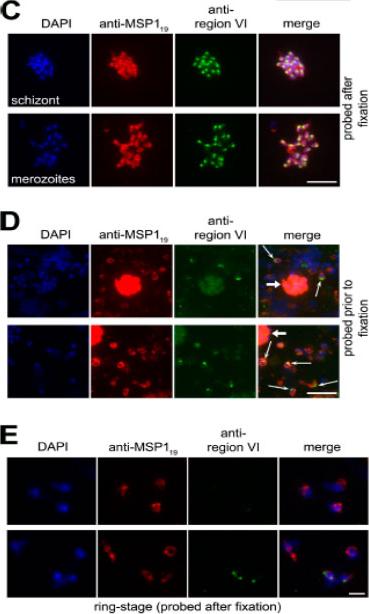
EBA-175 is shed at or around the point of erythrocyte invasion and retains region VI. (C) IFA images of an acetone-fixed segmented 3D7 schizont and free merozoites dual labeled after fixation with mAb 1E1 (anti-MSP119; red) and anti–region VI antibodies (green). The punctate, apical pattern obtained with the latter is typical of microneme staining. (D) EBA-175 is discharged onto the apical surface of free merozoites. Merozoites released from 3D7 schizonts in the presence of anti–region VI antibodies were washed, fixed, and probed with FITC anti-mouse IgG to detect bound anti–region VI antibodies (green), followed by mAb 1E1 (anti-MSP119; red). Many free merozoites exhibit a strong apical FITC signal (thin arrows), whereas residual intact schizonts containing merozoites that were not accessible to the anti–region VI antibodies show only background FITC labeling (thick arrows). No signal was associated with merozoites released in the presence of preimmune mouse antisera (unpublished data). (E) IFA images of newly invaded (≤3-h-old) ring-stage 3D7 parasites probed with anti–region VI antibodies after acetone fixation. Most rings did not react at all with the antibodies. Nuclei were stained with DAPI (blue). Bars, 5 μm.O'Donnell RA, Hackett F, Howell SA, Treeck M, Struck N, Krnajski Z, Withers-Martinez C, Gilberger TW, Blackman MJ. Intramembrane proteolysis mediates shedding of a key adhesin during erythrocyte invasion by the malaria parasite. J Cell Biol. 2006 174:1023-33.
See original on MMP
Indirect immunofluorescence images of P. falciparum schizonts stained with rabbit IgG (green) induced by 10 viral-vectored vaccines expressing malaria antigens, and negative control vectors lacking a malaria antigen. Nuclei are counterstained with 4,6-diamidino-2-phenylindole (blue). All sera were tested against 3D7 strain parasites, with the exception of anti-PfRH1 for which FVO strain parasites were used. All images to same scale as Giemsa stained image (top left, on which scale bar indicates 5 μm).Douglas AD, Williams AR, Illingworth JJ, Kamuyu G, Biswas S, Goodman AL, Wyllie DH, Crosnier C, Miura K, Wright GJ, Long CA, Osier FH, Marsh K, Turner AV, Hill AV, Draper SJ. The blood-stage malaria antigen PfRH5 is susceptible to vaccine-inducible cross-strain neutralizing antibody. Nat Commun. 2011 2:601.
See original on MMP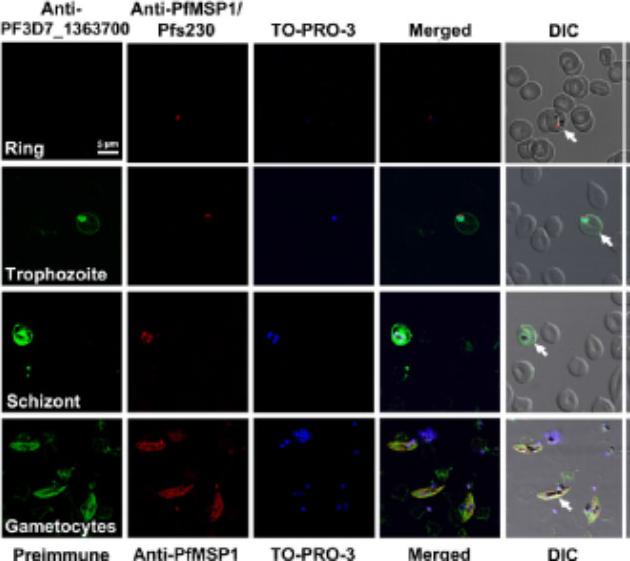
MAL13P1.319 protein appears to be present during late intra-erythrocytic stages as shown by immunolocalization studies using confocal microscopy. Parasite-infected blood smears were triple-labelled with anti-MAL13P1.319 polyclonal antibody (anti-MAL13P1.319), either anti-merozoite surface protein 1 (anti-PfMSP1) monoclonal antibody for asexual stages or anti-Pfs230 monoclonal antibody for gametocytes (used as positive controls), and a nuclear stain, TO-PRO-3. Triplicate biological replicates of parasite infected blood smears consistently show MAL13P1.319 expression during the trophozoite, schizont and gametocyte stages. Merged images with DIC demonstrate protein colocalization with known surface proteins as shown by the yellow colour. Approximately 100–300 stage-specific parasites/replicate were observed. The bottom panel of figures show the control pre-immune serum with minimal cross-reactivity in intra-erythrocytic stage parasites (ES). Arrows denote the presence of parasites and representative images are shown with a scale bar, 5 μm.Roberts RN, Schlarman MS, Kariuki MM, Lacrue AN, Ou R, Beerntsen BT. Expression profile of the plasmodium falciparum intra-erythrocytic stage protein, PF3D7_1363700. Malar J. 2013 Feb 19;12(1):66
See original on MMP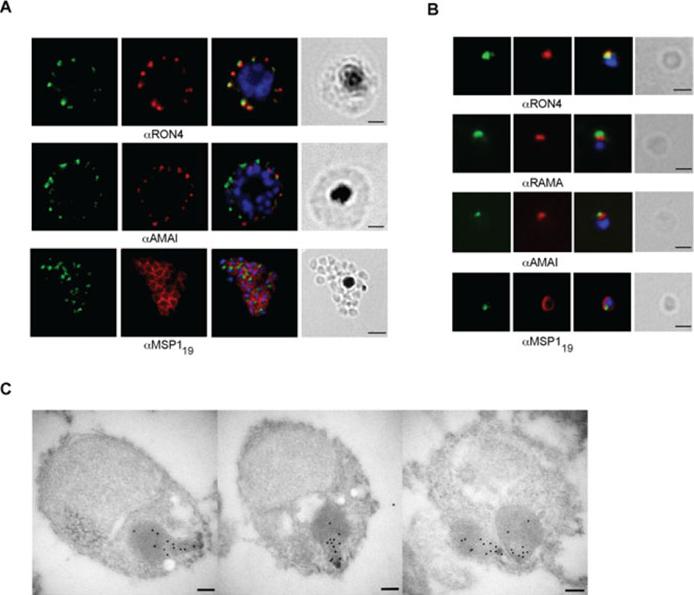
RON12 is located within the rhoptry neck.. A and B. Immunofluorescence and bright-field images of schizonts (A) and merozoites (B). Images from left to right show anti-RON12 labelling (green) followed by microneme (anti-AMA1), rhoptry (neck: anti-RON4; body: anti-RAMA) and surface (anti-MSP119) specific antibodies in red, overlay of both with DAPI-stained nuclei and the bright-field image. Size bars in (A) equal 2 μm and in (B) 1 μm. C. Immuno-electron microscopy of isolated merozoites. Localization of RON12 in the rhoptry neck of three different merozoites is shown. Size bars equal 100 nm.Knuepfer E, Suleyman O, Dluzewski AR, Straschil U, O'Keeffe AH, Ogun SA, Green JL, Grainger M, Tewari R, Holder AA. RON12, a novel Plasmodium-specific rhoptry neck protein important for parasite proliferation. Cell Microbiol. 2013 Aug 12. [Epub ahead of print]
See original on MMP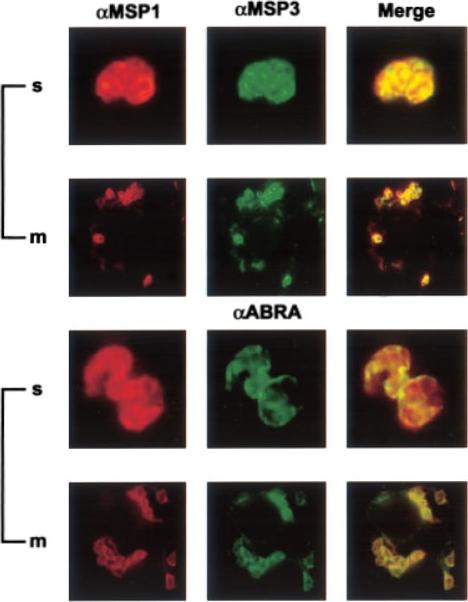
Subcellular localization of MSP3 and ABRA Smears of late schizonts (s) of anti-MSP1 (located on the surface of the merozoite (m)) and anti-MSP3 or anti-ABRA antibodies. Anti-MSP1 mouse antibodies were labeled with rhodamine-conjugated anti-mouse antibodies (red). Anti-MSP3 and anti-ABRA rabbit antibodies were labeled with anti-rabbit antibodies conjugated with FITC (green). Co-localization is shown in the row and indicated by yellow. D10 smears labeled with anti-MSP1 (first column) and anti-MSP-3 or anti-ABRA (second column). In late D10 schizonts, MSP-3, MSP-1 and ABRA had a localization consistent with the parasitophorous vacuole and the merozoite surface. Mills KE, Pearce JA, Crabb BS, Cowman AF. Truncation of merozoite surface protein 3 disrupts its trafficking and that of acidic-basic repeat protein to the surface of Plasmodium falciparum merozoites. Mol Microbiol. 2002 43:1401-1411. Copyright John Wiley & Sons Ltd. 2010.
See original on MMP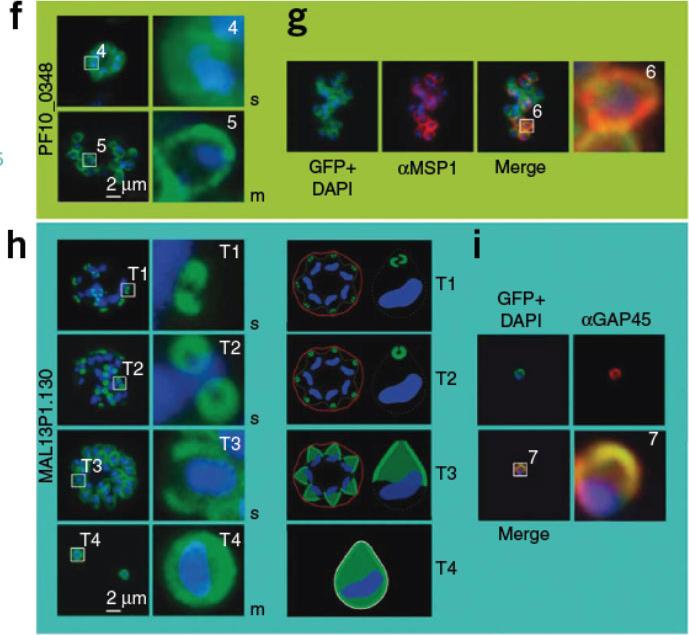
Boxed regions are numbered and depicted in higher magnification to the right. The nucleus is stained with DAPI (blue). f) PF10_0348-GFP (green) localized to the surface of schizonts and free merozoites in unfixed parasites. g) PF10_0348-GFP co-localized with the surface protein MSP-1 (red) in fixed parasites. Dynamics of MAL13P1.130-GFP (green) during schizogony in unfixed parasites. In early schizogony (T1), MAL13P1.130-GFP emerged as a cramp-like-structure at the apical tip of forming merozoites (h). This structure develops to be ring-like (T2) before becoming evenly distributed at the periphery of the nascent merozoite (T3-4). The third row shows a schematic representation. For confocal three-dimensional reconstitution,Hu G, Cabrera A, Kono M, Mok S, Chaal BK, Haase S, Engelberg K, Cheemadan S, Spielmann T, Preiser PR, Gilberger TW, Bozdech Z. Transcriptional profiling of growth perturbations of the human malaria parasite Plasmodium falciparum. Nature Biotechnol. 2010 28:91-8.
See original on MMP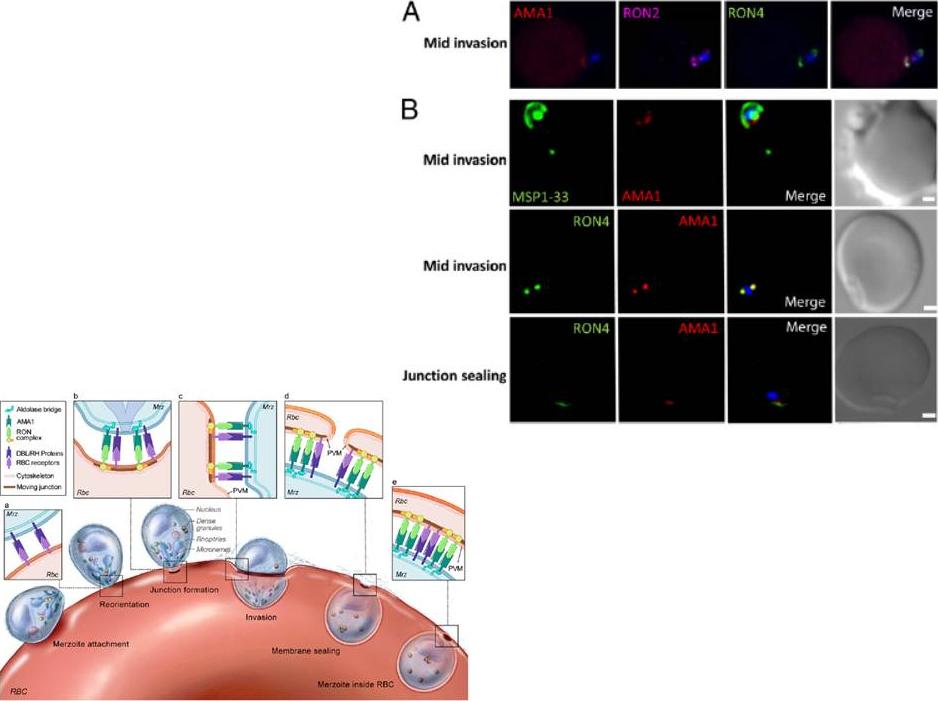
Localization of Pf AMA1, RON2, and RON4 at the moving junction of invading merozoites. Confocal microscopy images of merozoite invading RBC are shown. (A) Pf AMA1, RON2, and RON4 colocalize during invasion. (B) AMA1 is present at the moving junction (Top) with RON4 colocalizing with AMA1 at the junction (Middle). RON4 marks the sealing of the junction after invasion (Bottom). Scale bars represent 1μM.Schematic model of the steps involved in Pf merozoite (Mrz) invasion.Srinivasan P, Beatty WL, Diouf A, Herrera R, Ambroggio X, Moch JK, Tyler JS, Narum DL, Pierce SK, Boothroyd JC, Haynes JD, Miller LH. Binding of Plasmodium merozoite proteins RON2 and AMA1 triggers commitment to invasion. Proc Natl Acad Sci U S A. 2011 108(32):13275-80
See original on MMP
PFF0645c is released from the rhoptries only after completion of merozoite invasion. (A) IEM of PFF0645c-HA merozoites pre and post-erythrocyte invasion labeled with immunogold anti-HA (white arrows). Scale bar = 0.2 mm. (B) Widefield 3D imaging of PFF0645c-HA merozoites labeled with anti-HA, anti-PfRON4 and DAPI showing early, mid and late invasion events. Scale bar = 5 mm. 3D reconstruction with 0.2 mm grid intervals. (C) Widefield 3D imaging of PFF0645c-HA early rings (,10 min post-invasion) labeled with anti-HA, anti-PfRON4 (,PVM) anti-RAP1 (PV) or anti-MSP1 (plasma membrane) and DAPI. Scale bar = 5 mm. 3D reconstruction with 0.2 mm grid intervals.Zuccala ES, Gout AM, Dekiwadia C, Marapana DS, Angrisano F, Turnbull L, Riglar DT, Rogers KL, Whitchurch CB, Ralph SA, Speed TP, Baum J. Subcompartmentalisation of Proteins in the Rhoptries Correlates with Ordered Events of Erythrocyte Invasion by the Blood Stage Malaria Parasite. PLoS One. 2012;7(9):e46160.
See original on MMP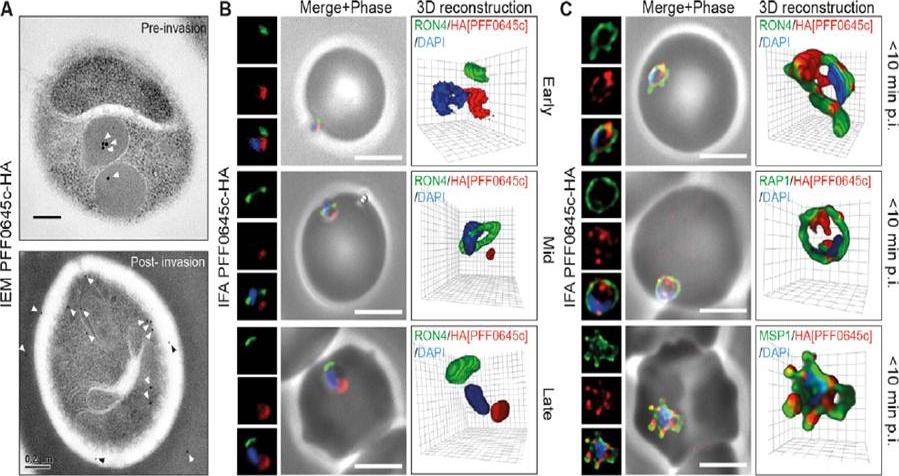
PFF0645c is released from the rhoptries only after completion of merozoite invasion. (A) IEM of PFF0645c-HA merozoites pre and post-erythrocyte invasion labeled with immunogold anti-HA (white arrows). Scale bar = 0.2 mm. (B) Widefield 3D imaging of PFF0645c-HA merozoites labeled with anti-HA, anti-PfRON4 and DAPI showing early, mid and late invasion events. Scale bar = 5 mm. 3D reconstruction with 0.2 mm grid intervals. (C) Widefield 3D imaging of PFF0645c-HA early rings (,10 min post-invasion) labeled with anti-HA, anti-PfRON4 (,PVM) anti-RAP1 (PV) or anti-MSP1 (plasma membrane) and DAPI. Scale bar = 5 mm. 3D reconstruction with 0.2 mm grid intervals.Zuccala ES, Gout AM, Dekiwadia C, Marapana DS, Angrisano F, Turnbull L, Riglar DT, Rogers KL, Whitchurch CB, Ralph SA, Speed TP, Baum J. Subcompartmentalisation of Proteins in the Rhoptries Correlates with Ordered Events of Erythrocyte Invasion by the Blood Stage Malaria Parasite. PLoS One. 2012;7(9):e46160.
See original on MMP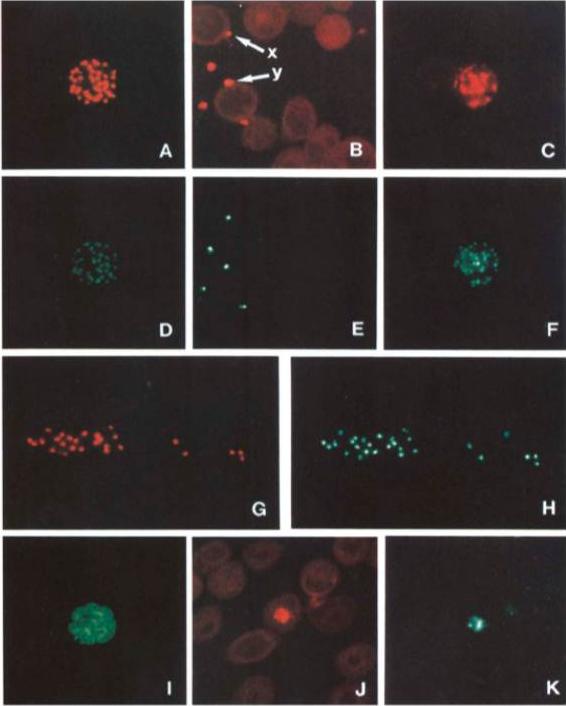
Single and dual immunofluorescent analysis of the subcellular localization of AMA-1, RAP-l and MSPl in mature schizonts, free merozoites, and ring stages of P. falciparum 7G8. Descriptors of the subcellular localization follow. Co-localized apical immunofluorescence of C-terminal AMA-1 and RAP-l in mature schizont, (A and D, respectively). Co-localized apical immunofluorescence of C-terminus-AMA-1 (x) and RAP-l in free merozoite, (B and E, respectively); surface localization of C-terminus-AMA-1 (y) and apical localization of RAP-l in free merozoite, (B and E, respectively). Co-localized apical immunofluorescence of N-termini-AMA-1 and RAP-l in mature schizont and free merozoite, (C, F and G, H, respectively). Surface localization of MSPl in mature schizont (I). Co-localization of C-terminus-AMA-1 and RAP-l in ring stage parasite, (J and K, respectively). Methanol-fixed schizont/ring stage thin films (ring development less than 3 h) were reacted with rat mAb IgG (25 pg ml-1), or rat mAb IgG and RAP-l culture supematant (dil. 15) in phosphate-buffered saline containing 1% foetal calf serum. Secondary stains were tetramethyl rhodamine isothiocyanate coupled or fluorescein isothiocyanate coupled anti-rat (A,B,C,G,J or I, respectively) and FITC coupled anti-mouse (human and rat adsorbed) (D,E,F,G and K).Narum DL, Thomas AW. Differential localization of full-length and processed forms of PF83/AMA-1 an apical membrane antigen of Plasmodium falciparum merozoites. Mol Biochem Parasitol. 1994 67:59-68. Copyright Elsevier 2009.
See original on MMP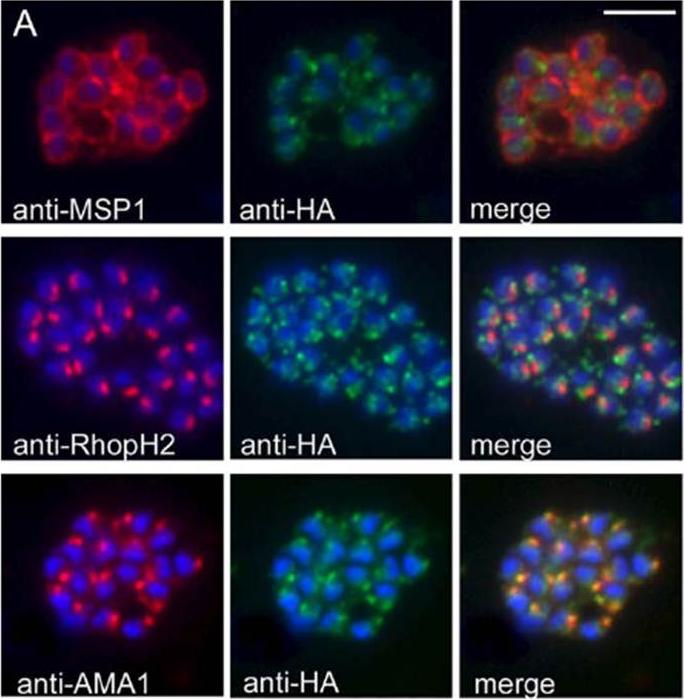
PfSUB2 Is a Microneme Protein. (A) IFA images of schizonts of PfSUB2HA clone 2D dual-labelled with mAbs X509 (anti-MSP1), 61.3 (anti-RhopH2), or 4G2 (anti-AMA1), plus in each case mAb 3F10 (anti-HA) The anti-HA signal co-localised only with the anti-AMA1 signal. Identical results were obtained with the uncloned transgenic PfSUB2HA line, and/or when anti-RAP2 mAb H5 was used as the rhoptry marker instead of mAb 61.3 (not shown). Parasite nuclei are stained throughout with DAPI (blue). Scale bar represents 2 lm.Harris PK, Yeoh S, Dluzewski AR, O'Donnell RA, Withers-Martinez C, Hackett F, Bannister LH, Mitchell GH, Blackman MJ. Molecular identification of a malaria merozoite surface sheddase. PLoS Pathog. 2005 1(3):241-51.
See original on MMP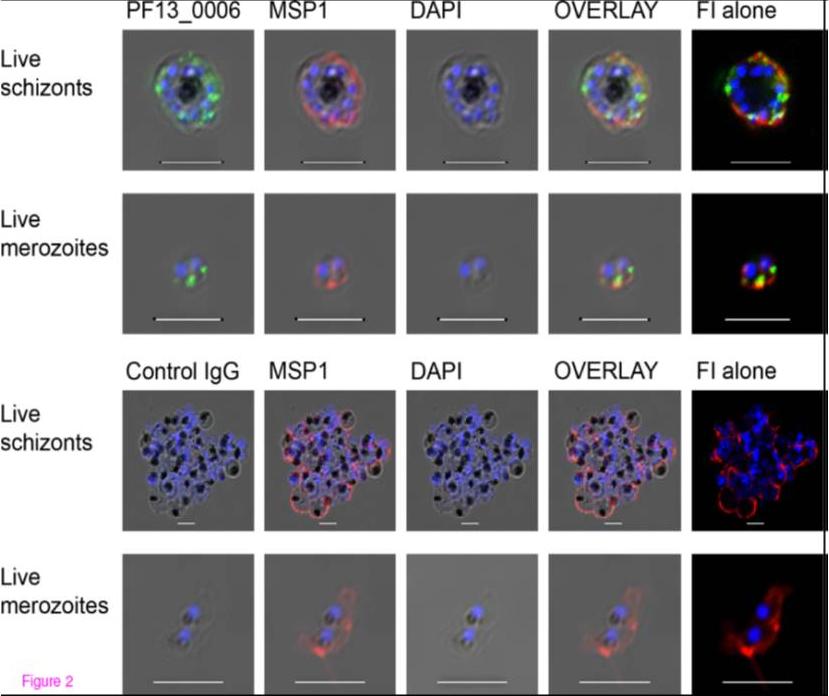
Immunofluorescence analysis of PF13_0006 expression in live asexual Plasmodium falciparum parasites. Live schizonts (first row) and merozoites (second row) of the 3D7 parasite line were analyzed by staining with anti-PF13_0006 IgG (green) and anti-MSP-1 Ab (red). As a control, live schizonts (third row) and live merozoites (fourth row) were stained with control IgG (green) and anti-MSP-1 Ab (Red). Nuclei were stained with DAPI (blue). DIC shadow-cast images with the fluorescence image superimposed in the first four coloumns and the fluorescence image (FI) alone in the last coloumn to augment the visualisation of the staining. Scale bar 5 mm. Abs stained the dividing merozoites inside the infected erythrocyte. Location of Rifin appeared to overlap with MSP-119.Mwakalinga SB, Wang CW, Bengtsson DC, Turner L, Dinko B, Lusingu JP, Arnot DE, Sutherland CJ, Theander TG, Lavstsen T. Expression of a type B RIFIN in Plasmodium falciparum merozoites and gametes. Malar J. 2012 Dec 21;11(1):429.
See original on MMP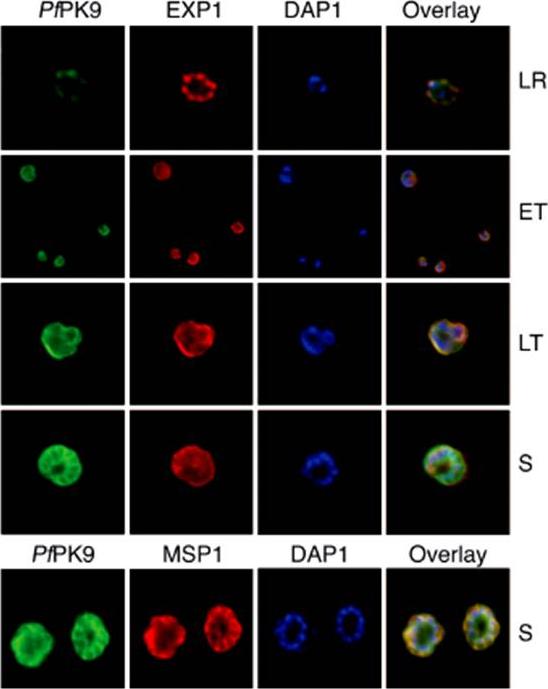
PfPK9 expression and localization across the intraerythrocytic life cycle. Immunofluorescence using polyclonal anti-PfPK9 antibody reveals a punctuate staining at late ring stage during which PfPK9 (green) appears to colocalize with exported protein 1 (red) in several spots. In addition to parasitophorous membrane staining (using EXP-1 PF11_0224 as PVM marker), diffused cytoplasmic staining is observed during both early and late trophozoites. During the schizont stage, the expression pattern emerges to be like merozoite surface protein 1 PFI1475w (red), a plasma membrane protein.Philip N, Haystead TA. Characterization of a UBC13 kinase in Plasmodium falciparum. Proc Natl Acad Sci U S A. 2007 104:7845-7850.
See original on MMP
Colocalization of PfMSRP-1 and PfMSRP-2 with P. falciparum MSP-1 as demonstrated by immunofluorescence of thin blood smears of asynchronous cultures. (a) Slides were incubated with a mouse anti-PfMSRP-1 serum and a fluorescein isothiocyanate-labeled rabbit anti-mouse IgG secondary antibody. (b and f) Slides were incubated with a guinea pig anti-Pf83a serum and a rhodamine-labeled donkey anti-guinea pig IgG secondary antibody. (c) Overlay of panels a and b. (d) Bright-field image of panels a, b, and c. (e) Slides were incubated with a mouse anti-PfMSRP-2 serum and a fluorescein isothiocyanate-labeled rabbit anti-mouse IgG secondary antibody. (g) Overlay of panels e and f. (h) Bright-field image of panels e, f, and g. PfMSRP-1 and PfMSRP-2 were localized to the membranes of trophozoites (a and e). This is similar to the pattern observed with the amino-terminal portion of PfMSP-1 (b and f).Mello K, Daly TM, Morrisey J, Vaidya AB, Long CA, Bergman LW. A multigene family that interacts with the amino terminus of plasmodium MSP-1 identified using the yeast two-hybrid system. Eukaryot Cell. 2002 1(6):915-25.
See original on MMP
The appearance of Plasmodium falciparum schizonts of the ITO4 line at different times of development. The time of sampling from invasion and the number of nuclei per schizont are indicated. Antibodies to proteins associated with invasion related organelles or the parasite periphery (rhoptries : RAP-1; micronemes: AMA-1, EBA-175; dense granules: RESA; parasite periphery: MSP-1, myo-A) were chosen to follow the development and assembly of merozoites in maturing schizonts.Margos G, Bannister LH, Dluzewski AR, Hopkins J, Williams IT, Mitchell GH. Correlation of structural development and differential expression of invasion-related molecules in schizonts of Plasmodium falciparum. Parasitology. 2004 129:273-87. Copyright Cambridge University Press Journals 2011
See original on MMP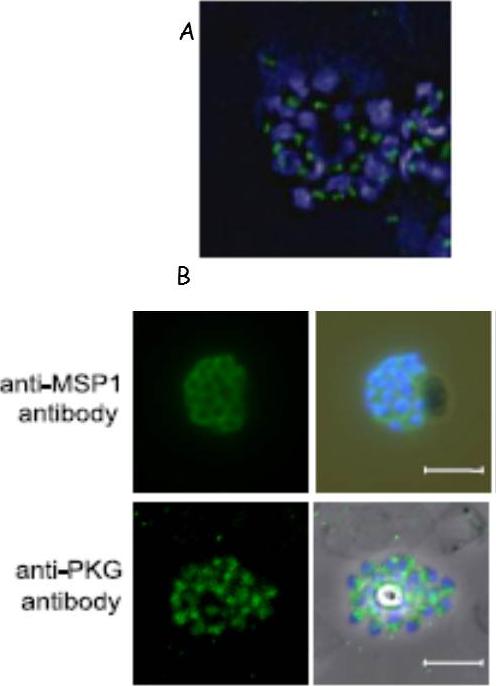
Fluorescence micrographs of schizonts. The primary antibody was a monoclonal antibody that reacts with the P. falciparum rhoptry neck protein PfRON4 (green). Nuclei were counterstained with 0.5 g/ml DAPI (blue). Scale bar, 5 mm. (B) Fluorescence micrographs of schizonts. The primary antibodies were a monoclonal antibody that reacts with P. falciparum MSP1 (top row) and a polyclonal antibody that reacts with PfPKG (bottom row) (both green). Nuclei were counterstained with 0.5 g/ml DAPI (blue). The staining pattern observed throughout the merozoites suggests a predominantly cytosolic localization.Taylor HM, McRobert L, Grainger M, Sicard A, Dluzewski AR, Hopp CS, Holder AA, Baker DA. The malaria parasite cyclic GMP-dependent protein kinase plays a central role in blood-stage schizogony. Eukaryot Cell. 2010 9:37-45.
See original on MMP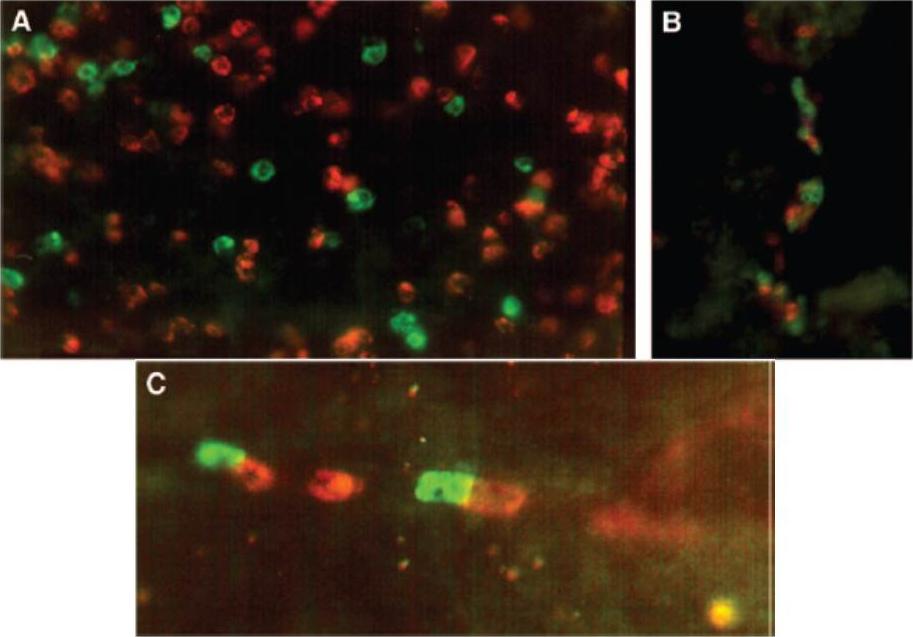
Detection of multiple-clone infections in blood and brain by double-labeled IFAT: MSP-1 serotypes of P. falciparum in peripheral blood and brain tissue of patient 13. (A and B) P. falciparum schizont-infected erythrocytes cultured from the peripheral blood (A) and homogenate from the frontal lobe of the brain (B) of the same child. A majority of schizonts (red) reacted with MSP-1 block 4-specific MAb 10-2B (immunoglobulin G2a) plus RITC-conjugated anti-immunoglobulin G2a. A minority of schizonts (green) were positive with MAb 12.1 (immunoglobulin G1) plus FITC-conjugated anti-immunoglobulin G1. The detectable serotypes or relative proportions of sequestered and circulating parasites did not differ. Magnification, 630. (C) Thin smear prepared from a supraorbital needle sample from patient SO, showing a mixed infection of two MSP-2 serotypes in a brain capillary. Some schizonts (red) reacted with MSP-2 group B-specific MAb 8G10/48 (immunoglobulin G2b) plus RITC conjugated anti-immunoglobulin G2b, whereas others (green) reacted with MSP-2 group A-specific MAb 12.3 (immunoglobulin G1) plus FITC-conjugated anti-immunoglobulin G1. Magnification, 630.Dobaño C, Rogerson SJ, Taylor TE, McBride JS, Molyneux ME. Expression of merozoite surface protein markers by Plasmodium falciparum-infected erythrocytes in peripheral blood and tissues of children with fatal malaria. Infect Immun. 2007 75:643-52.
See original on MMP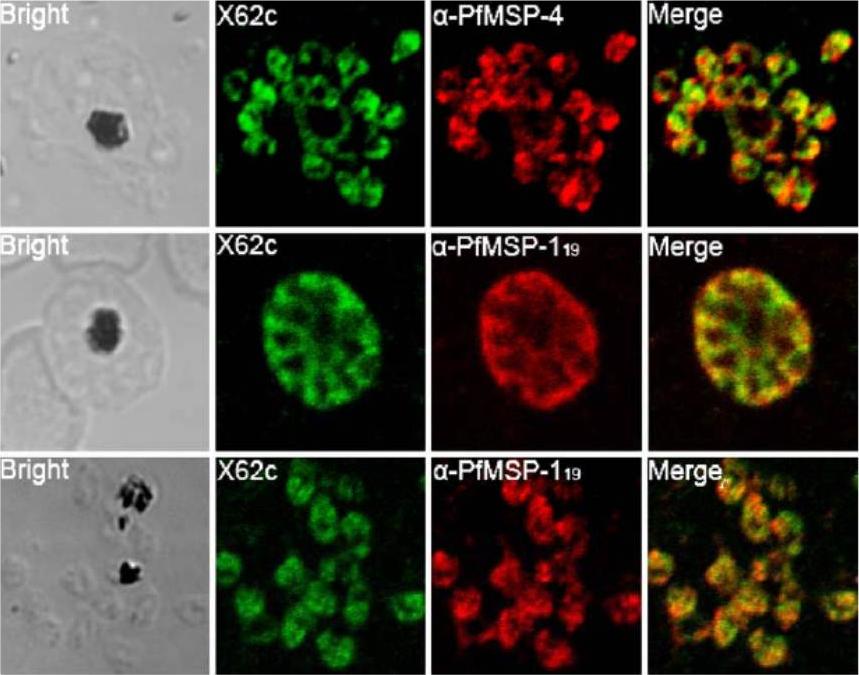
Co-localization of PfMAg-1 with PfMSP-4 or PfMSP-119 at late schizont/merozoite parasites examined by confocal fluorescent microscopy. PfMSP-119 is the 19-kDa C-terminal fragment of PfMSP-1 that remains membrane-bound on the invading merozoite Top: Merozoite detected with antibodies X62c (against PfMAg-1) and α-PfMSP-4. Middle: Mature schizont detected with antibodies X62c and α-PfMSP-119. Bottom: Merozoite detected with antibodies X62c and α-PfMSP-119. Bright field images are shown on the left panel. PfMSP-1 and PfMSP-4 are two of the major merozoite surface proteins characterized. Schizonts/merozoite of 3D7 strain, PfMAg-1 co-localized very well with PfMSP-119, and partially with PfMSP-4, in the typical bunch-of-grapes fluorescence pattern haracteristic of merozoite surface proteins.Gao YH, Li HL, Lu Y, Gao FM, Lin YH, Zhou HC, Zhang LH, Wang H. Identification of a vaccine candidate antigen, PfMAg-1, from Plasmodium falciparum with monoclonal antibody M26-32. Parasitol Res. 2009 105:1723-32. PMID: 19777263
See original on MMP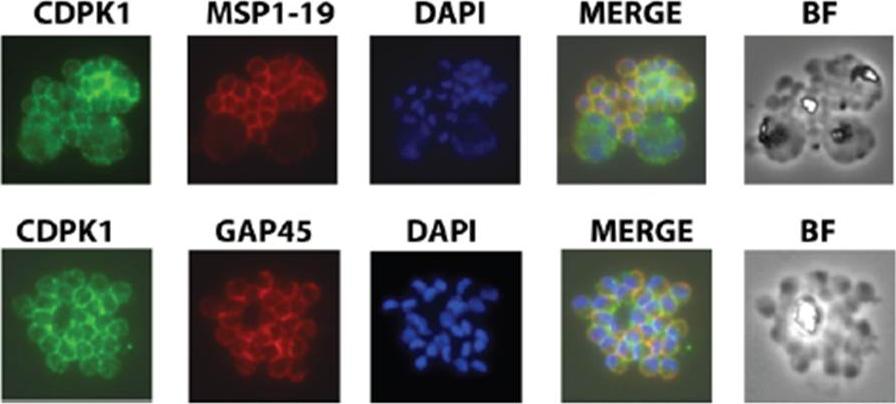
Expression of functional CDPK1 fusion proteins in 3D7 P. falciparum parasites Immunolocalisation of CDPK1 in late schizont stage parasites showing co-localisation with MSP1-19 and GAP45, proteins which reside on the plasma membrane and inner membrane complex, respectively. CDPK1 was detected with CDPK1-specific mouse monoclonal 3E6 and the other proteins with polyclonal rabbit antibodies .Azevedo MF, Sanders PR, Krejany E, Nie CQ, Fu P, Bach LA, Wunderlich G, Crabb BS, Gilson PR. Inhibition of Plasmodium falciparum CDPK1 by conditional expression of its J-domain demonstrates a key role in schizont development. Biochem J. 2013 452(3):433-41
See original on MMP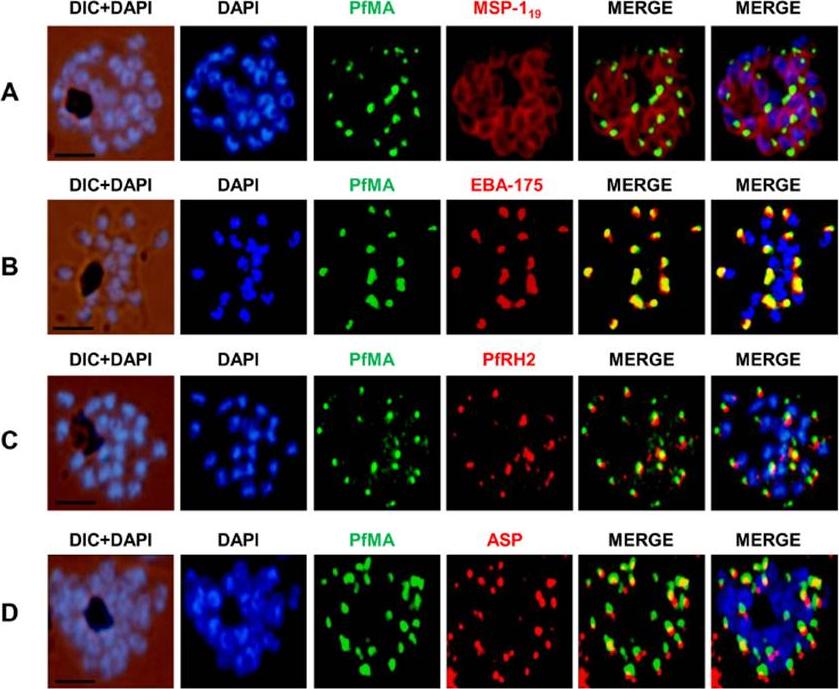
PfMA localization in schizont stages analyzed by fluorescence microscopy. Sub-cellular localization of PfMA was studied by co-immunostaining with surface protein (A), microneme (B), rhoptry (C, D) resident proteins. P. falciparum schizonts were co-immunostained with mouse anti-PfMA (green) and rabbit antibodies against one of the 4 marker proteins (EBA175/PfRH2, ASP, MSP-119) (red). The nuclei of schizont were stained with DAPI (blue) and slides were visualized by fluorescence microscope. All apical marker proteins and PfMA showed punctate staining in schizonts. PfMA was localized in the micronemes as it signal costained with micronemal marker EBA-175. The scale bar indicates 2 μm.Hans N, Singh S, Pandey AK, Reddy KS, Gaur D, Chauhan VS. Identification and Characterization of a Novel Plasmodium falciparum Adhesin Involved in Erythrocyte Invasion. PLoS One. 2013 8(9):e74790.
See original on MMP
Localization of Pfstomatin and RhopH2 to the PVM in ring-infected erythrocytes (0–8 h post-invasion). Cells were subjected to a standard indirect immunofluorescence assay where samples were permeabilized with saponin and probed with antibodies to: Pfstomatin (Ai; green), RhopH2 (Bi; green), and the PVM marker EXP-1 (Aii and Bii; red); the merged images are shown in Aiii and Biii. In C and D, ring-infected erythrocytes were treated with tetanolysin and incubated with antibodies to: Pfstomatin (Ci; red), RhopH2 (Di; red) and the PPM marker MSP-1 (Cii and Dii; green); the merged images are shown in Ciii and Diii. In E and F, rings treated with tetanolysin and permeabilized with saponin were incubated with antibodies to: Pfstomatin (Ei; red), RhopH2 (Fi; red), and MSP-1 (Eii and Fii; green); the merged images are shown in Diii and Fiii. All images shown are single optical section. The nucleus (blue) was stained with Hoechst 33342. Scale bars represent 2 mm. Hiller NL, Akompong T, Morrow JS, Holder AA, Haldar K. Identification of a stomatin orthologue in vacuoles induced in human erythrocytes by malaria parasites. A role for microbial raft proteins in apicomplexan vacuole biogenesis. J Biol Chem. 2003 278:48413-21.
See original on MMP
Antisera raised to an MBP-Pf41 fusion protein (Pf41 amino acids 115–229) recognize a protein of 40 kDa in P. falciparum (3D7) parasites that were either saponin-lysed (S) or untreated (NS) prior to solubilization in non-reducing sample buffer. The reactivity of mouse anti-Pf41 antibodies with schizonts and free merozoites in a double labeling immunofluorescence assay with rabbit anti-MSP1 antibodies is shown. The arrows indicate the apical end of the parasite (dense structure).Sanders PR, Gilson PR, Cantin GT, Greenbaum DC, Nebl T, Carucci DJ, McConville MJ, Schofield L, Hodder AN, Yates JR 3rd, Crabb BS. Distinct protein classes including novel merozoite surface antigens in Raft-like membranes of Plasmodium falciparum. J Biol Chem. 2005 280:40169-76.
See original on MMP
Subcellular localization of PfPLP1 in schizonts and merozoites of P. falciparum. (a) Co-immunostaining of PfPLP1 (green) with merozoite surface protein MSP1 (red). (b) Co-immunostaining of PfPLP1 (green) with micronemal protein EBA-175 (red). PfPLP1 colocalizes with EBA-175 (colocalization coefficient being more than 0.75). (c) Co-immunostaining of PfPLP1 (green) with rhoptry protein CLAG3.1 (red). PfPLP1 is not localized in rhoptry. Nuclei were counterstained with DAPI and Scale bar, 2 mm. (d) Immunoelectron microscopy of PfPLP1. Ultrathin sections of merozoites and late-stage schizonts were labelled with anti-PfPLP1 mouse sera followed by gold-labelled (15 nm) anti-mouse IgG secondary antibodies. Gold particles were detected in elongated, membrane-enclosed micronemes towards the apical end in schizonts and merozoites. Scale bar, 500 nm. PfPLP1 is localized to the micronemes of merozoites.Garg S, Agarwal S, Kumar S, Shams Yazdani S, Chitnis CE, Singh S. Calcium-dependent permeabilization of erythrocytes by a perforin-like protein during egress of malaria parasites. Nat Commun. 2013 Apr 16;4:1736.
See original on MMP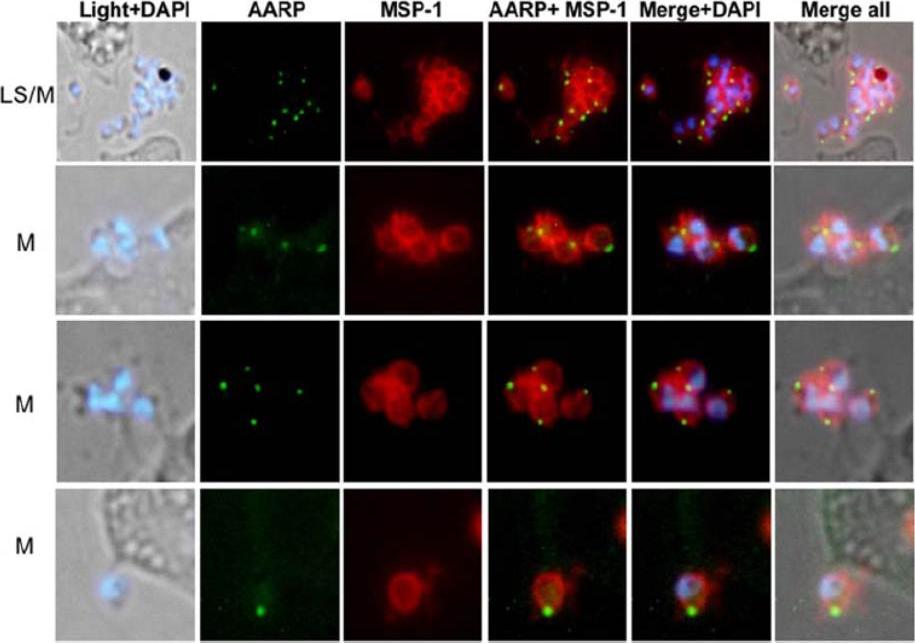
Immunofluorescence assay to localize PfAARP by coimmuno-staining of P. falciparum parasites with anti-PfAARP (green) and anti-MSP-1 (red) antibodies. The parasite nuclei were stained with DAPI (blue) and slides were visualized by fluorescence microscope. The apical ends of the merozoites have dense structure. MSP-1 staining was found around the merozoites and the PfAARP was localized at the apex of the merozoites.Wickramarachchi T, Devi YS, Mohmmed A, Chauhan VS. Identification and characterization of a novel Plasmodium falciparum merozoite apical protein involved in erythrocyte binding and invasion. PLoS ONE. 2008 Mar 5;3(3):e1732.
See original on MMP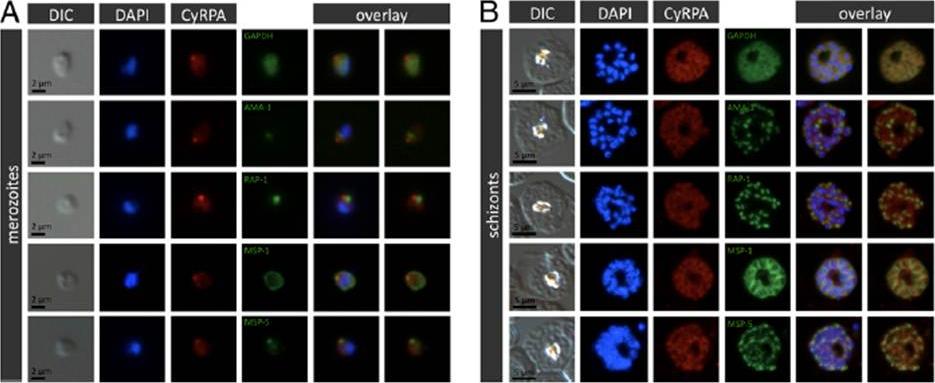
Localization of CyRPA to the merozoite apex by immunofluorescence staining. P. falciparum 3D7 merozoites (A) or schizont stages (B) were coimmunostained with anti-CyRPA mAb c06 (red) and anti-GAPDH Abs (marker for cytosol), AMA-1 (marker for micronemes), RAP-1 (marker for rhoptry bulbs), MSP-1 (marker for merozoite surface), or MSP-5 (green). Nuclei were stained with DAPI (blue). Original magnification x1008. CyRPA is localized at the merozoite apex.Dreyer AM, Matile H, Papastogiannidis P, Kamber J, Favuzza P, Voss TS, Wittlin S, Pluschke G. Passive immunoprotection of Plasmodium falciparum-infected mice designates the CyRPA as candidate malaria vaccine antigen. J Immunol. 2012 188(12):6225-37.
See original on MMP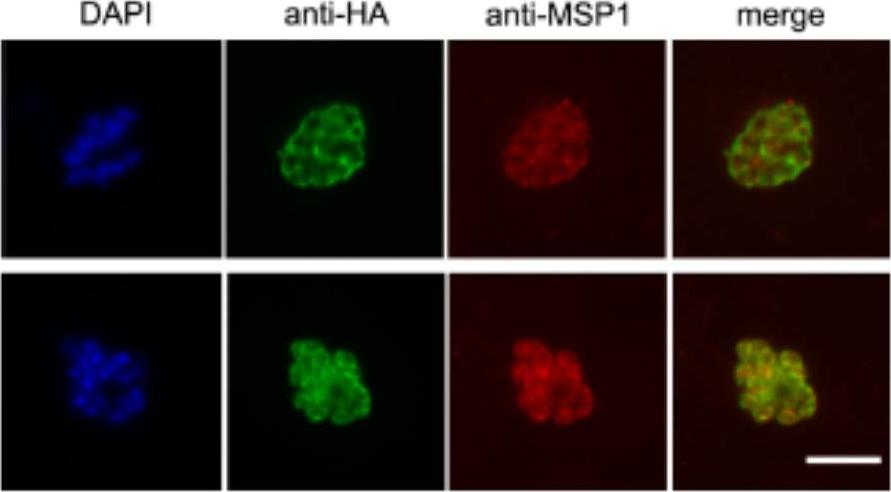
PfROM4 is a merozoite plasma membrane protein. IFA of mature nonsegmented (top) and fully segmented (bottom) schizonts of 3D7HAROM4synth (parasites with episomal expression of N-terminal HA3-tagged PfROM4, under the control of the pfrom4 promoter), dual labeled with mAb 3F10 (anti-HA; green) and mAb 1E1 (anti-MSP1; red). The DAPI signal (blue) is not included in merged images for clarity. Bar, 5 μm.O'Donnell RA, Hackett F, Howell SA, Treeck M, Struck N, Krnajski Z, Withers-Martinez C, Gilberger TW, Blackman MJ. Intramembrane proteolysis mediates shedding of a key adhesin during erythrocyte invasion by the malaria parasite. J Cell Biol. 2006 174:1023-33.
See original on MMP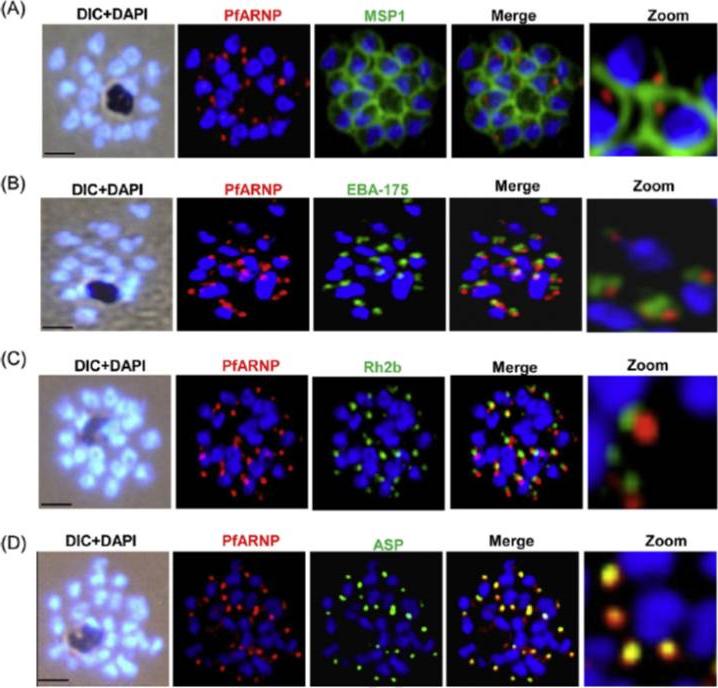
PfARNP is localized in rhoptry neck of P. falciparum. Subcellular localization of PfARNP was studied by co-staining with antibodies against merozoite surface protein-119 (A), micronemal resident protein EBA-175 (B), rhoptry bulb protein Rh2b (C), and rhoptry neck, apical sushi protein (ASP) (D). P. falciparum schizonts were co-stained with anti-PfARNP (red) and anti-MSP-119, anti- EBA-175, anti-Rh2b, anti-ASP antibodies (green). The nuclei of schizonts were stained with DAPI (blue). All apical marker proteins and PfARNP showed punctate staining in schizonts distinct from DAPI. Co-staining of PfARNP with surface marker MSP-119 showed PfARNP localized at the apical tip with surface of merozoites stained by MSP-119. PfARNP staining did not merged with either EBA-175 or Rh2b indicating that it is neither a resident of micronemes or rhoptry bulb of merozoites. The labeling of PfARNP merged perfectly with ASP confirming its localization in the neck of rhoptries of P. falciparum. (Scale bar shows 2 mm). The panel on extreme right shows digital zoom of corresponding merged images.Hans N, Singh S, Jain SK, Chauhan VS. Identification of novel rhoptry neck protein of Plasmodium falciparum. Mol Biochem Parasitol. 2013 188(1):34-9
See original on MMP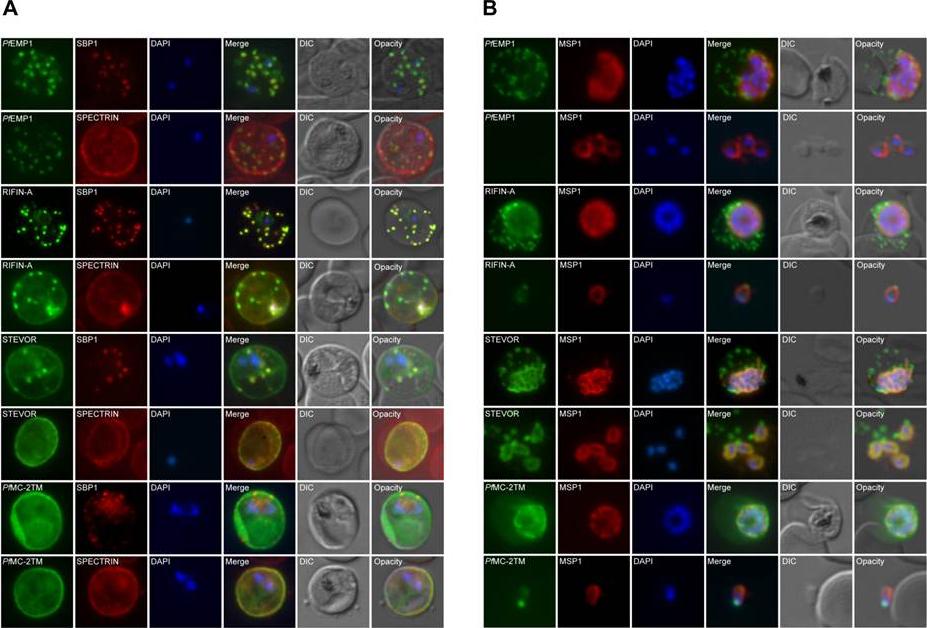
Co-localization of variant surface antigens (VSA) during the intraerythrocytic developmental cycle. A, B: Co-localization of PfEMP1, RIFIN, STEVOR and PfMC-2TM (green) with marker proteins for the erythrocyte membrane (spectrin), the Maurer’s clefts (SBP1) and the merozoite surrounding membrane (MSP1) (red). Subcellular VSA localization was determined in trophozoites (A) as well as in schizonts and free merozites (B) from clinical isolates as well as strain 3D7. Nuclei were stained with DAPI (blue). In the trophozoite stage, RIFIN proteins were exported predominantly to the Maurer’s clefts and the erythrocyte membrane, whereas STEVOR and PfMC-2TM proteins seemed to localize predominantly to the IE membrane. A-type RIFINs, STEVORs and PfMC-2TMs were located in close proximity to the nuclei in dividing parasites in the clinical isolates. In strain 3D7 schizonts, PfMC-2TM family proteins exhibited two distinct localization patterns depending on the antisera used for detection. PfMC-2TM proteins appeared to associate with the parasitophorous vacuole membrane or parasite membrane when using a-PfMC-2TM-SC, while staining with a-PfMC-2TM-CT resulted in a fluorescence pattern similar to RIFIN and STEVOR.Bachmann A, Petter M, Tilly AK, Biller L, Uliczka KA, Duffy MF, Tannich E, Bruchhaus I. Temporal Expression and Localization Patterns of Variant surface Antigens in Clinical Plasmodium falciparum Isolates during Erythrocyte Schizogony. PLoS One. 2012;7(11): e49540.
See original on MMP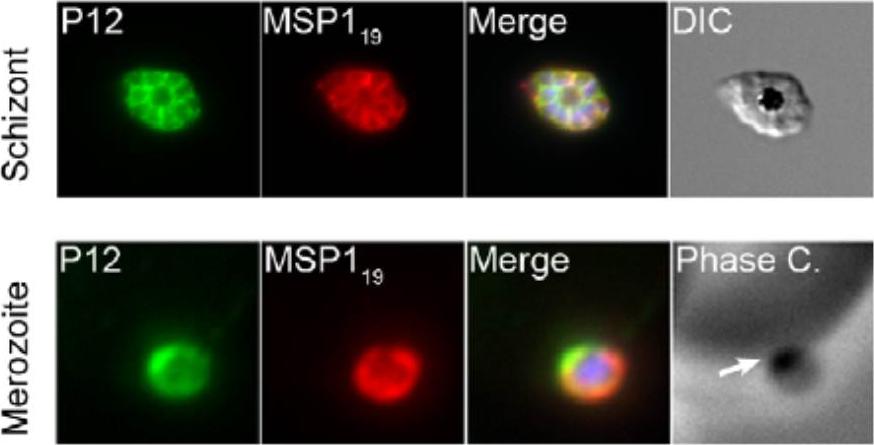
Localisation of P12 was explored by immunofluorescence assays. Schizonts and merozoites were fixed and labelled with mouse anti-MSP119 (10 mg/mL) and rabbit IgG to P12 (50 mg/mL) followed by Alexa Fluor 488 goat anti-rabbit and Alexa Fluor 568 goat anti-mouse secondary antibodies IgG. P12 was found to localise to the parasitophorous vacuole in schizonts and on the merozoite surface upon comparison with MSP119. Interestingly, P12 exhibited concentrated apical localisation on the merozoite surface. Taechalertpaisarn T, Crosnier C, Bartholdson SJ, Hodder AN, Thompson J, Bustamante LY, Wilson DW, Sanders PR, Wright GJ, Rayner JC, Cowman AF, Gilson PR, Crabb BS. Biochemical and Functional Analysis of Two Plasmodium falciparum Blood-Stage 6-Cys Proteins: P12 and P41. PLoS One. 2012;7(7):e41937.
See original on MMP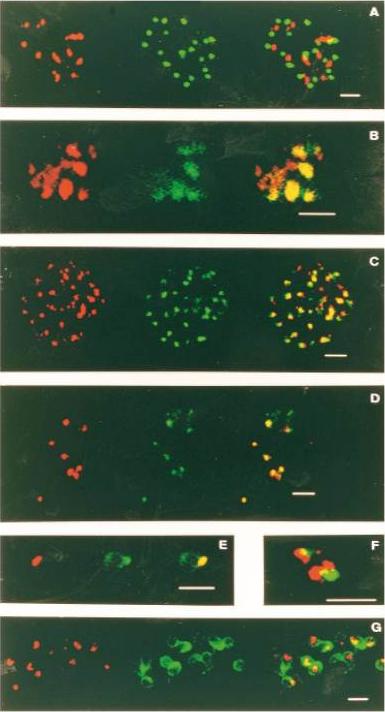
Localization and co-localization of PfPK4, RAP-1, PF14_0102, PF83/AMA-1 PF11_0344 and MSP1 PFI1475w. (A) A segmenter, stained for PfPK4 (red) and RAP-1 (green), with a composite of both labels on the right ; (B) schizont ; (C) segmenter ; (D) and (E) free merozoites, stained for PfPK4 (red) and PF83/AMA-1 (green), with composites on the right ; (F) a free merozoite, a composite of PfPK4 (red) and RAP-1 (green); (G) free merozoites stained for PfPK4 (red) and MSP-1 (green), with a composite of both labels on the right. The scale bars represent 2 mm. PfPK4 distributed throughout the trophozoite, whereas it was found in discrete foci (punctate distribution) in segmenters. PfPK4 co-localizes with AMA-1 at the apical complex in segmenters and merozoites, but does not co-localize with RAP-1.Reproduced with permission, from Möhrle JJ, Zhao Y, Wernli B, Franklin RM, Kappes B. Molecular cloning, characterization and localization of PfPK4, an eIF-2a kinase-related enzyme from the malarial parasite Plasmodium falciparum. Biochem J. 1997 328:677-87. © the Biochemical Society.
See original on MMP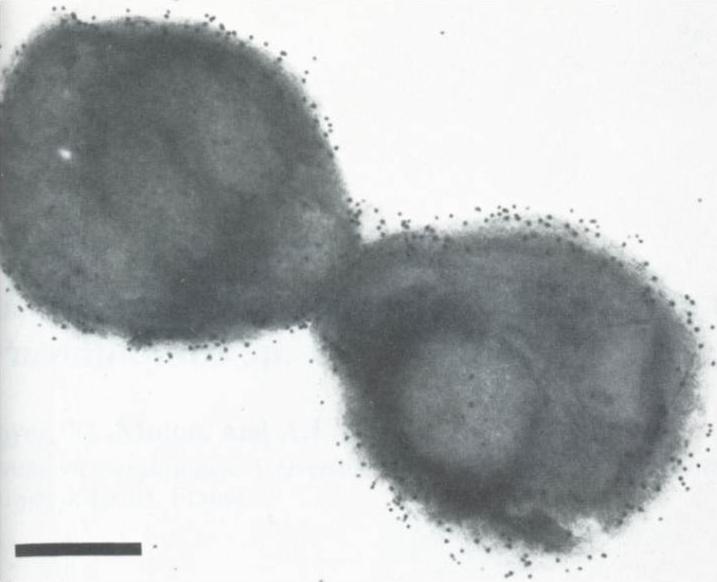
Electron micrograph of a cryosection of freshly isolated merozoites reacted with a 1:1,500 dilution of rabbit antiserum against isolated 80 kDa merozoite antigen followed by labeling of the immune complex with protein-A/gold colloidal gold. Bar=0.5 mm. The 80 kDa ia a proteolytic product of MSP-1.Heidrich HG, Matzner M, Miettinen-Baumann A, Strych W. Immunoelectron microscopy shows that the 80,000-dalton antigen of Plasmodium falciparum merozoites is localized in the surface coat. Z Parasitenkd. 1986 72:681-3.
See original on MMP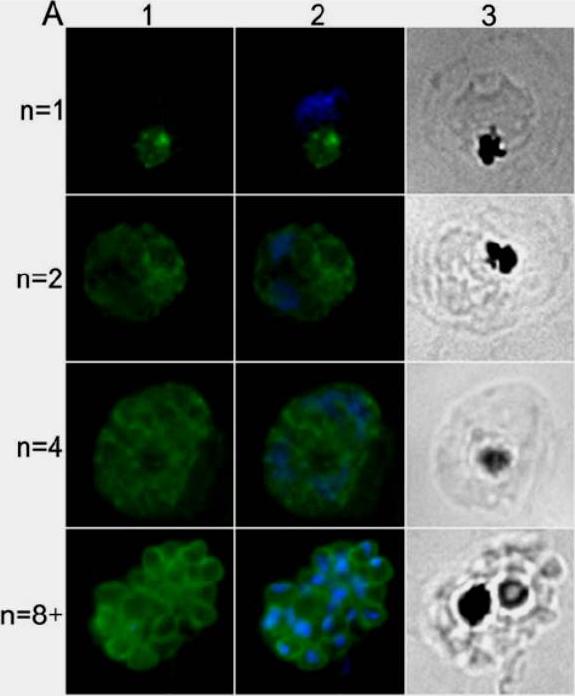
IFA location of MSP119 during schizogony. Each row shows an identical field from 1% formaldehyde-fixed thin smears of late-stages parasites at the 1-, 2-, 4-, and 8-nuclei stage. Panel A1 shows anti-MSP119(rabbit) antibody labeling (the secondary antibody was Alexa Fluor 488-conjugated anti-rabbit IgG antibody (green). Panel A2 shows the same fields merged with the corresponding DAPI stained nucleus images (blue). Panel A3 shows the same fields visualized by light microscopy - note the pigment is clearly visible. Rabbit-anti-MSP119 antibody only detects MSP119 associated with the food vacuole until the two-nuclei stage. Once new full length MSP1 is synthesized and transported to the parasite’s plasma membrane the presence of MSP119 from the previous cycle is now obscured. Dluzewski AR, Ling IT, Hopkins JM, Grainger M, Margos G, Mitchell GH, Holder AA, Bannister LH. Formation of the food vacuole in Plasmodium falciparum: a potential role for the 19 kDa fragment of merozoite surface protein 1 (MSP1(19)). PLoS ONE. 2008 Aug 3(8):e3085. PMID:
See original on MMP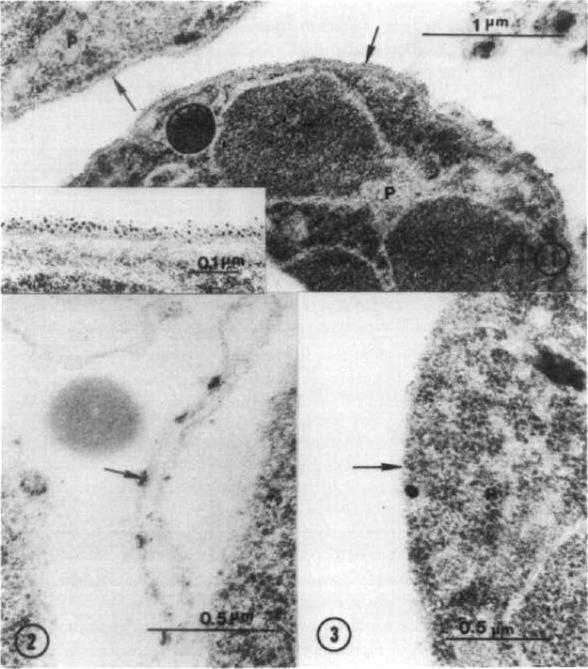
Localization of the 195 kDa glycoprotein by immunoelectronmicroscopy. Erythrocytes infected with mature trophozoite and schizont forms of P. falciparum were treated with saponin to lyse the outer erythrocyte membrane and incubated in RPMI 1640 plus the PF2 7H 10.19 monoclonal antibody (Panels 1 and 2) or in RPM1 1640 alone (Panel 3). The cells were washed, incubated with ferritin-labelled goat anti-mouse lgG and washed again. Panel 1 shows ferritin particles (arrow) evenly distributed over the surface membrane of mature asexual parasites (P). The inset shows ferritin particles at higher magnification. Panel 2 shows erythrocyte membrane and associated knobs (arrow) but extremely low binding of ferritin particles characteristic of nonspecific attachment. Both of the parasites in this panel were still within resealed erythrocyte and parasitophorous vacuole membranes, and were not coated with ferritin particles. Panel 3 shows that in the absence of monoclonal antibody PF2 7H 10.19 very few particles were present on the surface (arrow) of an extracellular membrane-free parasite (P).Howard RJ, Lyon JA, Diggs CL, Haynes JD, Leech JH, Barnwell JW, Aley SB, Aikawa M, Miller LH. Localization of the major Plasmodium falciparum glycoprotein on the surface of mature intraerythrocytic trophozoites and schizonts. Mol Biochem Parasitol. 1984 11:349-62. Copyright Elsevier
See original on MMP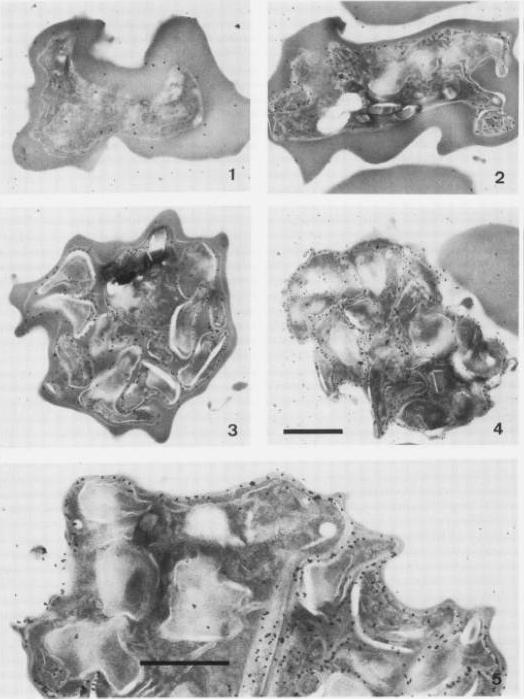
Expression and cellular localization of MSP-I during bloodstage development. Sections of bloodstage forms of the parasite were labelled with monospecific MSP-1I serum followed by protein A gold labelling and silver enhancement. Panel 1, young trophozoite; panel 2, mature trophozoite; panel 3, young schizont; panel 4, mature schizont; panel 5, a typical contact zone of the parasite with the red blood cell membrane at higher magnification. Note the increase in MSP-l synthesis during development and the localization of MSP-l on the outer parasitophorous membrane (bars indicate 1 mm).Herrera S, Rudin W, Herrera M, Clavijo P, Mancilla L, de Plata C, Matile H, Certa U. A conserved region of the MSP-1 surface protein of Plasmodium falciparum contains a recognition sequence for erythrocyte spectrin. EMBO J. 1993 12:1607-14.
See original on MMP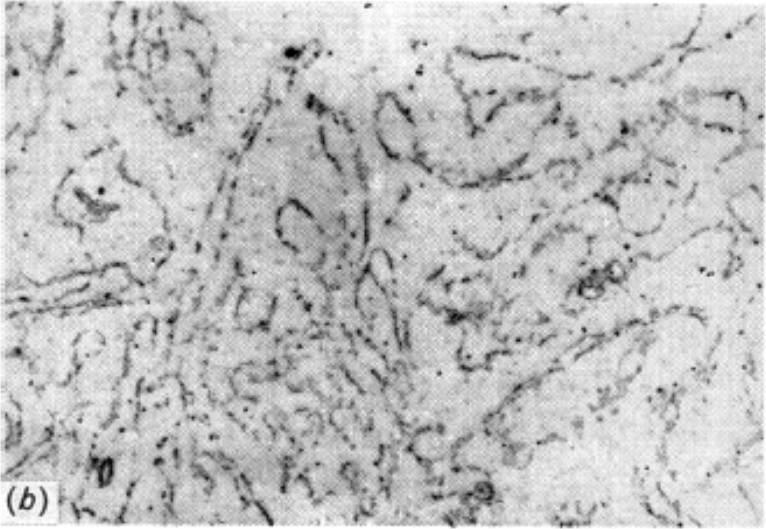
Isolated host infected erythrocyte plasma membrane (IEPM) were labelled with mAb Pf6 3B10, which is specific for a 195 kDa glycoprotein, probably MSP-1, on the surface of mature intra-erythrocytic parasites. Non-membrane-associated gold deposition is shown, indicating non-reactivity. Magnification x 20 500.Reproduced with permission, from Hsiao LL, Howard RJ, Aikawa M, Taraschi TF. Modification of host cell membrane lipid composition by the intra-erythrocytic human malaria parasite Plasmodium falciparum. Biochem J. 1991 274:121-32. Copyright 2010.
See original on MMP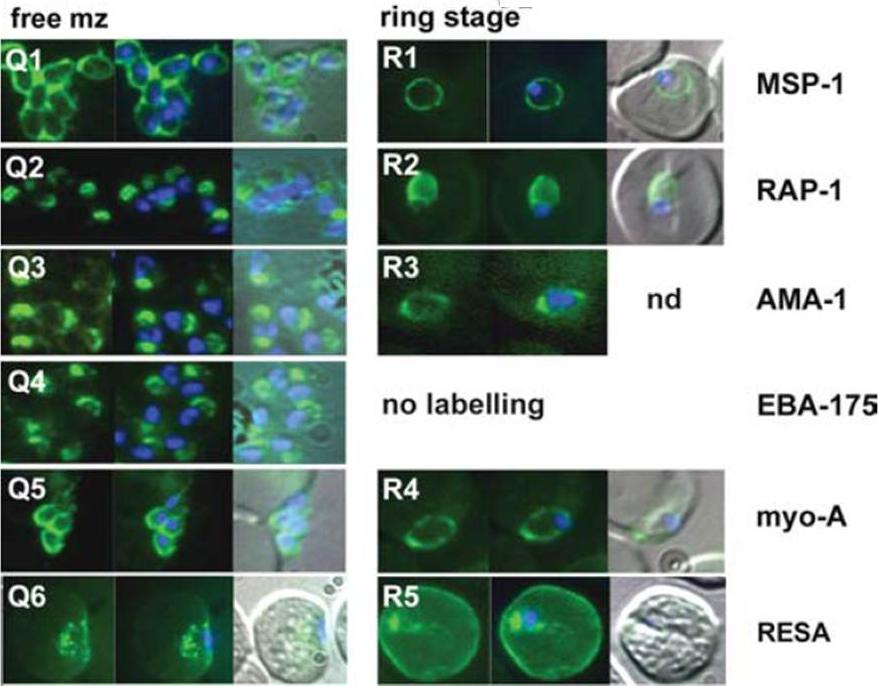
The appearance of Plasmodium falciparum merozoites and rings of the ITO4 line at different times of development. Antibodies to proteins associated with invasion related organelles or the parasite periphery (rhoptries : RAP-1; micronemes: AMA-1, EBA-175; dense granules: RESA; parasite periphery: MSP-1, myo-A) were chosen to follow the development and assembly of merozoites and rings.Margos G, Bannister LH, Dluzewski AR, Hopkins J, Williams IT, Mitchell GH. Correlation of structural development and differential expression of invasion-related molecules in schizonts of Plasmodium falciparum. Parasitology. 2004 129:273-87. Copyright Cambridge University Press Journals 2011
See original on MMP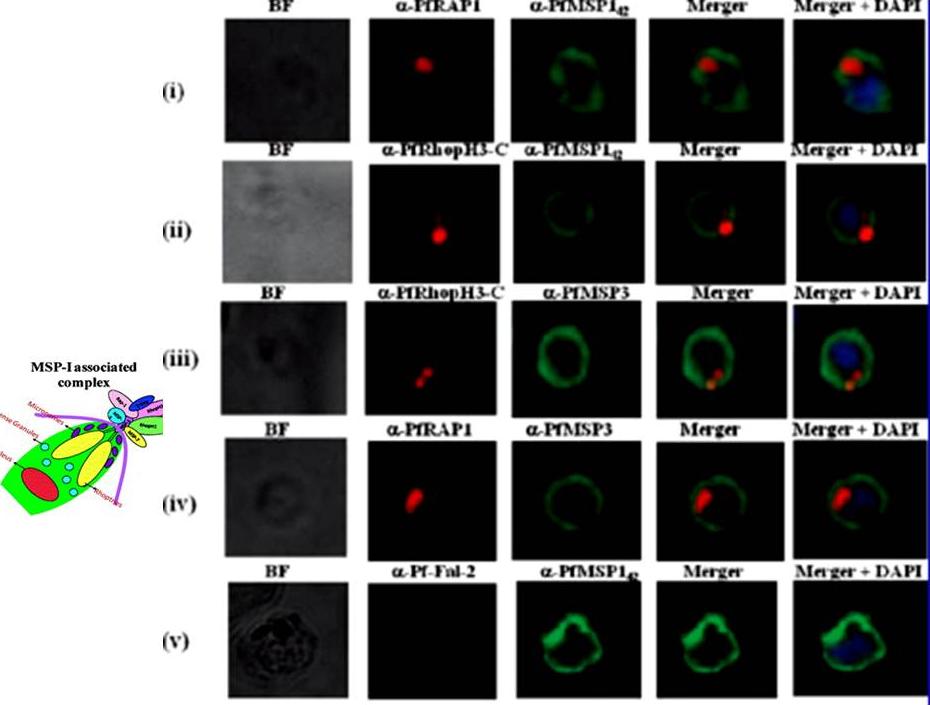
Localization of proteins of PfMSP-1 associated complex by immunofluorescence assay. Unpermeabilized P. falciparum merozoites were coimmunostained with anti-PfRAP-1 and anti-PfMSP-142 antibodies (i), with anti-PfRhopH3-C and anti-PfMSP-142 antibodies (ii), with anti-PfRhopH3-C and anti-PfMSP-3 antibodies (iii), anti-PfRAP-1 and anti-PfMSP-3 antibodies (iv), and anti-Pffalcipain-2 and anti-PfMSP-142 antibodies (v). PfMSP-1 and PfMSP-3 staining was detected on the entire surface of merozoites, while PfRhopH3 and PfRAP-1 staining localized at the apical end of merozoites. Co-localization was observed between PfMSP-1 and PfRAP-1, PfMSP-1 and PfRhopH3, PfMSP-3 and PfRhopH3 as well PfMSP-1 and PfMSP-3 staining was detected on the entire surface of merozoites, while PfRhopH3 and PfRAP-1 staining localized at the apical end of merozoites. Co-localization was observed between PfMSP-1 and PfRAP-1, PfMSP-1 and PfRhopH3, PfMSP-3 and PfRhopH3 as well antibody and the specific location of PfRhopH3 in rhoptries. Ranjan R, Chugh M, Kumar S, Singh S, Kanodia S, Hossain MJ, Korde R, Grover A, Dhawan S, Chauhan VS, Reddy VS, Mohmmed A, Malhotra P. Proteome analysis Rrveals a large merozoite surface protein-1 associated complex on the Plasmodium falciparum merozoite surface. J Proteome Res. 2010 10:680-91. Copyright American Chemical Society
See original on MMP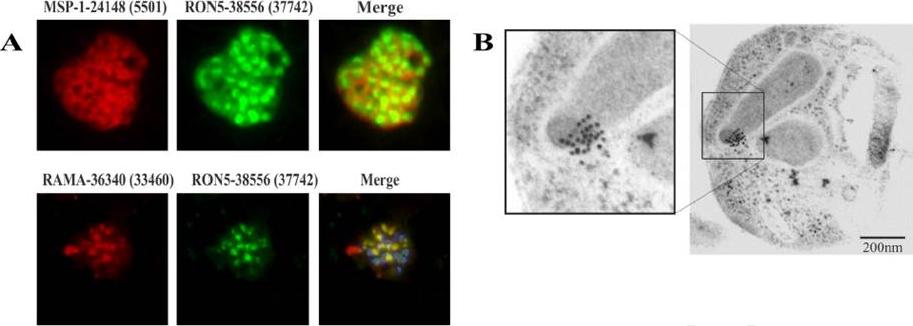
PfRON5 localizes to the rhoptry neck. (A) Aotus antibodies against MSP-1 peptide 24148 (5501) displaying the membrane, and against RAMA peptide 36340 (33460),showing the rhoptries (red fluorescence), together with RON5 peptide 38556 (37742) (green fluorescence) and DAPI (blue fluorescence, merged at the bottom), confirming RON5 localization in the rhoptries but differently to that of RAMA. (B) Immuno-electron microscopy with rabbit antibodies against RON5 peptides and protein A-gold showed specific labeling in the P. falciparum merozoite rhoptry neck. PfRON5 was detected in pear-shaped rhoptry neck portion in segmented schizonts when using rabbit polyclonal antibodies for IEM assay.Curtidor H, Patiño LC, Arévalo-Pinzón G, Vanegas M, Patarroyo ME, Patarroyo MA. Plasmodium falciparum rhoptry neck protein 5 peptides bind to human red blood cells and inhibit parasite invasion. Peptides. 2013 Aug 8. 9781(13)00268-4.
See original on MMP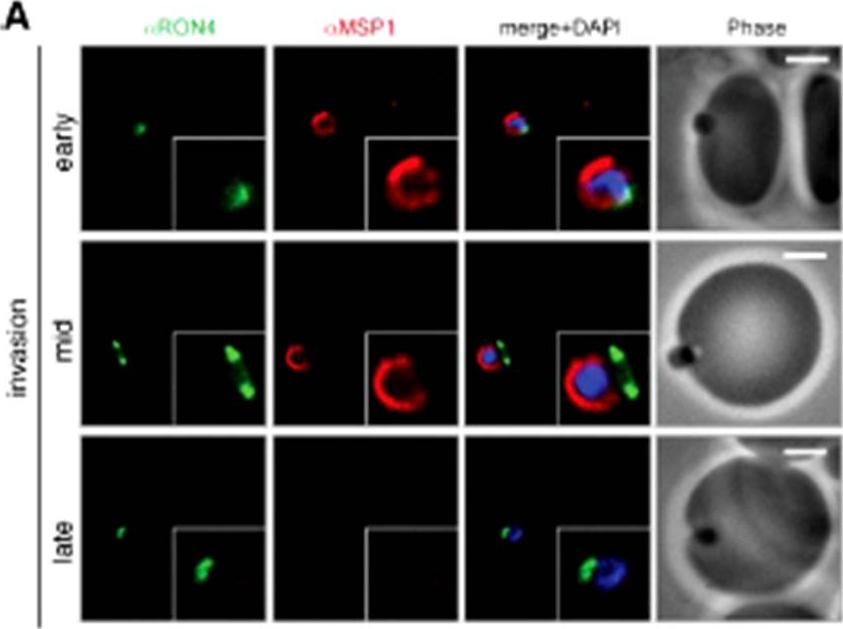
Wide field IFA time course of invasion using A) anti-MSP1/PfRON4. Scale bar = 2.0 μm. Before commencement of invasion, no loss of MSP1 labeling was apparent (MSP1 early). Loss of MSP1 tracked the exterior of invading merozoites concurrent with different stages of passage through the tight (MSP1 mid). The lack of contiguity between shed MSP1 and PfSUB2 sheddase, each in comparison with PfRON4 suggests that MSP1 may be processed by PfSUB2 early in invasion but shed only during passage through the junction.Riglar DT, Richard D, Wilson DW, Boyle MJ, Dekiwadia C, Turnbull L, Angrisano F, Marapana DS, Rogers KL, Whitchurch CB, Beeson JG, Cowman AF, Ralph SA, Baum J. Super-resolution dissection of coordinated events during malaria parasite invasion of the human erythrocyte. Cell Host Microbe. 2011 9:9-20.
See original on MMP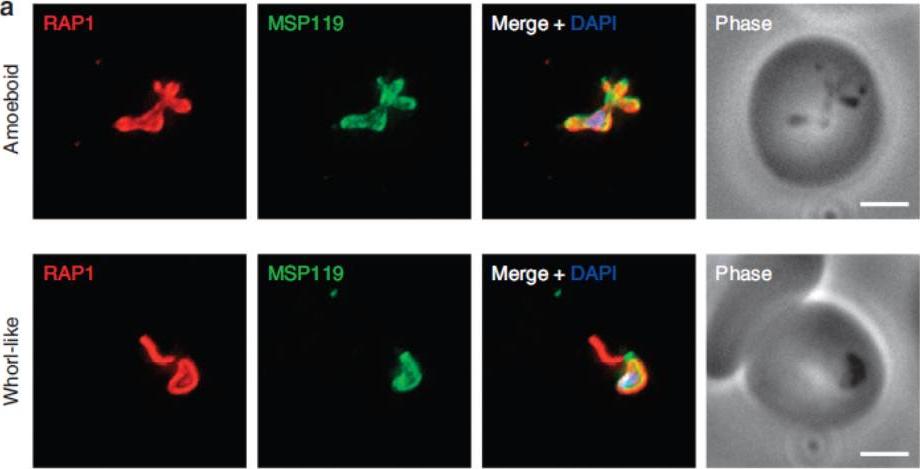
P. falciparum merozoite morphology changes post erythrocyte invasion. Parasites were fixed <12 min following merozoite invasion and labelled by IFA using standard markers for the PV (RAP1, red), parasite plasma membrane (MSP1-19, green) and nucleus (40,6–diamidino-2-phenylindole (DAPI), blue). (a) Widefield deconvolution microscopy identified various morphological changes that had occurred within this period, including pseudopodia-like extensions (top) and whorl-like extensions (bottom). Scale bar, 2.5 mm.Riglar DT, Rogers KL, Hanssen E, Turnbull L, Bullen HE, Charnaud SC, Przyborski J, Gilson PR, Whitchurch CB, Crabb BS, Baum J, Cowman AF. Spatial association with PTEX complexes defines regions for effector export into Plasmodium falciparum-infected erythrocytes. Nat Commun. 2013 Jan 29;4:1415.
See original on MMP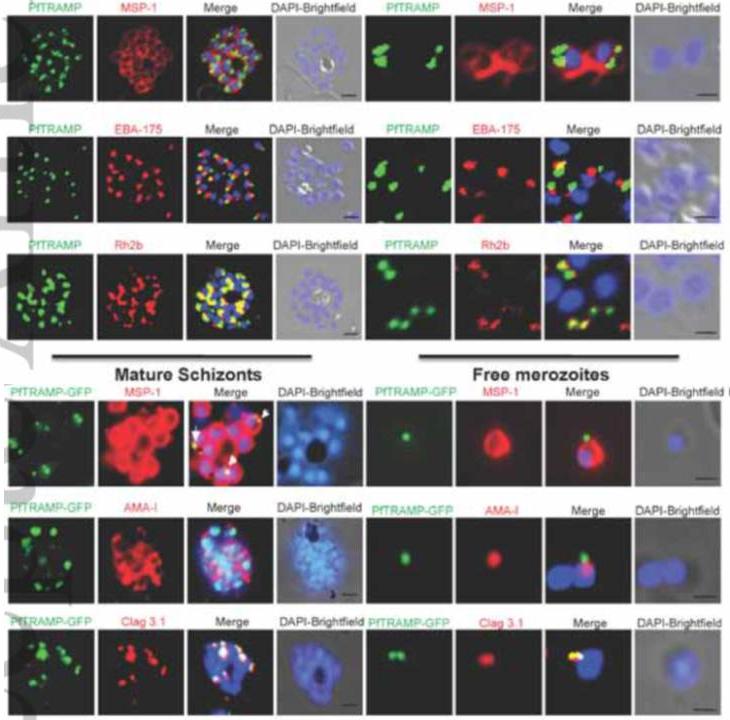
PfTRAMP localizes to the rhoptries of P. falciparum schizonts and merozoites.(A) Co-localization of PfTRAMP with MSP1, EBA175 and Rh2b in schizonts and free merozoites by IFA. PfTRAMP (green) co-localizes with rhoptry marker PfRh2b (red) but does not co-localize with EBA175 (red) or merozoite surface marker MSP1 (red) in schizonts and merozoites. (B)Co-localization of PfTRAMP-GFP in transgenic P. falciparum 3D7 with MSP1, AMA1 and Clag3.1. PfTRAMP-GFP (green) co-localizes with rhoptry marker Clag 3.1 (red) but not with microneme markerPfAMA1 (red) or merozoite suface marker PfMSP1 (red) in schizonts and merozoites. Nuclei were stained with DNA intercalating dye DAPI.Siddiqui FA, Dhawan S, Singh S, Singh B, Gupta P, Pandey A, Mohmmed A, Gaur D, Chitnis CE. A Thrombospondin Structural Repeat Containing Rhoptry Protein from Plasmodium falciparum Mediates Erythrocyte Invasion. Cell Microbiol. 2013 15(8):1341-56
See original on MMP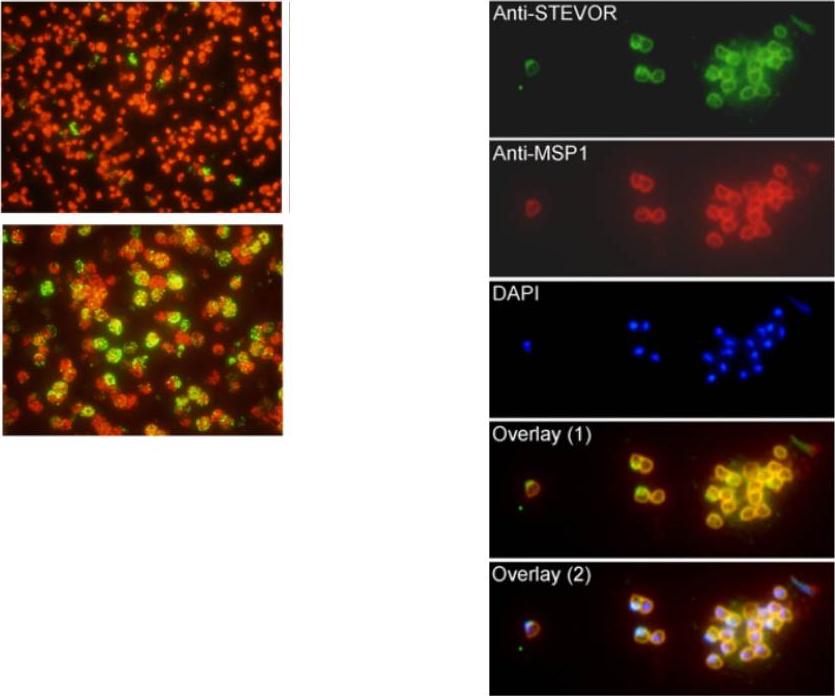
Left panel: Recognition of STEVORs in non-permeabilized and saponin-permeabilized schizont infected erythrocytes (IE). Fluorescence microscopy image of the schizont IE that were recognized by anti-PFL2610w antibody. Minimal binding of anti-PFL2610w antibody to the surface of schizont IE was observed. the anti-PFL2610w can only recognize STEVOR variants that are associated with internal schizont IE structures but not those presumably expressed on the surface. Right panel: Colocalization of STEVORs with MSP-1 at the free merozoite membranes. Fluorescence staining using anti-PFL2610w and anti-MSP-1 antibodies was analysed in free merozoites. (B) Alexa 488 stained STEVORs, (C) Alexa 594 stained MSP-1, (D) DAPI stained parasite nuclei, (E) the overlay of STEVORs and MSP-1 (overlay 1) and (F) the overlay of STEVORs, MSP-1 and nuclei (overlay 2) images are shown. Khattab A, Meri S. Exposure of the Plasmodium falciparum clonally variant STEVOR proteins on the merozoite surface. Malar J. 2011 Mar 14;10:58.
See original on MMP
Immunofluorescence detection of MSP-636 in acetone-fixed P. falciparum T9:96 schizonts. Panels A to C show the reaction with antibodies raised to a recombinant fusion protein containing the last 45 amino acids of MSP-6; panels D, E, and F show the reaction of MSP-1 specific mAbs X509, 1E1 and 8A12, respectively. MSP-636 is the processed product of the precursor merozoite surface protein 6 (MSP-6). Results show that antibodies bound to antigen at the parasite surface or in the parasitophorous vacuole within schizonts, with a pattern indistinguishable from that of antibodies to MSP-1.Trucco C, Fernandez-Reyes D, Howell S, Stafford WH, Scott-Finnigan TJ, Grainger M, Ogun SA, Taylor WR, Holder AA. The merozoite surface protein 6 gene codes for a 36 kDa protein associated with the Plasmodium falciparum merozoite surface protein-1 complex. Mol Biochem Parasitol. 2001 112:91-101. . Copyright Elsevier 2010.
See original on MMP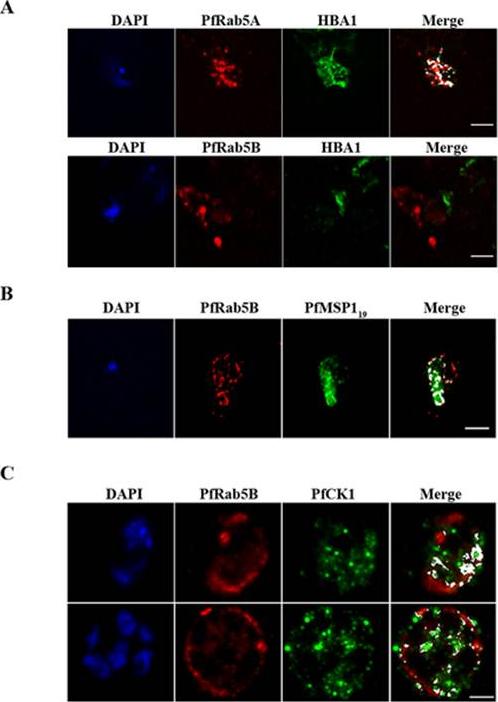
PfRab5B colocalises with PfMSP1 and PfCK1, but not with haemoglobin. (A) PfRab5A colocalises with haemoglobin (HBA1) containing vesicles unlike PfRab5B. (B) PfRab5B colocalises to differing degrees with the C-terminal 19 kDa fragment of PfMSP1 on structures close to the food vacuole and the parasite nucleus shown in blue by DAPI staining. (C) PfRab5B colocalises with PfCK1 on intracellular structures and at the parasite plasma membrane. Areas of colocalistaion are shown in white and used to calculate Pearson’s r coefficients. Scale bars, 2 mm.Ezougou CN, Ben-Rached F, Moss DK, Lin JW, Black S, Knuepfer E, Green JL, Khan SM, Mukhopadhyay A, Janse CJ, Coppens I, Yera H, Holder AA, Langsley G. Plasmodium falciparum Rab5B Is an N-Terminally Myristoylated Rab GTPase That Is Targeted to the Parasite's Plasma and Food Vacuole Membranes. PLoS One. 2014 9(2):e87695
See original on MMP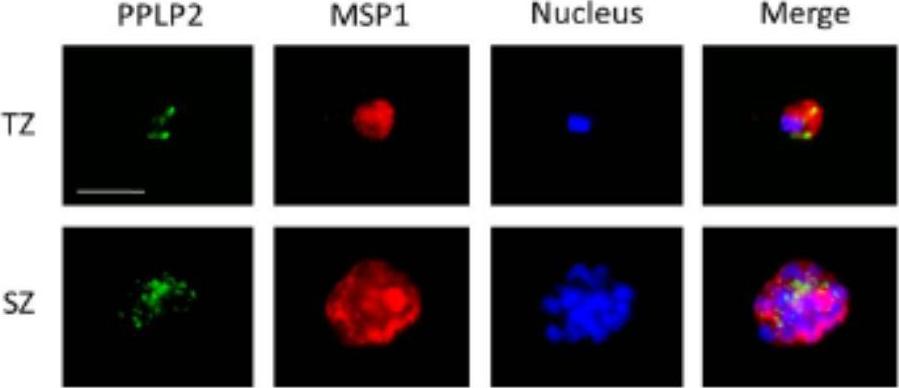
PPLP2 localization in asexual blood stage parasites. PPLP2-positive vesicular structures are present in the cytoplasm of trophozoites (TZ) and schizonts (SZ). PPLP2 was immunolabelled with mouse anti-PPLP2RP1 antisera (green), the asexual blood stages were visualized by rabbit anti-MSP1 antisera (red). Nuclei were highlighted by Hoechst stain (blue). PPLP2 first appeared in the trophozoites stage and here localized in vesicular structures. Multiple PPLP2-positive vesicular structures were detected also in mature schizonts. The blood stage parasites were highlighted by labelling of MSP1.Wirth CC, Glushakova S, Scheuermayer M, Repnik U, Garg S, Schaack D, Kachman MM, Weißbach T, Zimmerberg J, Dandekar T, Griffiths G, Chitnis CE, Singh S, Fischer R, Pradel G. Perforin-like protein PPLP2 permeabilizes the red blood cell membrane during egress of Plasmodium falciparum gametocytes. Cell Microbiol. 2014 Mar 7.
See original on MMP
Schizonts of rapamycin-treated parasites were dual labelled with anti-MSP1 (red) and anti-PfAMA1 (green) to show reduction in PfAMA1 expression. Schizonts displaying a gradient of high (arrow, top row), medium (bottom row) and low (arrowhead, top row) levels of PfAMA1 expression were observed. Scale bar is 5 μm. All of the merozoite microneme organelles within any particular parasite cell were evenly stained indicating that the extent of PfAMA1 knockdown was uniform between daughter merozoites.Yap A, Azevedo MF, Gilson PR, Weiss GE, O'Neill MT, Wilson DW, Crabb BS, Cowman AF. Conditional expression of apical membrane antigen 1 in Plasmodium falciparum shows it is required for erythrocyte invasion by merozoites. Cell Microbiol. 2014 Feb 27. [Epub ahead of print]
See original on MMP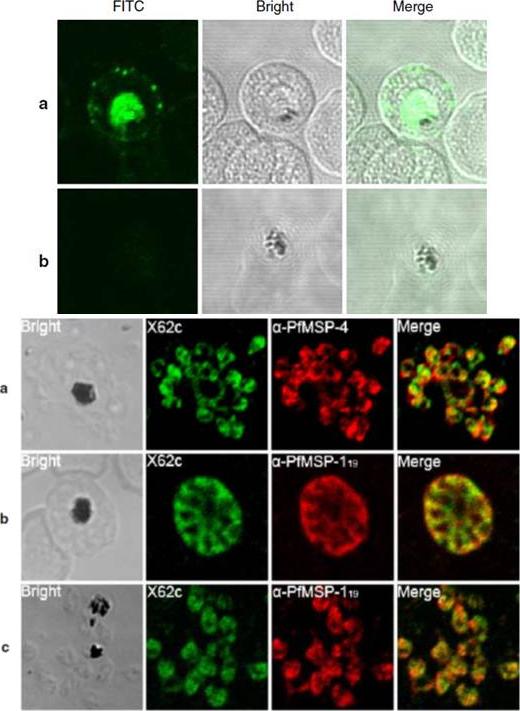
Confocal images of FITC PfMAg-1 in mature stage P. falciparum 3D7 infected erythrocytes examined by indirect immunofluorescent assay. Trophozoite stage parasites were immunostained with McAb X62c followed by FITC-labeledsecondary antibody. In addition to the fluorescent labeling on the bodies of trophozoite parasites, dispersed fluorescence patches were observed underneath the parasite-infected erythrocyte membrane (a), while no fluorescence was observed when normal mouse serum was used (b)Co-localization of PfMAg-1 with PfMSP-4 or PfMSP-119 at late schizont/merozoite parasites examined by confocal fluorescent microscopy. a Merozoite detected with antibodies X62c and α-PfMSP-4. b Mature schizont detected with antibodies X62c and α-PfMSP-119. c Merozoite detected with antibodies X62c and α-PfMSP-119. Bright field images are shown on the left panel.Gao YH, Li HL, Lu Y, Gao FM, Lin YH, Zhou HC, Zhang LH, Wang H. Identification of a vaccine candidate antigen, PfMAg-1, from Plasmodium falciparum with monoclonal antibody M26-32. Parasitol Res. 2009 105(6):1723-32.
See original on MMP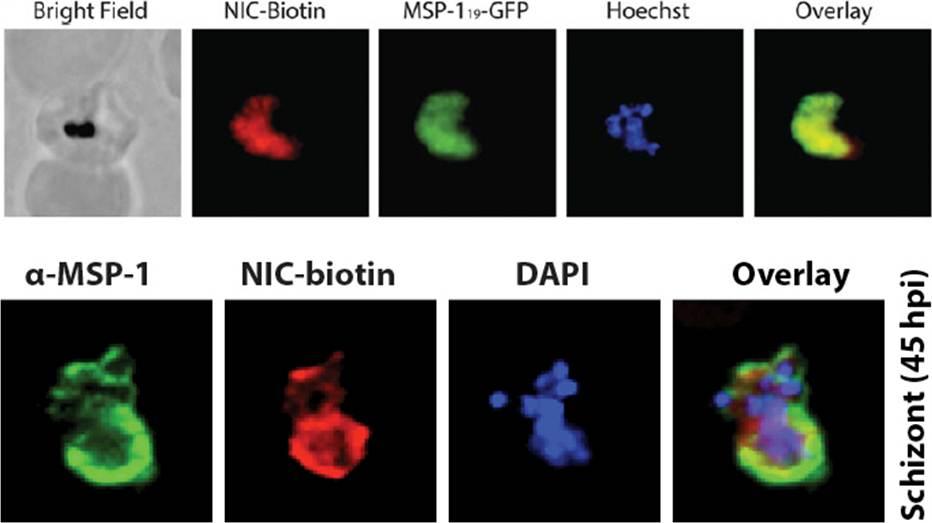
Upper panel: NIC interacts specifically with MSP-119 of Plasmodium falciparum. Fluorescent microscopy analyses using NIC-biotin reveals the target on merozoite surface, co-localizing with MSP-119-GFPLower panel: Co-localization of MSP-1 (using an antibody) and NIC-biotin using immunofluorescence microscopy ,Chandramohanadas R, Basappa, Russell B, Liew K, Yau YH, Chong A, Liu M, Gunalan K, Raman R, Renia L, Nosten F, Shochat SG, Dao M, Sasisekharan R, Suresh S, Preiser P. Small Molecule Targeting Malaria Merozoite Surface Protein-1 (MSP-1) Prevents Host Invasion of Divergent Plasmodial Species. J Infect Dis. 2014 May 26. [Epub ahead of print]
See original on MMP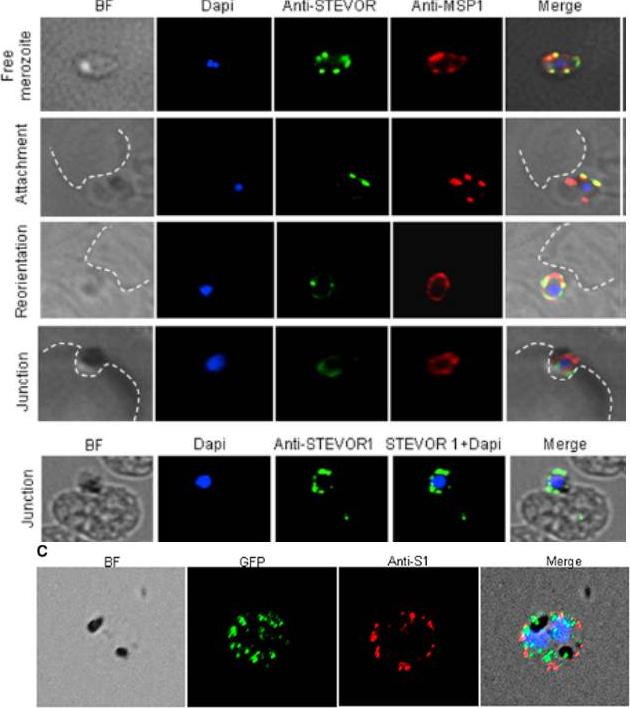
Dual life IFA staining of 5A-merozoite with anti-S2 (green) and anti-MSP1.19 (red) showing constant expression and location of STEVOR on the merozoite surface during the invasion process (free merozoite, attachment, reorientation, and junction). Fixed IFA confirming STEVOR location on the merozoite surface in cytochalasin D-junction arrested 5A merozoites (junction). The individual stains, merged images, and bright field (BF) are shown. The dotted white lines delineate the RBC membrane. Clear colocalization of STEVOR with MSP1 on live merozoite surface consistent with antibody recognition of STEVOR on the merozoite surface interfering with invasion. STEVOR consistently colocalized with MSP1 at the surface of the merozoite at different steps of the invasion process, and no evidence was obtained indicating that STEVOR is involved in the tight junction formation, as illustrated by STEVOR expression on the merozoite surface of cytochalasin-D-junction-arrested merozoites.(C) Live IFA showing correct surface trafficking of the GFP fusion protein using anti-S1 antibody. From left to right are shown bright field (BF), nuclei staining (DAPI), GFP, anti-S1 staining, and merged imagesNiang M, Bei AK, Madnani KG, Pelly S, Dankwa S, Kanjee U, Gunalan K, Amaladoss A, Yeo KP, Bob NS, Malleret B, Duraisingh MT, Preiser PR. STEVOR Is a Plasmodium falciparum Erythrocyte Binding Protein that Mediates Merozoite Invasion and Rosetting. Cell Host Microbe. 2014 16(1):81-93. PMID:
See original on MMP
Immunolocalization of PfSEA-1. (A) Infected RBCs were probed with mouse anti–PfSEA-1 (green) and rabbit anti–MSP-1 (red) and counterstained with 4',6'-diamidino-2-phenylindole (DAPI) to label parasite nuclei. PfSEA-1 is detected only in schizont-infected RBCs. Scale bar for free merozoite images, 2 mm. Scale bar for remaining images, 10 mm. Anti–PfSEA-1 did not bind to free merozoites, rings, or late trophozoite–stage parasites, but did specifically recognize an antigen expressed by late schizont–infected RBCs.Raj DK, Nixon CP, Nixon CE, Dvorin JD, DiPetrillo CG, Pond-Tor S, Wu HW, Jolly G, Pischel L, Lu A, Michelow IC, Cheng L, Conteh S, McDonald EA, Absalon S, Holte SE, Friedman JF, Fried M, Duffy PE, Kurtis JD. Antibodies to PfSEA-1 block parasite egress from RBCs and protect against malaria infection. Science. 2014 344(6186):871-7.
See original on MMP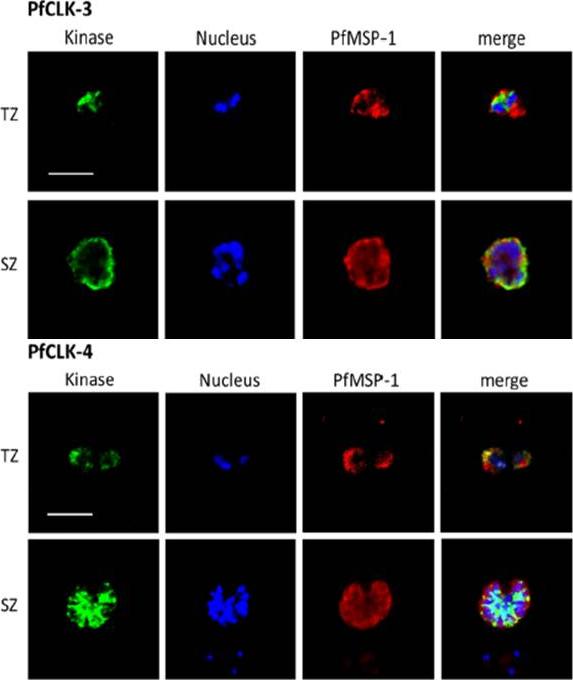
Subcellular localization of PfCLK-3 and PfCLK-4 in the blood stage. Mixed asexual blood stage cultures containing trophozoites (TZ) and schizonts (SZ) cultures were fixed with methanol and prepared for IFA, using rat antisera against PfCLK-3 and mouse antisera against PfCLK-4 (green). The parasite nuclei were highlighted by Hoechst staining (blue). The asexual blood stages were labelled with rabbit antisera against PfMSP-1. Bar, 5 mm. PfCLK-3 and PfCLK-4 are mainly present in the nucleus of trophozoites, while in schizonts and gametocytes both kinases are primarily located in the cytoplasm. Particularly for PfCLK-3 a rim-associated labelling pattern was observed in the latter stages. In the IFAs, the asexual blood stage parasites were highlighted by labelling of plasmalemma-associated proteins, i.e. PfMSP-1.Kern S, Agarwal S, Huber K, Gehring AP, Strödke B, Wirth CC, Brügl T, Abodo LO, Dandekar T, Doerig C, Fischer R, Tobin AB, Alam MM, Bracher F, Pradel G. Inhibition of the SR Protein-Phosphorylating CLK Kinases of Plasmodium falciparum Impairs Blood Stage Replication and Malaria Transmission. PLoS One. 2014 Sep 4;9(9):e105732.
See original on MMP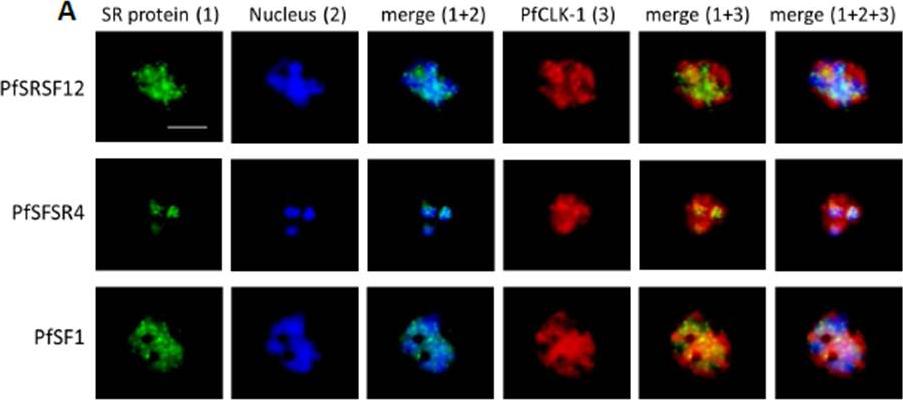
Co-localization and control IFAs. A. Immunolabelling of PfCLK-1 with rabbit antisera (red) detected the kinase in the schizonts´ cytoplasm as well as in the nuclei, where it co-localizes with the three SR proteins (green). Schizonts were counterlabelled with rabbit antibodies against PfMSP-1 (red). All nuclei were highlighted by Hoechst staining (blue). Bar, 5 μm. The co-localization experiments confirmed that the SR proteins are solely present in the nuclei, while in the early schizont stage, PfCLK-1 is present both in the parasite nuclei and the cytoplasm. Co-localization of PfCLK-1 with the three SR proteins can be detected in distinct nuclear regions. Kern S, Agarwal S, Huber K, Gehring AP, Strödke B, Wirth CC, Brügl T, Abodo LO, Dandekar T, Doerig C, Fischer R, Tobin AB, Alam MM, Bracher F, Pradel G. Inhibition of the SR Protein-Phosphorylating CLK Kinases of Plasmodium falciparum Impairs Blood Stage Replication and Malaria Transmission. PLoS One. 2014 Sep 4;9(9):e105732.
See original on MMP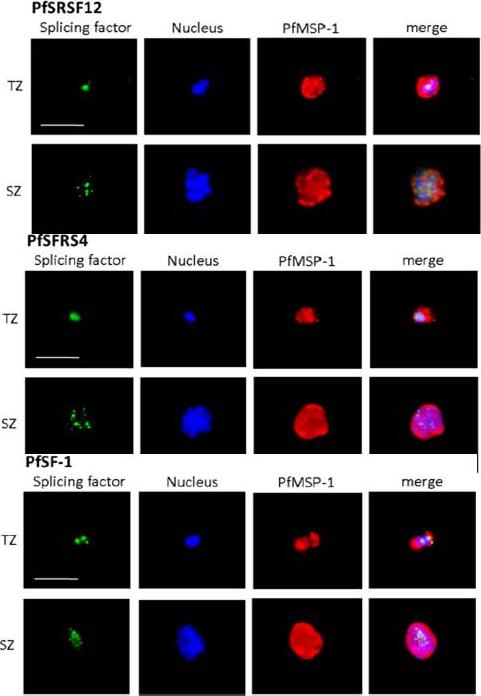
Subcellular localization of the SR proteins in the blood stage. Mixed asexual blood stage cultures containing trophozoites (TZ) and schizonts (SZ) cultures were fixed with paraformaldehyde and prepared for IFA, using mouse antisera against PfSRSF12, PfSFRS4 and PfSF-1 (green). The parasite nuclei were highlighted by Hoechst staining (blue). The parasites were labelled with rabbit antisera against PfMSP-1. Bar, 5 mm. IFAs detected the three SR proteins in the trophozoite nucleus (top rows). An additional minor labelling was observed in the nuclei of the schizont stages (center rows).Kern S, Agarwal S, Huber K, Gehring AP, Strödke B, Wirth CC, Brügl T, Abodo LO, Dandekar T, Doerig C, Fischer R, Tobin AB, Alam MM, Bracher F, Pradel G. Inhibition of the SR Protein-Phosphorylating CLK Kinases of Plasmodium falciparum Impairs Blood Stage Replication and Malaria Transmission. PLoS One. 2014 Sep 4;9(9):e105732.
See original on MMP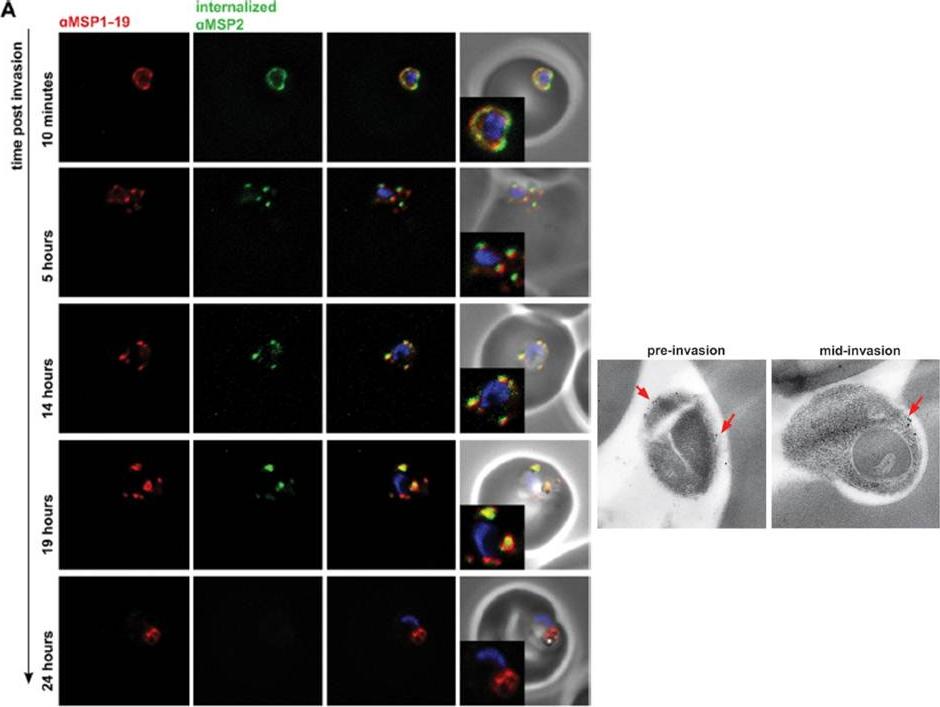
Parasites were labeled with polyclonal rabbit antibodies to MSP1-19 and secondary antibodies (anti-rabbit Alexa594 to detect MSP1-19 labelingand anti-mouse Alexa488 to detect internalized MSP2 MAbs, with anti-MSP1-19 at a 1:200 dilution and secondary antibodies at a 1:500 dilution).Internalized MSP2 MAbs were detected up to 19 h postinvasion. Images are from representative antibodies to the C-terminally conserved region. The labeling of internalized MSP2 MAb was colocalizedwith labeling of MSP1-19 by polyclonal rabbit antibodies, further suggesting that MAbs to MSP2 were bound to the parasite surface postinvasion. Lower panel: 3D7 strain merozoites were fixed during invasion for EM and labeled with MSP2 N-terminal antibodies. A repre-sentative image of a merozoite prior to and during invasion is shown. Labeling is indicated with red arrows.Boyle MJ, Langer C, Chan JA, Hodder AN, Coppel RL, Anders RF, Beeson JG. Sequential processing of merozoite surface proteins during and after erythrocyte invasion by Plasmodium falciparum. Infect Immun. 2014 82(3):924-36.
See original on MMP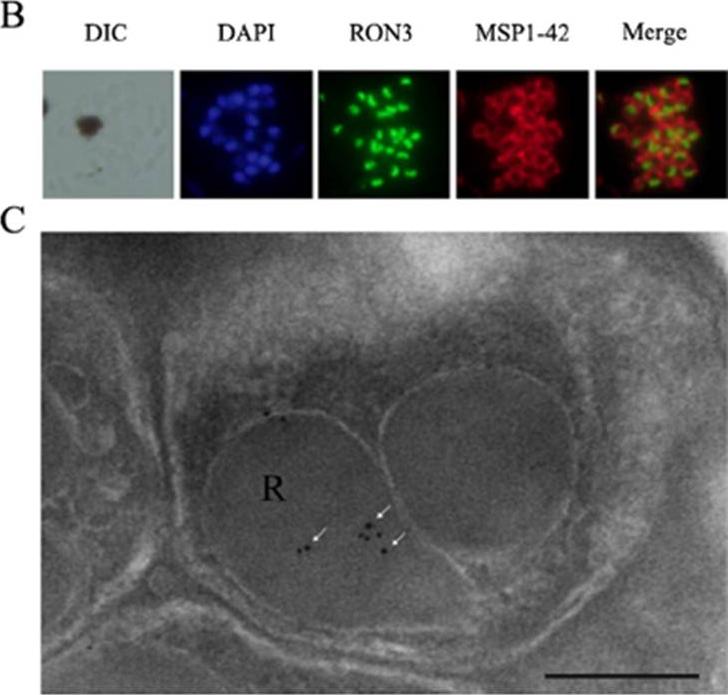
The expression and localization of PfRON3 in Plasmodium falciparum merozoites. (B) PfRON3 is expressed inside Plasmodium merozoites. Schizont stage parasites were dual-labeled with PfRON3-specific antibodies in combination with MSP1-42 antibodies. Nuclei are stained with DAPI. MSP1-42 protein was located at the merozoite membrane (red fluorescence) and RON3 was located inside merozoites (green fluorescence). (C) PfRON3 location shown via immunoelectronic microscopy. The section of merozoite in mature schizonts was labeled with purified rabbit anti-PfRON3 antibodies and subsequently detected with a secondary antibody conjugated with gold particles (arrow-headed). The black dots indicate signals from gold particles localized in the rhoptry body. Bar represents 200 nm.Zhao X, Chang Z, Tu Z, Yu S, Wei X, Zhou J, Lu H, Jiang N, Chen Q. PfRON3 is an erythrocyte-binding protein and a potential blood-stage vaccine candidate antigen. Malar J. 2014 Dec 12;13(1):490.
See original on MMP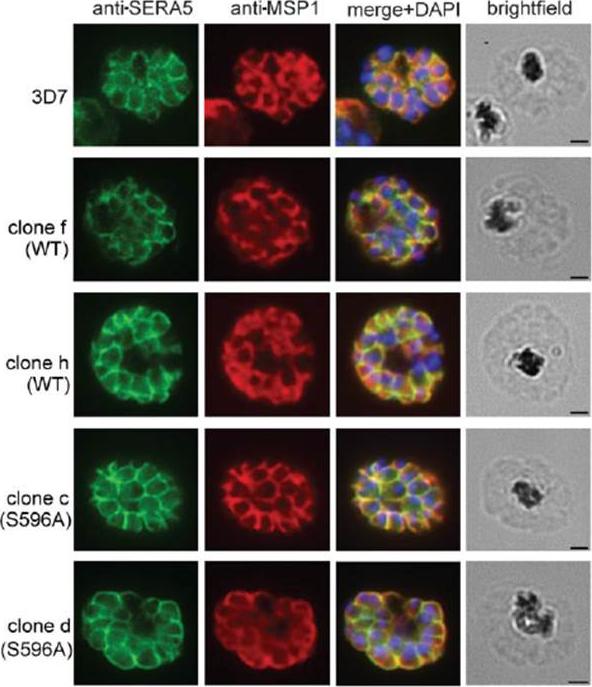
IFA images of schizonts of the indicated transgenic and parental 3D7 clones, probed with a polyclonal rabbit antiserum raised against full-length rSERA5wt (green) or the anti-MSP1 monoclonal antibody (mAb) 89.1 (red). The merged images include the fluorescence signal of the nuclear stain DAPI. No morphological differences were evident between the parental and transgenic parasites. Scale bar, 1 mm. IFA analysis showed normal expression and distribution of SERA5 in all clones.Stallmach R, Kavishwar M, Withers-Martinez C, Hackett F, Collins CR, Howell SA, Yeoh S, Knuepfer E, Atid AJ, Holder AA, Blackman MJ. Plasmodium falciparum SERA5 plays a non-enzymatic role in the malarial asexual blood-stage lifecycle. Mol Microbiol. 2015 Jan 20. [Epub ahead of print]
See original on MMP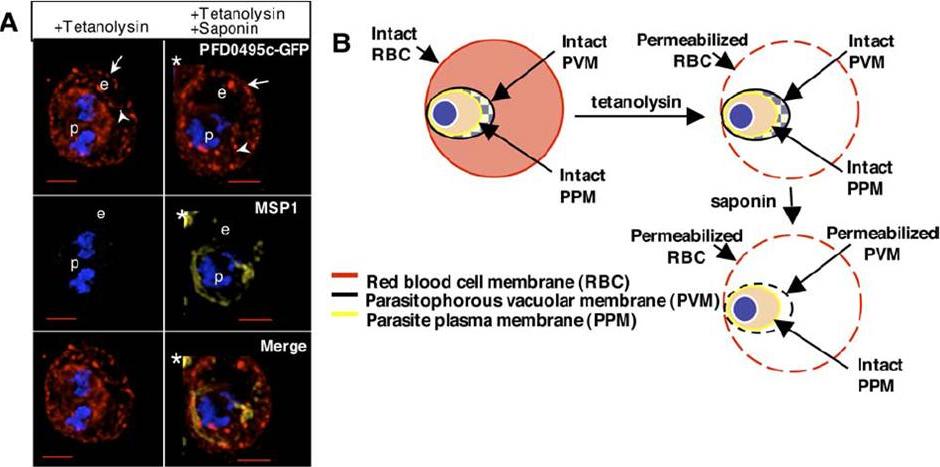
The C-terminus of PFD0495c functions within the erythrocyte cytoplasm and mediates interactions important forintraerythrocytic development. (A) Topology of PFD0495c in transgenic clone 1 parasites. C-terminus of PFD0495c-GFP is localized to erythrocyte cytoplasmic face. Anti-GFP signal is detected after tetanolysin permeabilization. Control signal to PPM (aMSP-1) is detected only with saponin treatment. p, parasite; e, erythrocyte; arrow, erythrocyte membrane; arrowhead, intraerythrocytic vesicle/tubule. Asterisk marks neighboring cell. (B) Schematic of selective permeabilization experiment. Tetanolysin selectively permeabilizes only the erythrocyte plasma membrane, leaving the PVM intact. Only incombination with saponin will the PVM be permeabilized and control MSP1 antibodies gain access to epitope. If anti-GFP signal can be detected with tetanolysin alone, then the C-terminus is present on the cytoplasmic face of the erythrocyte.Tamez PA, Bhattacharjee S, van Ooij C, Hiller NL, Llinás M, Balu B, Adams JH, Haldar K. An erythrocyte vesicle protein exported by the malaria parasite promotes tubovesicular lipid import from the host cell surface. PLoS Pathog. 2008 Aug 8;4(8):e1000118.
See original on MMP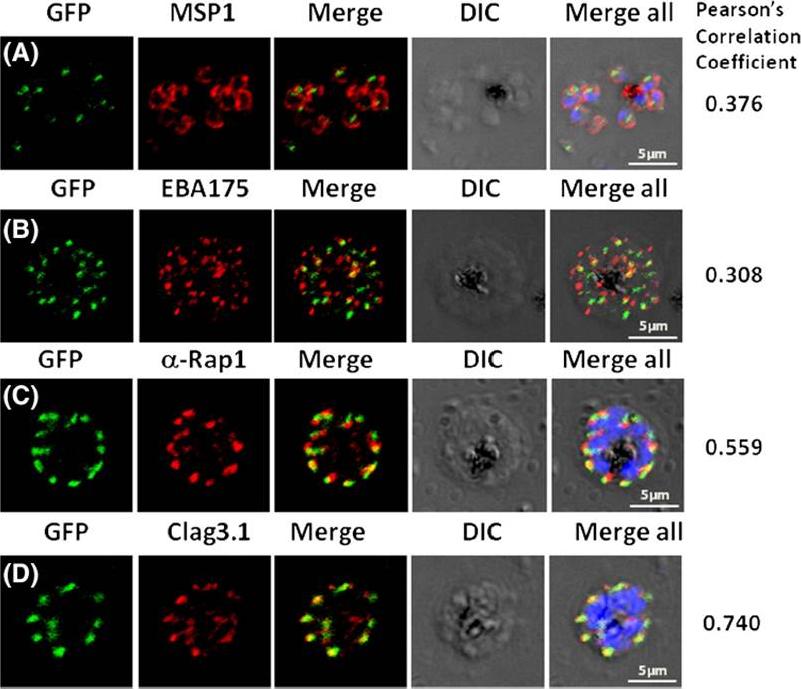
Pfμ1 co-localizeswith rhoptrymarker proteins in schizont stage parasites. Transgenic parasites expressing Pfμ1–GFPwere immunostained with antibodies specific to the Merozoite surface localized MSP1 (A), Microneme localized EBA175 (B), and Rhoptry localized RAP1 (C) and Clag3.1 (D). The parasite nuclei were stained with DAPI and slides were visualized by confocal microscopy. Representative images are shown for each antibody, together with DIC images; scale bars denote 5 μM. To quantify co-localisation, Pearson correlation coefficients of the individual stains were calculated and are shown in the right panel of each image. IFA with antibodies to rhoptry (RAP1 and Clag3.1), microneme (EBA175), and surface markers (MSP1). IFAwith anti-MSP1 antibody showed no overlap in staining betweenMSP1 and Pfμ1 (A). Similar results were seen with antibodies to EBA175 (B). Importantly, anti-RAP1 and anti-Clag3.1 showed co-localization with the Pfμ1–GFP chimeric protein (C and D), suggesting a potential role for Pfμ1 in rhoptry trafficking. Co-localization between Pfμ1 and RAP1 was first observed ~24 h post invasion in budding vesicles near the Golgi. As nuclear division commenced (32 h), Golgi multiplication occurred as well, and this resulted in apical distribution of Pfμ1 along with RAP1 in the rhoptries. Kaderi Kibria KM, Rawat K, Klinger CM, Datta G, Panchal M, Singh S, Iyer GR, Kaur I, Sharma V, Dacks JB, Mohmmed A, Malhotra P. A role for adaptor protein complex 1 in protein targeting to rhoptry organelles in Plasmodium falciparum. Biochim Biophys Acta. 2015 1853(3):699-710.
See original on MMP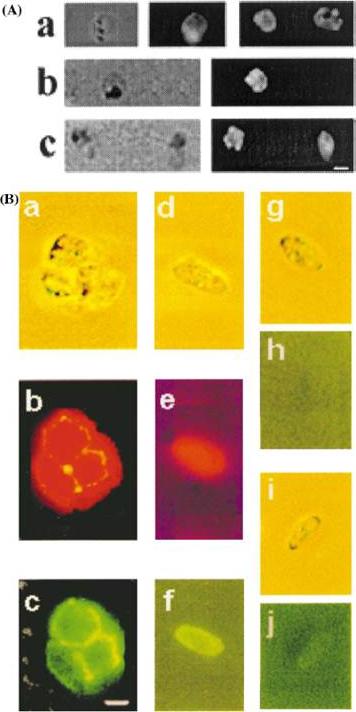
Immunofluorescence microscopy of P. falciparum merozoites and sexual stages. Upper panel A: fresh merozoite preparations were treated with anti-PfP0N (a, N-terminal), anti-PfP0C (b, C-terminal) and anti-MSP1 antibodies, each at a dilution of 1:50. Bound antibodies were visualized with anti-rabbit IgG-FITC secondary antibodies. The left hand panels show the bright field, and the right hand panels show the immunofluorescence. Bar corresponds to 1 mm. Lower Panel B: co-staining immunofluorescence analysis of macro gametes and red cell-free gametocytes. Panel a (bright field); b and c (corresponding immunofluorescent images) of a clump of two gametes and one gametocyte. Panel d (bright field), e and f (corresponding immunofluorescent images) of a single gametocyte. Panel g and i are the bright fields showing a gametocyte, while h andj are the corresponding immunofluorescent images, respectively.Panels a–f show the parasites treated with rabbit anti-PfP0N and Mab anti-Pfs230 [21]; g and h are gametocytes treated with rabbit pre-immune sera, and i and j are gametocytes treated with Mab anti-Pfg27, an internal marker of sexual stages . Anti-PfP0N was visualized with anti- rabbit IgG rhodamine secondary antibodies (b, e), while the monoclonal antibodies were visualized with anti-mouse IgG-FITC secondary antibodies (c, f and j). Rabbit pre-immune serum (panel h) was visualized with anti-rabbit IgG-FITC. All antibodies were used at 1:100 dilution. Bar corresponds to 5 mm.Chatterjee S, Singh S, Sohoni R, Kattige V, Deshpande C, Chiplunkar S, Kumar N, Sharma S. Characterization of domains of the phosphoriboprotein P0 of Plasmodium falciparum. Mol Biochem Parasitol. 2000 107(2):143-54.
See original on MMP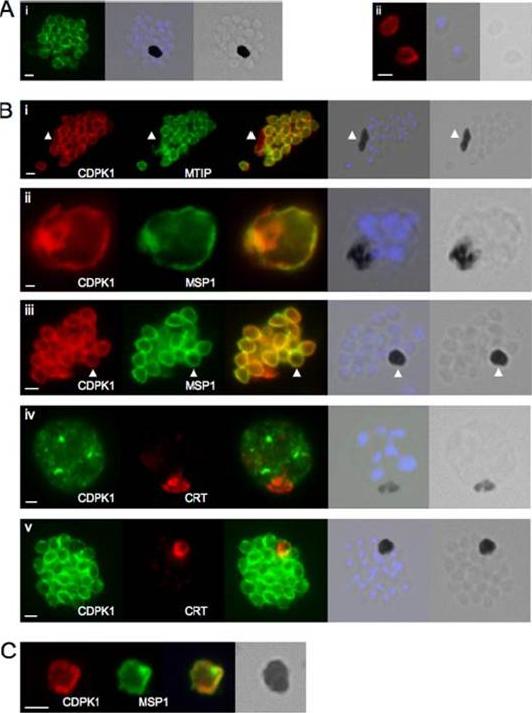
CDPK1 localizes to the plasma membrane of merozoites. A, an anti-CDPK1 antibody detects CDPK1 at the parasite periphery in schizonts (panel i) and free merozoites (panel ii). The second panel shows a merged image of nuclear staining with 4’,6’-diamino-2-phenylindole (blue) and the bright field image, and the third panel shows the bright field image. B, panel i, CDPK1 colocalizes with MTIP around the periphery of merozoites but is also found around the residual body, marked with an arrowhead, from which MTIP is absent. In young (panel ii) and segmented (panel iii) schizonts, CDPK1 colocalizes with the plasma membrane marker MSP1. Both proteins are also detected around the residual body, marked with an arrowhead. CDPK1 does not colocalize with the food vacuole marker PfCRT in either immature (panel iv) or mature (panel v) schizonts. The third panels in all of the images show the merged images of the antibody staining, beside which is a merged image of the bright field image and the nuclei of the parasites stained with 4’,6’-diamino-2-phenylindole (blue), followed by the bright field image alone. C, both CDPK1 (red) and MSP1 (green) can be detected on residual bodies that are released upon schizont rupture. The merged images of the antibody staining are shown in the third panels, followed by the bright field image. In all cases the white scale bar in the first panel of each set of images represents 1 mm.Green JL, Rees-Channer RR, Howell SA, Martin SR, Knuepfer E, Taylor HM, Grainger M, Holder AA. The motor complex of Plasmodium falciparum: phosphorylation by a calcium-dependent protein kinase. J Biol Chem. 2008 7;283(45):30980-9. PMID:
See original on MMP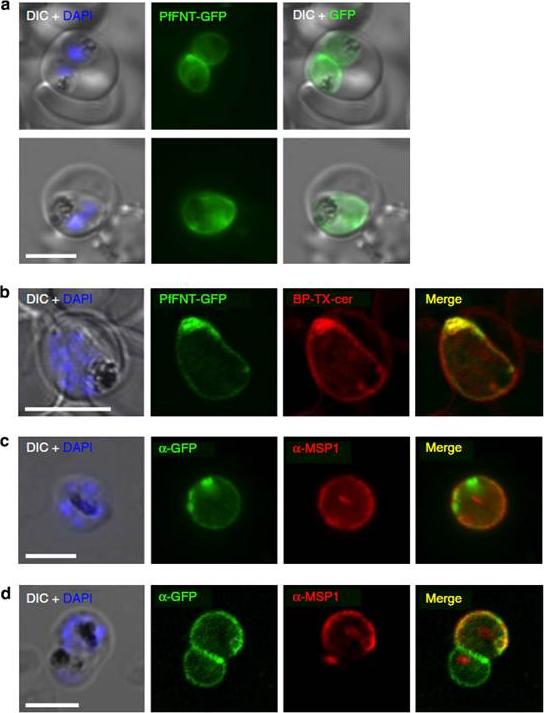
Localization of PfFNT in infected erythrocytes. (a) Fluorescence pattern of live, PfFNT-GFP expressing early (top panel) and late trophozoites (bottom panel) within erythrocytes. DIC, differential interference contrast; DAPI (blue), nuclear stain; GFP (green). (b) A single confocal section through an infected erythrocyte. Bodipy-TX-ceramide (red), lipid membrane stain. (c,d) Co-localization in the plasma membrane of PfFNT-GFP with merozoite surface protein 1 (MSP1) by fluorescence microscopy (c) or a single confocal section (d) using anti-GFP and anti-MSP1 antibodies. Scale bars, 5 mm. Localization at the parasite’s periphery is consistent with a function of PfFNT in lactate and proton release.Wu B, Rambow J, Bock S, Holm-Bertelsen J, Wiechert M, Soares AB, Spielmann T, Beitz E. Identity of a Plasmodium lactate/H+ symporter structurally unrelated to human transporters. Nat Commun. 2015 6:6284
See original on MMP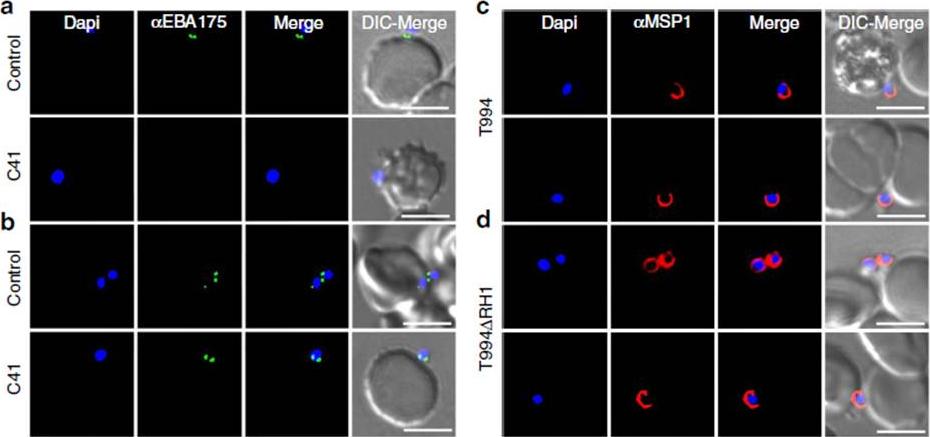
Effect of anti-PfRH1 inhibitory mAbs on merozoite surface expression of EBA175 during invasion. (a–d) Surface expression of EBA175 and MSP1 on T994 and T994DRH1 was detected by immunofluorescence assays. Isolated T994 (a,c) or T994DRH1 (b,d) merozoites were directly incubated with erythrocytes containing 4 mM Cyto D in the absence (Control) and presence (C41) of C41 (0.2mgml1) before analysis of expression of EBA175 and MSP1 at the junction. Both differential interference contrast (DIC) and fluorescence images were captured. Nuclear DNA was counterstained with DAPI (blue). EBA175 is shown in green, whereas MSP1 is shown in red. Fluorescence images, merged fluorescence images (DAPI and green or DAPI with red) and merged fluorescence images with DIC images are shown. Scale bars=10 mM. Antibody C41 blocks surface expression of EBA175 in T994 (a lower panel), whereas it has no effect on T994DRH1 parasites (b lower panel). In the absence of C41, EBA175 is expressed on the surface of both T994 and T994DRH1 (upper panels a,b). Ab has no effect on the detection of MSP1 on the surface of merozoites (c,d).Gao X, Gunalan K, Yap SS, Preiser PR. Triggers of key calcium signals during erythrocyte invasion by Plasmodium falciparum. Nat Commun. 2013;4:2862.
See original on MMP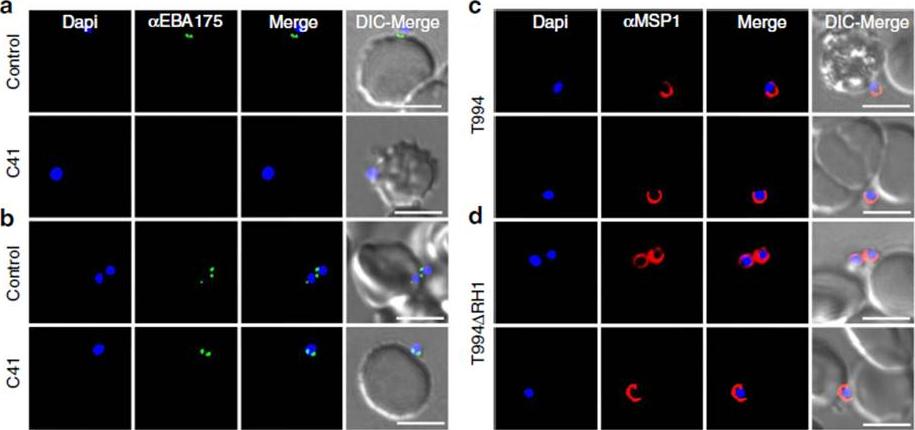
Effect of anti-PfRH1 inhibitory mAbs on merozoite surface expression of EBA175 during invasion. Isolated T994 (a,c) were directly incubated with erythrocytes containing 4 mM Cyto D in the absence (Control) and presence (C41) of C41 (0.2mgml-1) before analysis of expression of microneme protein EBA175 and merozoite surface marker MSP1 at the junction. Both differential interference contrast (DIC) and fluorescence images were captured. Nuclear DNA was counterstained with DAPI (blue). EBA175 is shown in green, whereas MSP1 is shown in red. Fluorescence images, merged fluorescence images (DAPI and green or DAPI with red) and merged fluorescence images with DIC images are shown. Scale bars=10 mm.Gao X, Gunalan K, Yap SS, Preiser PR. Triggers of key calcium signals during erythrocyte invasion by Plasmodium falciparum. Nat Commun. 2013;4:2862. PMID:
See original on MMP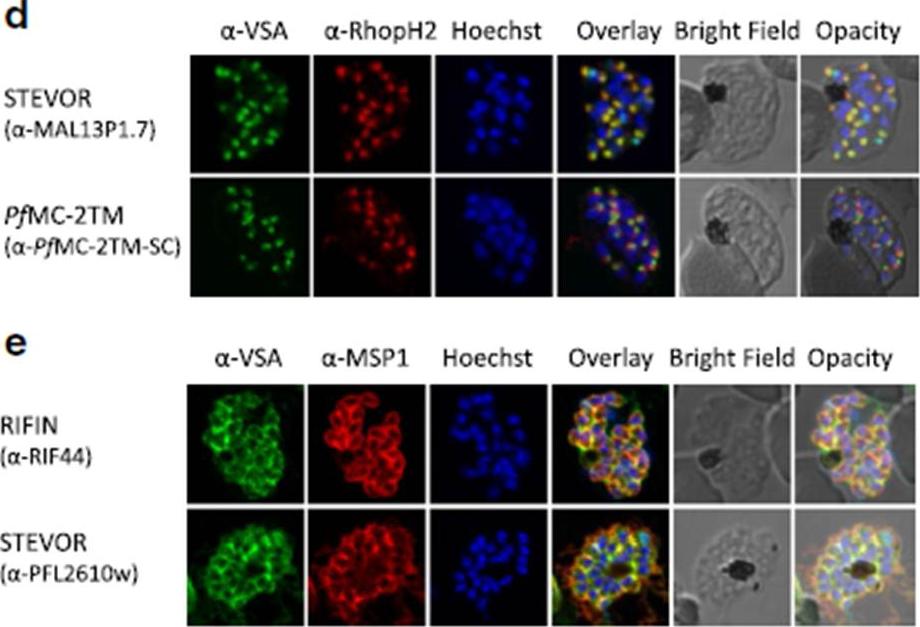
d Co-localization of STEVOR α-MAL13P1.7 or α-PfMC-2TM-SC (green) with the rhoptry marker RhopH2 (red). e Co-localization of α-RIF44 and STEVOR α-PFL2610w (green) with the merozoite surface protein MSP1 (red). Variant surface antigens (VSA).Bachmann A, Scholz JA, Janßen M, Klinkert MQ, Tannich E, Bruchhaus I, Petter M. A comparative study of the localization and membrane topology of members of the RIFIN, STEVOR and PfMC-2TM protein families in Plasmodium falciparum-infected erythrocytes. Malar J. 2015 Jul 14:274.
See original on MMP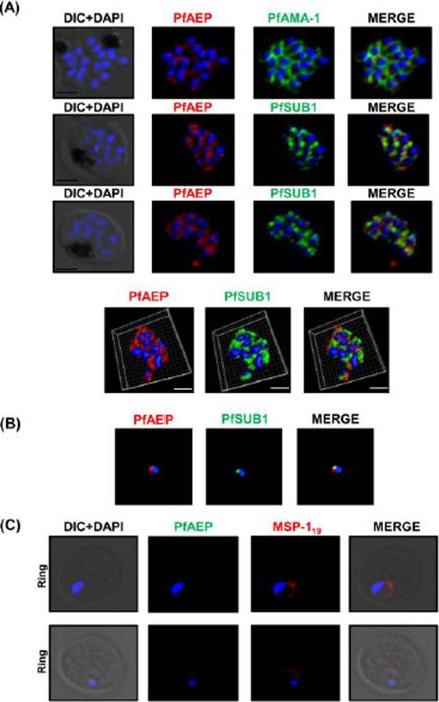
Localization of PfAEP in the exonemes of merozoites (A) Co-localization of PfAEP was studied with micronemal resident protein AMA-1 in bursting schizonts. PfAEP (rabbit serum; red) does not co-localize with AMA-1 (green). The staining for PfAEP co-localized with exonemal marker PfSUB1. Scale bar 2 mm. Three-dimensional reconstruction of the confocal z-stack images of schizonts is shown in panel below Scale bar 1.5mm (B) 2D-structured illumination microscopy (SIM) showed co-localization between the staining of PfAEP and PfSUB1 indicating its localization in the exonemes of P. falciparum merozoites. (C) Young rings were immunostained with anti PfAEP antibody and the antibody against MSP119 as a positive control. No staining was observed for PfAEP in young rings whereas MSP119 showed typical disk like staining around the nucleus.Hans N, Relan U, Dubey N, Gaur D, Chauhan VS. Identification and localization of a Novel Invasin of Plasmodium falciparum. Mol Biochem Parasitol. 2015 Sep 29. [Epub ahead of print]
See original on MMP
PfAEP localization in schizont stages analyzed by confocal microscopy. Subcellular localization of PfAEP was studied by co-staining with antibodies against micronemal protein EBA-175 (B), rhoptry bulb protein PTRAMP (C), and rhoptry neck,apical asparagine rich protein (AARP) (D), apical rhoptry neck protein (ARNP) (E), and merozoite surface protein (MSP) (F).As a control, pre-immune serum of PfAEP was checked and no staining was observed in schizonts (A). Mature schizonts were costained with anti-PfAEP (green) and anti-EBA-175, TRAMP, AARP, ARNP, MSP-119 antibodies (red). The nuclei of schizonts were stained with DAPI (blue) and visualized by Nikon N-SIM confocal microscope. All apical marker proteins and PfAEP showed punctate staining in schizonts distinct from DAPI. Co-staining of PfAEP with surface marker MSP-119 showed PfARNP localized at the apical tip with surface of merozoites stained by MSP-119. PfAEP staining did not merge with either markers of microneme or rhoptry indicating that PfAEP is neither a resident of micronemes or rhoptry ofmerozoites. Scale bar 2 mm.Hans N, Relan U, Dubey N, Gaur D, Chauhan VS. Identification and localization of a Novel Invasin of Plasmodium falciparum. Mol Biochem Parasitol. 2015 Sep 29. [Epub ahead of print]
See original on MMP
(B) Immunofluorescence analysis (IFA) of parental 3D7 and FCB1 schizonts, as well as 3D7 schizonts harboring the constructs in the indicated concentrations of blasticidin. Parasites were probed with MSP1 isoform-specific antibodies. Merged signals include that of the DNA dye 4,6-diamidino-2-phenylindole (DAPI, blue). Scale bar, 5 mm.Das S, Hertrich N, Perrin AJ, Withers-Martinez C, Collins CR, Jones ML, Watermeyer JM, Fobes ET, Martin SR, Saibil HR, Wright GJ, Treeck M, Epp C, Blackman MJ. Processing of Plasmodium falciparum Merozoite Surface Protein MSP1 Activates a Spectrin-Binding Function Enabling Parasite Egress from RBCs. Cell Host Microbe. 2015 18(4):433-44. PMID:
See original on MMP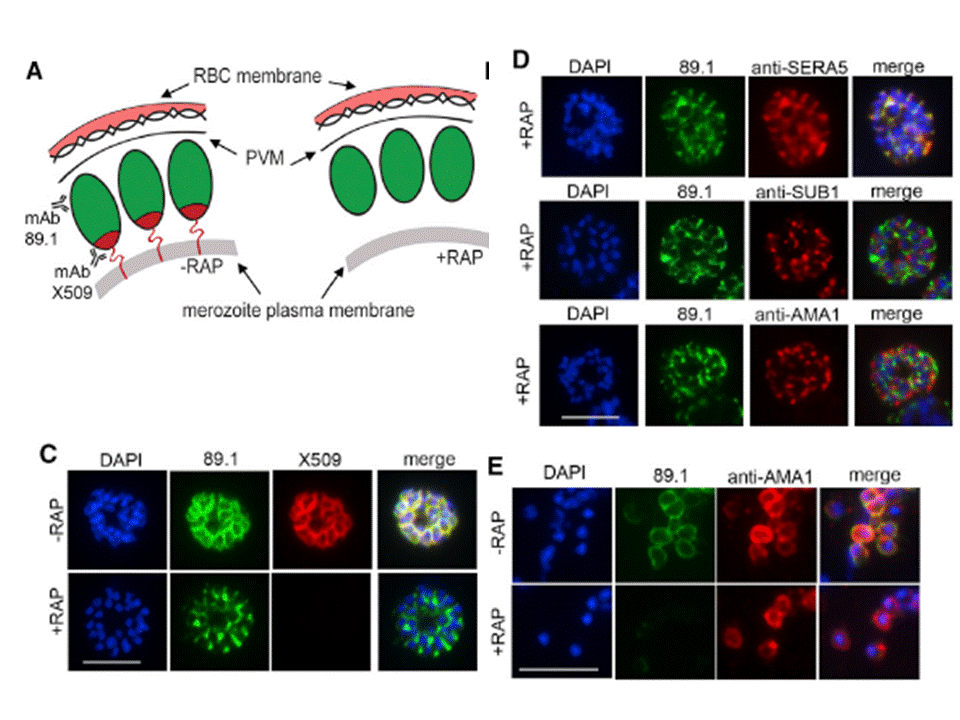
Truncation of MSP1 Produces anEgress Defect (A) Predicted RAP-induced MSP1 truncation in the 3D7MSP1flox42C clones, showing loss of the GPI anchor and C-terminal domain containing the mAb X509 epitope. (C) RAP treatment produces a loss of mAb X509 reactivity and a shift in the IFA pattern of MSP1 to one typical of PV proteins, consistent with the predicted truncation. Numbers of DAPI-stained nuclei did not differ between control and RAPtreated. (D) IFA showing co-localization of truncated MSP1 with SERA5 indicating a PV location. The punctate localization of SUB1 and the microneme protein AMA1 indicates normal organelle biogenesis. (E) IFA showing lack of surface-bound MSP1 on merozoites of RAP-treated 3D7MSP1flox42C1 clone E3. Antibodies to AMA1 (which is expressed on free merozoites) were used as a control.Das S, Hertrich N, Perrin AJ, Withers-Martinez C, Collins CR, Jones ML, Watermeyer JM, Fobes ET, Martin SR, Saibil HR, Wright GJ, Treeck M, Epp C, Blackman MJ. Processing of Plasmodium falciparum Merozoite Surface Protein MSP1 Activates a Spectrin-Binding Function Enabling Parasite Egress from RBCs. Cell Host Microbe. 2015 18(4):433-44.
See original on MMP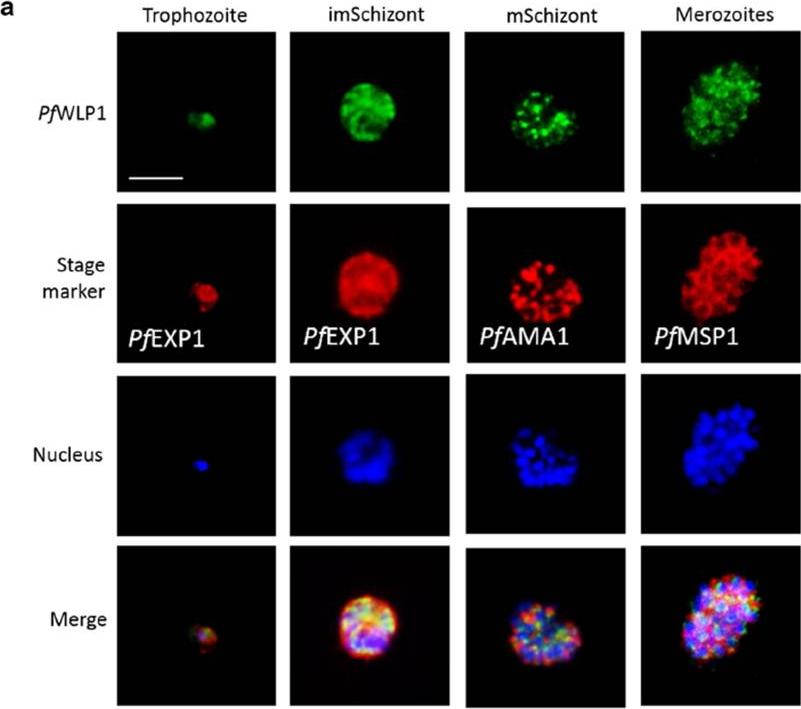
PfWLP1 is expressed in the asexual blood stages of Plasmodium falciparum. a Expression of PfWLP1 in the asexual blood stages. PfWLP1 was immunolabelled with anti-PfWLP1-rp2 antisera (green); the asexual blood stages were visualized with antisera against PfEXP1, PfAMA1 and PfMSP1 (red). The parasite nuclei were highlighted by Hoechst nuclear stain (blue). ImSchizont, immature schizont; mSchizont, mature schizont. Bar 5 μm. Data are representative of five independent experiments each.von Bohl A, Kuehn A, Simon N, Ngongang VN, Spehr M, Baumeister S, Przyborski JM, Fischer R, Pradel G. A WD40-repeat protein unique to malaria parasites associates with adhesion protein complexes and is crucial for blood stageprogeny. Malar J. 2015 Nov 4;14(1):435.
See original on MMP
PfWLP1 is expressed in the asexual blood stages of Plasmodium falciparum. Upper panel: Localization of PfWLP1 underneath the apical pole of merozoites. Image enlargements (right) of mature schizonts (left), labelled with antibodies against PfWLP1 (green) and PfMSP1 or PfAMA1 (red) and stained with Hoechst (blue). AP apical pole, N nucleus, MPM merozoite plasma membrane. Bar 5 μm. Data are representative of five independent experiments each. Lower panel: Expression of PfWLP1-HA in asexual blood stages. PfWLP1 expression in the PfWLP1-HA asexual blood stages. PfWLP1-HA was immunolabelled with anti-HA antisera (green); the asexual blood stages were visualized by Evans Blue counterstaining (red). The parasite nuclei were highlighted by Hoechst nuclear stain (blue),von Bohl A, Kuehn A, Simon N, Ngongang VN, Spehr M, Baumeister S, Przyborski JM, Fischer R, Pradel G. A WD40-repeat protein unique to malaria parasites associates with adhesion protein complexes and is crucial for blood stage progeny. Malar J. 2015 Nov 4;14(1):435.
See original on MMP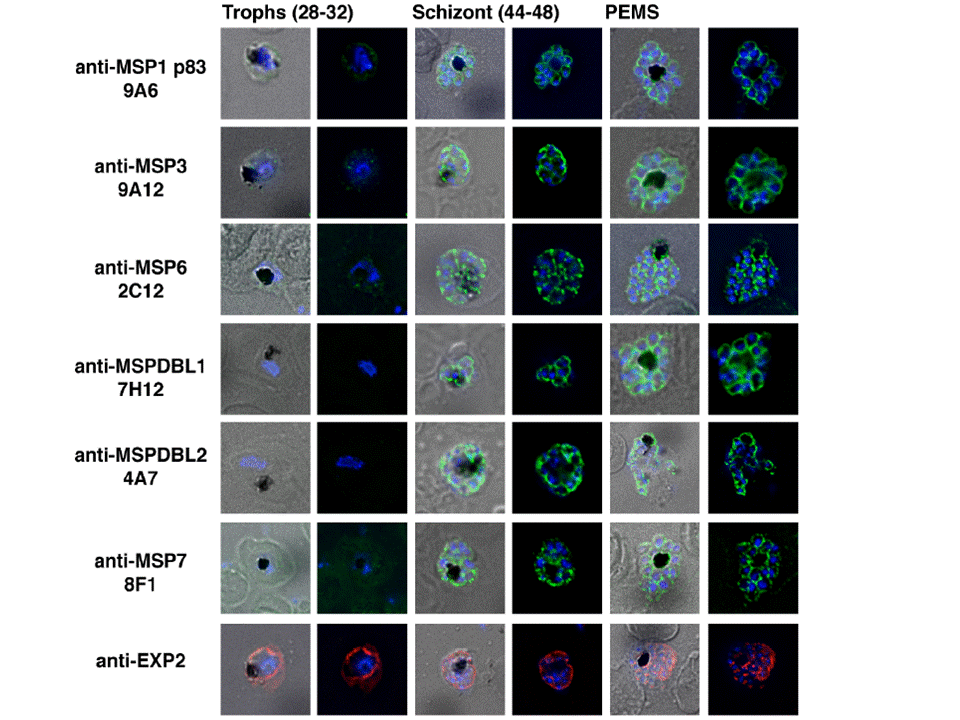
Processed Peripheral MSPs become part of an anchored complex late in schizogony. Immunofluorescence assays of Trophozoites (28-32 hr) in columns 1 (Phase + 488 + DAPI) and 2 (488 + DAPI), Schizonts (44-48 hr) in columns 3 (Phase + 488 + DAPI) and 4 (488 + DAPI) and PEMS (E64 treated) in columns 5 (Phase + 488 + DAPI) and 6 (488 + DAPI) were probed with monoclonal antibodies (green); 9A6 (anti-MSP1 p83), 9A12 (anti-MSP3), 2C12 (anti-MSP6), 7H12 (anti-MSPDBL1), 4A7 (anti-MSPDBL2) and 8F1 (anti-MSP7). EXP2 was used as an expression control probed with polyclonal rabbit anti-EXP2 antibodies (red). The nuclei of parasites are stained with DAPI (blue).Lin CS, Uboldi AD, Epp C, Bujard H, Tsuboi T, Czabotar PE, Cowman AF. Multiple P. falciparum Merozoite Surface Protein 1 Complexes Mediate Merozoite Binding to Human Erythrocytes. J Biol Chem. 2016 Jan 28. [Epub ahead of print] PMID:
See original on MMP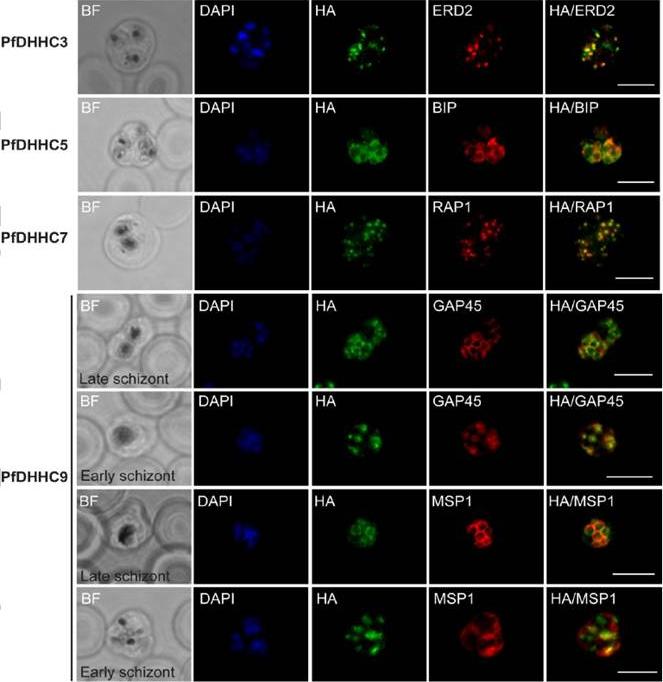
Expression and localisation of PfDHHC proteins in P. falciparum schizonts. Triple-HA-tagged PfDHHC proteins were localised by immunofluorescence using antibodies against the 3-HA tag (green). Immunofluorescence staining of each of the tagged PfDHHC proteins was compared against that of the following known localisation markers (red): ERD2 (Golgi marker), BIP (endoplasmic reticulum marker), RAP1 (rhoptry marker), GAP45 (inner membrane complex marker) and MSP1 (plasma membrane marker). Nuclear staining by DAPI is shown in blue. For the staining of PfDHHC9 with GAP45 and MSP1, both a late schizont, as well as an early schizont, is shown in order to differentiate between IMC and plasma membrane localisation. Scale bar: 5 μm.Tay CL, Jones ML, Hodson N, Theron M, Choudhary JS, Rayner JC. Study of Plasmodium falciparum DHHC palmitoyl-transferases identifies a role for PfDHHC9 in gametocytogenesis. Cell Microbiol. 2016 Apr 6.
See original on MMP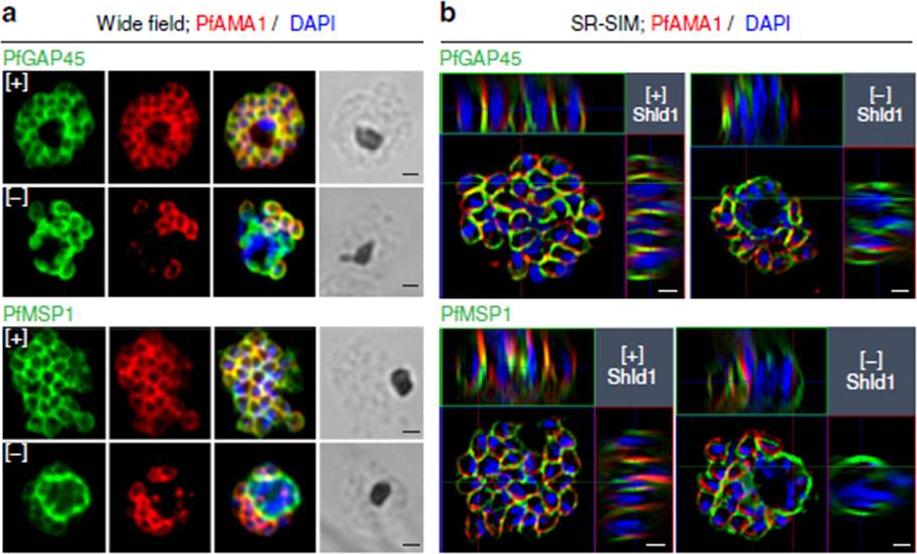
PfMOP deficiency leads to incomplete formation of the IMC. (a) Wide-field and (b) SR-SIM (super-resolution structured illumination microscopy) of representative pictures of E64-treated [+]/[-] Shld1 schizont stage PfMOP-DD parasites using antibodies against PfGAP45 and PfMSP1. Scale bar, 1 mm.Absalon S, Robbins JA, Dvorin JD. An essential malaria protein defines the architecture of blood-stage and transmission-stage parasites. Nat Commun. 2016 7:11449.
See original on MMP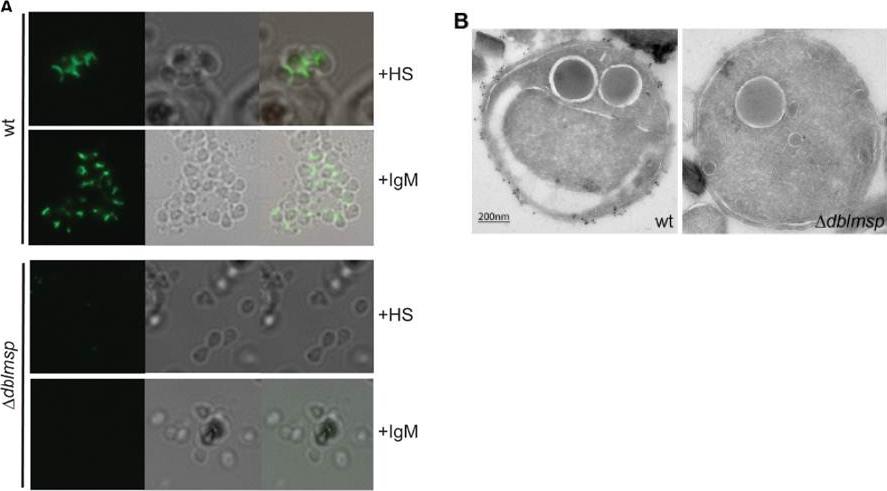
Reversible clustering of a GPI-anchored protein in compound treated trophozoite stage parasites. (A) Distribution of the GPIanchored protein MSP1 was examined by immunofluorescence assays in 32–34 h PMI (post merozoite invasion) trophozoite stage P. falciparum 3D7 exposed for 2 h to the vehicle (control), PA21A050 (10 nM) or KAE609 (10 nM). (B) After 2 h of the removal of the compounds, parasites largely restored the distribution of MSP1 throughout the PPM. (C) The compound-induced MSP1 clustering was not observed in parasites adapted to grow in low [Na+] medium following compound treatments for 2 h. (E) Immunogold labeling for MSP1 on a representative P. falciparum control parasite (upper panel), in which the gold particles are distributed throughout the parasite plasma membrane (PPM); and on a representative PA21A050-treated parasite (lower panel), in which the gold particles are clustered in one patch. Cryo-sections were labeled with the anti-MSP1 antibody, and binding revealed with protein A-gold particles (10 nm). PPM, Parasite plasma membrane; PVM, Parasitophorous vacuole membrane.Das S, Bhatanagar S, Morrisey JM, Daly TM, Burns JM Jr, Coppens I, Vaidya AB. Na+ Influx Induced by New Antimalarials Causes Rapid Alterations in the Cholesterol Content and Morphology of Plasmodium falciparum. PLoS Pathog. 2016 May 26;12(5):e1005647
See original on MMP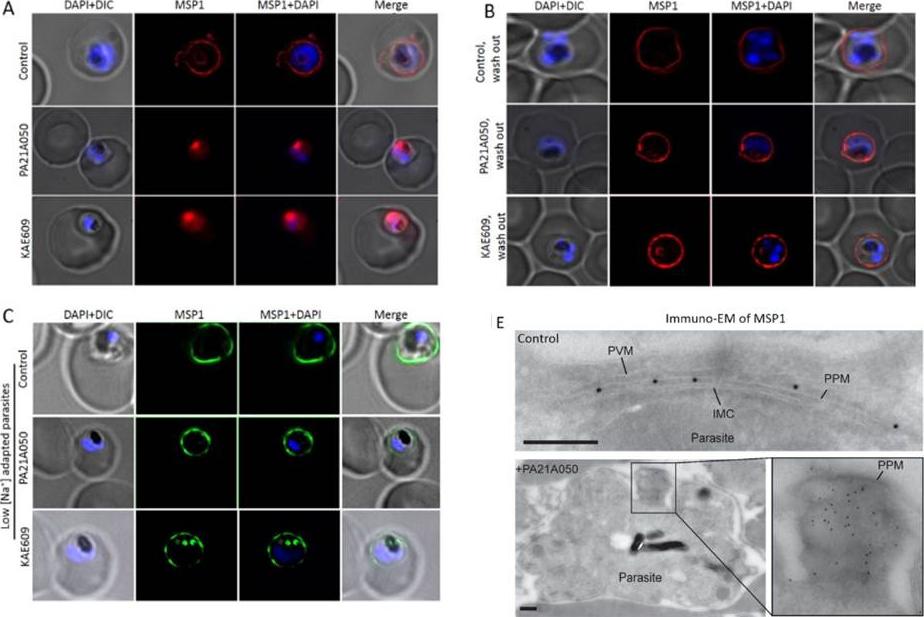
Reversible clustering of a GPI-anchored protein in compound treated trophozoite stage parasites. (A) Distribution of the GPIanchored protein MSP1 was examined by immunofluorescence assays in 32–34 h PMI (post merozoite invasion) trophozoite stage P. falciparum 3D7 exposed for 2 h to the vehicle (control), PA21A050 (10 nM) or KAE609 (10 nM). (B) After 2 h of the removal of the compounds, parasites largely restored the distribution of MSP1 throughout the PPM. (C) The compound-induced MSP1 clustering was not observed in parasites adapted to grow in low [Na+] medium following compound treatments for 2 h. (E) Immunogold labeling for MSP1 on a representative P. falciparum control parasite (upper panel), in which the gold particles are distributed throughout the parasite plasma membrane (PPM); and on a representative PA21A050-treated parasite (lower panel), in which the gold particles are clustered in one patch. Cryo-sections were labeled with the anti-MSP1 antibody, and binding revealed with protein A-gold particles (10 nm). PPM, Parasite plasma membrane; PVM, Parasitophorous vacuole membrane.Das S, Bhatanagar S, Morrisey JM, Daly TM, Burns JM Jr, Coppens I, Vaidya AB. Na+ Influx Induced by New Antimalarials Causes Rapid Alterations in the Cholesterol Content and Morphology of Plasmodium falciparum. PLoS Pathog. 2016 May 26;12(5):e1005647
See original on MMP
PfRA is present at the apical surface of an invading merozoite. Confocal immunofluorescencemicroscopy analysis of PfRA localization in cytochalasin-D treated invading merozoites under non-permeable fixing conditions using glutaraldehyde /paraformaldehyde. (A) 3D reconstruction of z-stacks during merozoite invasion co-immunostained with MSP-1and PfRA. PfRA detected at the apical end of the merozoite surface. In the 3D images, the γ settings were altered for visual representation only. (B) PfRA (green) co-localizes with rhoptry bulb marker PfRH5 (red) that is known to be translocated to the merozoite surface to engage with its erythrocyte receptor, Basigin. (C) As a control, staining of a nuclear parasite protein, NapL, was not detected under the same non-permeable fixing conditions confirming that the fluorescent signals were obtained only from surface localized proteins. Nuclei were stained with DNA intercalating dye DAPI (Scale bar, 2 μ m.)Anand G, Reddy KS, Pandey AK, Mian SY, Singh H, Mittal SA, Amlabu E, Bassat Q, Mayor A, Chauhan VS, Gaur D. A novel Plasmodium falciparum rhoptry associated adhesin mediates erythrocyte invasion through the sialic-acid dependent pathway. Sci Rep. 2016 6:29185.
See original on MMP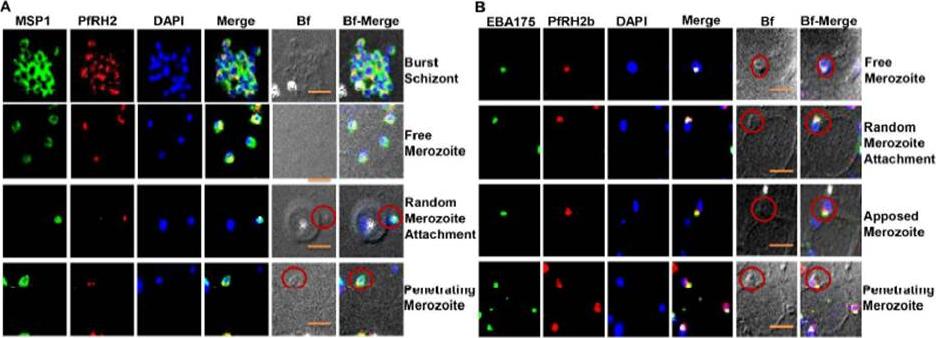
PfRH2b is associated with the moving junction during merozoite invasion. The process of merozoite invasion was closely monitored to locate the position of PfRH2b of burst schizont, free merozoites, random merozoite attachment, apposed merozoite and penetrating merozoite. (A) Merozoites were stained for MSP1 (MSP1, green) and PfRH2 (PfRH2, red). PfRH2 apical punctuate staining was observed in the free and attaching merozoites while in invading merozoites two punctuate staining were observed at the anchorage of the moving junction. The presence of PfRH2b (PfRH2b, red) at the moving junction was further confirmedwith EBA175 (B, green). Merozoites of focus are shown with red circles. In the merged images, areas of overlap between the red and the green signals are shown in yellow. DAPI (blue) stained for nuclei.Aniweh Y, Gao X, Gunalan K, Preiser PR. PfRH2b Specific Monoclonal Antibodies Inhibit Merozoite Invasion. Mol Microbiol. 2016 Jul 20. .
See original on MMP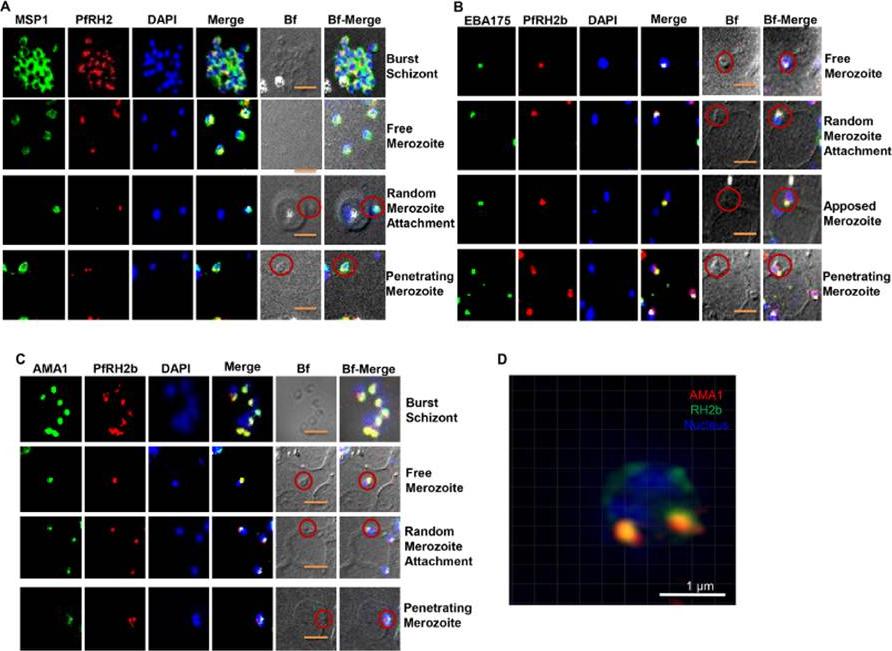
PfRH2b is associated with the moving junction during merozoite invasion. The process of merozoite invasion was closely monitored to locate the position of PfRH2b of burst schizont, free merozoites, random merozoite attachment, apposed merozoite and penetrating merozoite. A. Merozoites were stained for MSP1 (MSP1, green) and PfRH2 (PfRH2, red). PfRH2 apical punctuate staining was observed in the free and attaching merozoites while in invading merozoites two punctuate staining were observed at the anchorage of the moving junction. The presence of PfRH2b (PfRH2b, red) at the moving junction was further confirmed with EBA175 (B, green) and AMA1 (C, green) as common markers with punctuate staining. Merozoites of focus are shown with red circles. The bright field images labelled as Bf. Scale bar indicates 2 lm. D. A slice of a three-dimensional structured illumination microscopy (3D-SIM) on merozoite at the junction further confirmed the punctuated pattern of PfRH2b (green) to be in close proximity to AMA1 (red). Scale bar indicates 1 lm. In the merged images, areas of overlap between the red and the green signals are shown in yellow. DAPI (blue) stained for nuclei.Aniweh Y, Gao X, Gunalan K, Preiser PR. PfRH2b specific monoclonal antibodies inhibit merozoite invasion. Mol Microbiol. 2016 Nov;102(3):386-404.
See original on MMP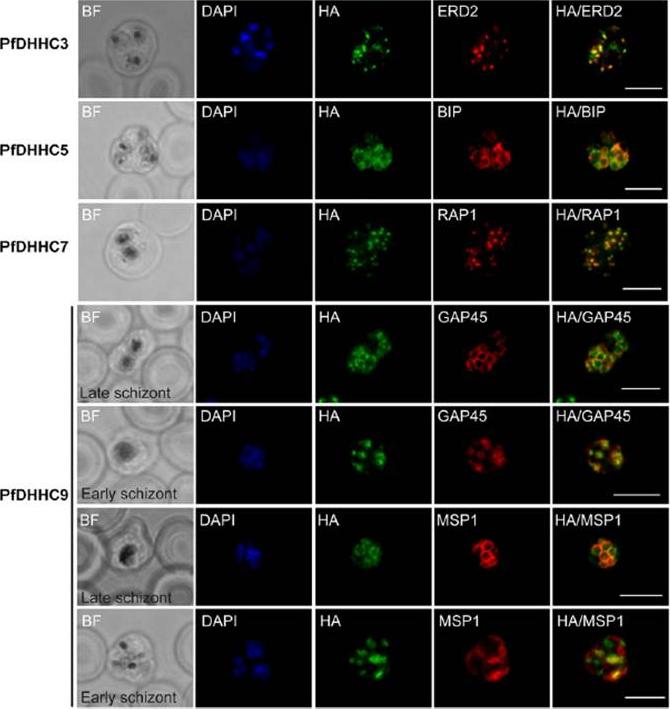
Expression and localization of PfDHHC proteins in Plasmodium falciparum schizonts. Triple-HA-tagged PfDHHC proteins were localized by immuno-fluorescence using antibodies against the 3-HA tag (green). Immunofluorescence staining of each of the tagged PfDHHC proteins was compared against that of the following known localization markers (red): ERD2 (Golgi marker), BIP (endoplasmic reticulum marker), RAP1 (rhoptry marker), GAP45 (inner membrane complex marker) and MSP1 (plasma membrane marker). Nuclear staining by DAPI is shown in blue. For the staining of PfDHHC9 with GAP45 and MSP1, a late schizont, as well as an early schizont, is shown in order to differentiate between inner membrane complex and plasma membrane localization. Scale bar: 5 μm.Tay CL, Jones ML, Hodson N, Theron M, Choudhary JS, Rayner JC. Study of Plasmodium falciparum DHHC palmitoyl transferases identifies a role for PfDHHC9 in gametocytogenesis. Cell Microbiol. 2016 18(11):1596-1610.
See original on MMP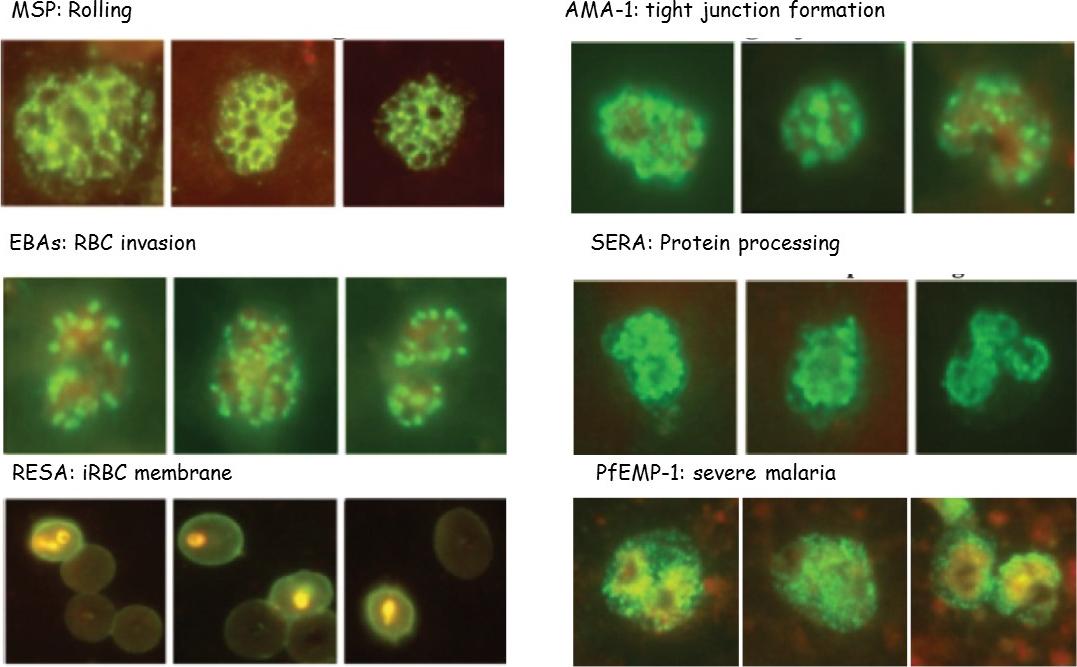
P. falciparum merozoite protein location is shown, as determined by IFA and functions: rolling on the membrane by MSPs, TJ formation mediated by AMA-1-and apical rhoptries proteins, RBC deformation and invasion by microneme EBAs, protein processing by intracytoplasmic SERA-5, iRBC membrane expression by RESA and severe malaria (SM) and echinocytosis by PfEMP-1.Patarroyo ME, Arevalo-Pinzon G, Reyes C, Moreno-Vranich A, Patarroyo MA. Malaria Parasite Survival Depends on Conserved Binding Peptides' Critical Biological Functions. Curr Issues Mol Biol. 2016;18:57-78.
See original on MMP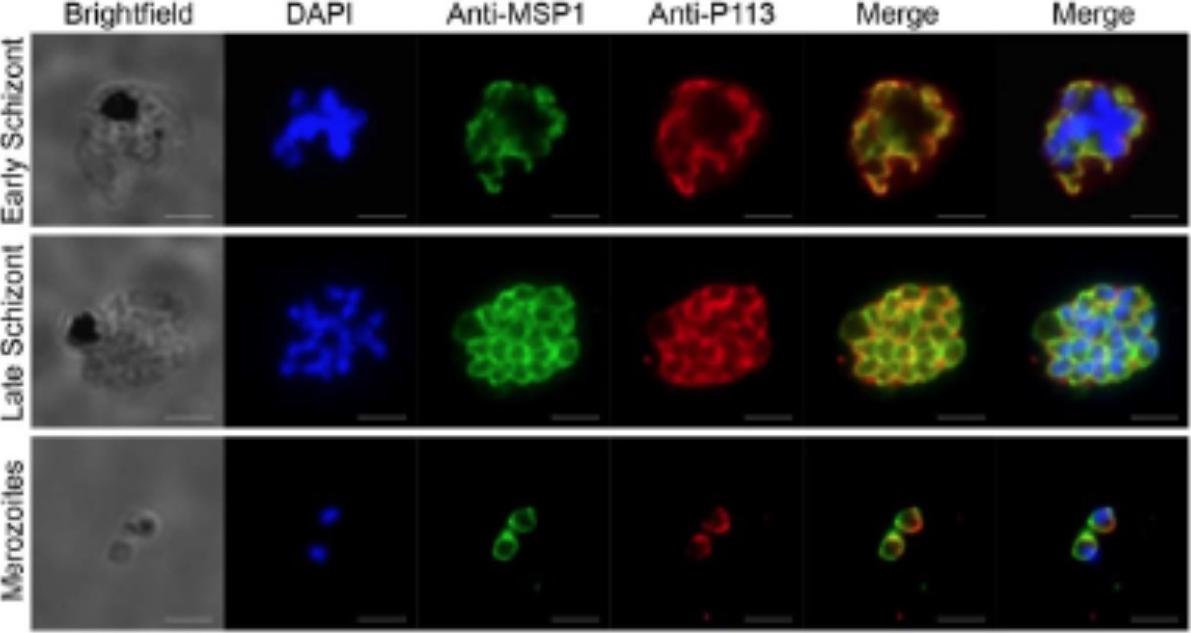
P113 is expressed in both early and late-stage P. falciparum schizonts and on the merozoite surface. Fixed blood stage P. falciparum schizonts and free merozoites were co-stained with antibodies raised to P113 and the merozoite surface marker anti-MSP1 (a), or an inner membrane complex marker, MTIP (b) as indicated. Nucleic acid is stained with DAPI and scale bars represent 3μm.Galaway F, Drought LG, Fala M, Cross N, Kemp AC, Rayner JC, Wright GJ. P113 is a merozoite surface protein that binds the N terminus of Plasmodium falciparum RH5. Nat Commun. 2017 8:14333.
See original on MMP
Expression and co-localization of proteins of Pfs38 complex on Plasmodium merozoites. Co-localization studies were performed by immunofluorescence assays. Merozoites were labelled with (a) mouse anti-Pfs38 and rabbit anti-GLURP or with (b) mouse anti-Pfs38 and rabbit anti-Pfs41 antibodies or with (c) mouse anti-Pfs38 and rabbit anti-Pfs12 antibodies or with (d) mouse anti-Pfs38 and rabbit anti-PfsMSP165 antibodies. Partial co-localization was observed between Pfs38 and other proteins of 6-Cys complex with co-localization coefficient of 0.75, 0.61, 0.82, and 0.83 for a–d, respectively. Td represent bright field images. Pfs38 partially co-localized with GLURP, Pfs41, Pfs12, and MSP-1, advocating the co-existence of proteins of 6-Cys protein complex on the merozoite surface (Fig. 3a–d). These results were corroborated by cosedimentation analysis of parasite-derived polypeptides. Western blotting and LC–MS/MS analysis of the glycerol gradient fractions revealed the presence of Pfs38, Pfs41, Pfs12, GLURP, MSP-1, and SERA5 in a single fraction, suggesting that these proteins exist in a complex on the parasite.Paul G, Deshmukh A, Kaur I, Rathore S, Dabral S, Panda A, Singh SK, Mohmmed A, Theisen M, Malhotra P. A novel Pfs38 protein complex on the surface of Plasmodium falciparum blood-stage merozoites. Malar J. 2017 16(1):79
See original on MMP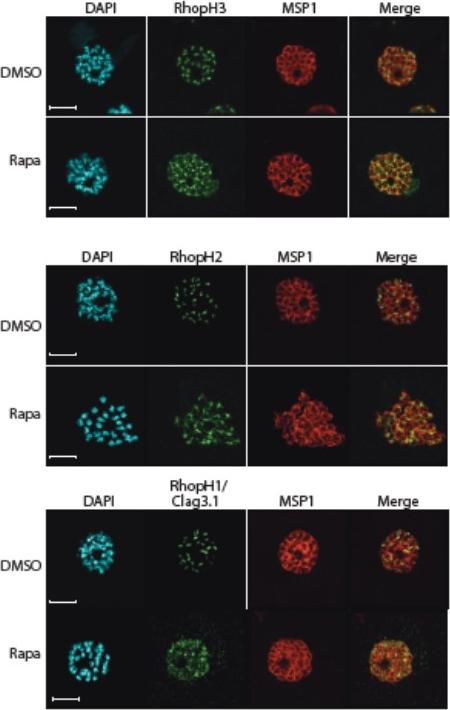
Truncation of RhopH3 leads to mistrafficking of components of the RhopH complex. IFA of mature schizonts of control (DMSO) and rapamycin-treated rhopH3-loxP parasites, probed with MSP1-specific antibodies (either mAb 89.1 or rabbit polyclonal anti-MSP1 antibodies; red) and antibodies to the three indicated RhopH components (green). Mis-localisation of the RhopH proteins was observed in all cases, and in the case of RhopH3 the protein often appeared to reside external to the plasma membrane of intracellular merozoites. Parasite nuclei were visualized by staining with DAPI. Note that, for clarity, the merge panels do not include the DAPI signal. Scale bar, 5 μm.Sherling ES, Knuepfer E, Brzostowski JA, Miller LH, Blackman MJ, van Ooij C. The Plasmodium falciparum rhoptry protein RhopH3 plays essential roles in host cell invasion and nutrient uptake. Elife. 2017 6. pii: e23239.
See original on MMP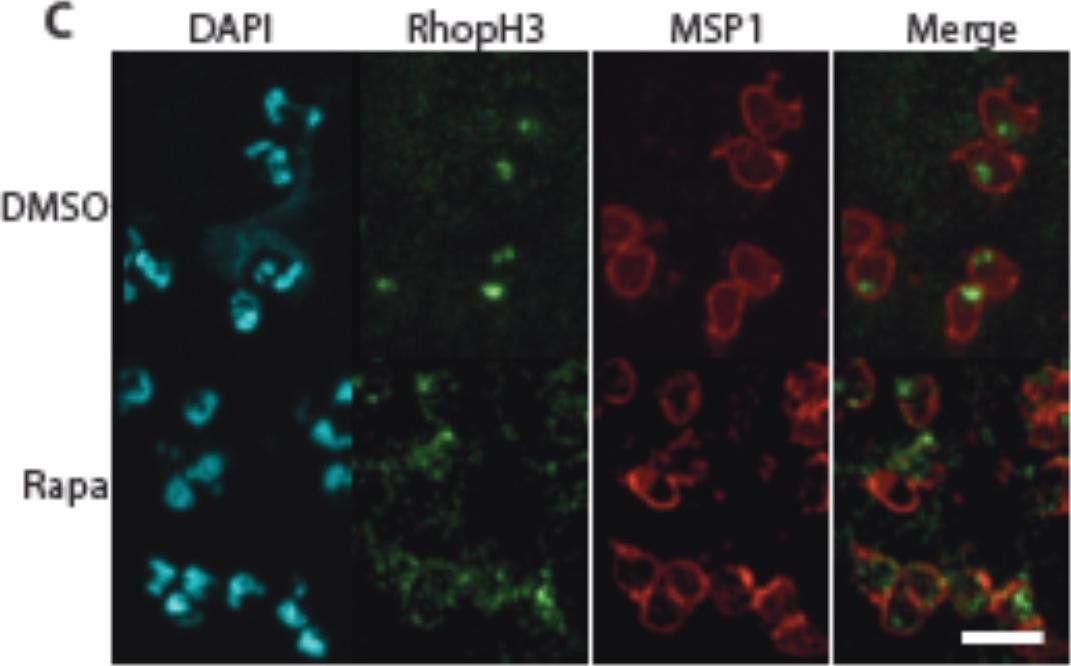
Truncation of RhopH3 leads to mistrafficking of components of theRhopH complex and loss of complex formation. Mislocalisation and reduced levels of RhopH3 in naturally released free merozoites of rhopH3-loxP parasites treated with rapamycin. Samples were probed with a monoclonal antibody to the merozoite surface marker MSP1 as well as anti-RhopH3 antibodies. Scale bar, 2 μm. IFA of naturally released free merozoites showed that the truncated RhopH3Δ4-6 was often largely undetectable in merozoites of the mutant Parasites.Sherling ES, Knuepfer E, Brzostowski JA, Miller LH, Blackman MJ, van Ooij C. The Plasmodium falciparum rhoptry protein RhopH3 plays essential roles in host cell invasion and nutrient uptake. Elife. 2017 6. pii: e23239.
See original on MMP
Generation of transgenic parasites in which RhopH2 is epitope-tagged. Immunofluorescence analysis (IFA) on schizonts fixed with acetone/methanol and labelled with anti-HA antibody to detect RhopH2 and other antibodies, as indicated. Immunofluorescence analysis (IFA) confirmed RhopH2-HA localized to the rhoptry and co-localized with other rhoptry bulb proteins, RhopH1, RhopH3 and RAMA but not with the rhoptry neck protein, RON4, the micronemal marker, AMA-1 or the plasma membrane protein MSP1.Counihan N, Chisholm SA, Bullen HE, Srivastava A, Sanders PR, Jonsdottir TK, Weiss GE, Ghosh S, Crabb BS, Creek DJ, Gilson PR, de Koning-Ward TF. Plasmodium falciparum parasites deploy RhopH2 into the host erythrocyte to obtain nutrients, grow and replicate. Elife. 2017 Mar 2;6. pii: e23217
See original on MMP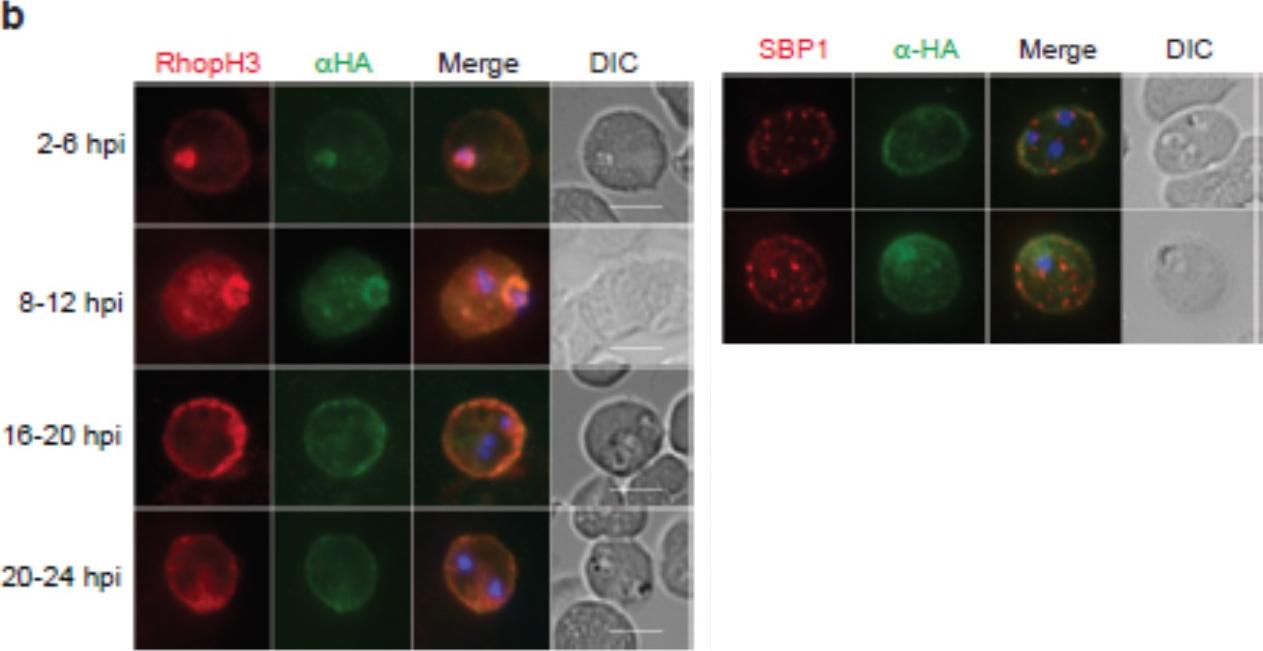
Expression, localisation and solubility profile of P. falciparum RhopH2. Immunofluorescence analysis (IFA) on erythrocytes infected with PfRhopH2-HAglmS and fixed with acetone/methanol. RhopH2 is labeled with the anti-HA antibody. The bars represent 5 μm. (c) IFA on erythrocytes infected with PfRhopH2-HAglmS, fixed with acetone/methanol and probed with anti-HA (for RhopH2) and antibodies to the Maurer’s cleft protein SBP1 show that RhopH2 and SBP1 do not co-localize.Counihan N, Chisholm SA, Bullen HE, Srivastava A, Sanders PR, Jonsdottir TK, Weiss GE, Ghosh S, Crabb BS, Creek DJ, Gilson PR, de Koning-Ward TF. Plasmodium falciparum parasites deploy RhopH2 into the host erythrocyte to obtain nutrients, grow and replicate. Elife. 2017 Mar 2;6. pii: e23217.
See original on MMP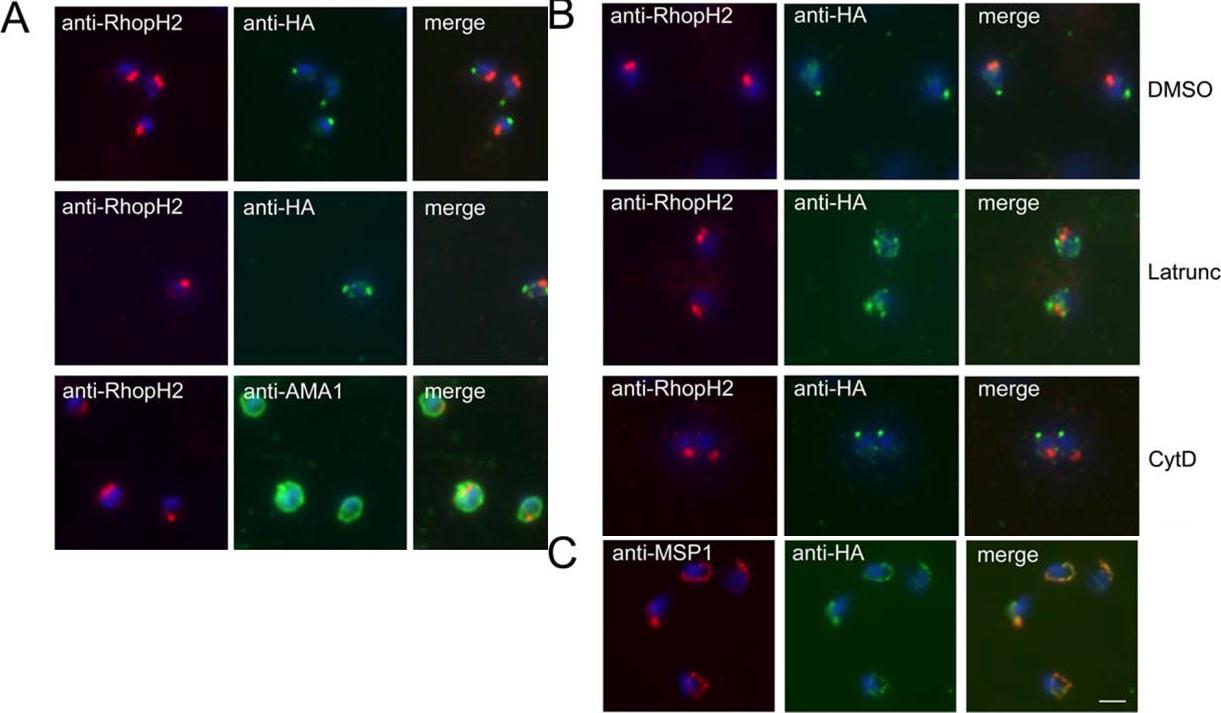
PfSUB2 Redistributes to the Free Merozoite Posterior in an Actin-Dependent Manner. (A) IFA images of free merozoites of PfSUB2HA clone 2D dual-labelled with mAb 61.3 (anti-RhopH2) and either mAb 3F10 (anti-HA) or 4G2 (anti-AMA1). The anti-HA signal formed either a single punctate signal at the extreme posterior of the merozoite (top), or twin foci lateral to its anterior–posterior axis (middle). Identical results were obtained using PfSUB2HA clone 10E, or using anti-RAP2 mAb H5 as the rhoptry marker (not shown). (B) Latrunculin inhibits rearward translocation of PfSUB2. Merozoites of PfSUB2HA clone 2D released into medium containing 1% (v/v) DMSO only (solvent control), or 5 mM latrunculin A (Latrunc), or 4 mM cytochalasin D (Cyt D), probed as above with mAb 61.3 (anti-RhopH2) and mAb 3F10 (anti-HA). Note that neither compound had any effect on the efficiency of schizont rupture and merozoite release, nor on AMA1 relocalisation, but both blocked erythrocyte invasion by more than 95%at the concentrations used (not shown). (C) PfSUB2 remains at the plasma membrane of the newly invaded parasite. Ring stages of PfSUB2HA clone 2D (<2 h post-invasion) probed with anti-MSP1 mAb 1E1 and anti-HA mAb 3F10. Parasite nuclei are stained throughout with DAPI (blue). Scale bar represents 2 mm.Harris PK, Yeoh S, Dluzewski AR, O'Donnell RA, Withers-Martinez C, Hackett F, Bannister LH, Mitchell GH, Blackman MJ. Molecular identification of a malaria merozoite surface sheddase. PLoS Pathog. 2005 Nov;1(3):241-51.
See original on MMP
PfSUB2 Is a Microneme Protein. (A) IFA images of schizonts of PfSUB2HA clone 2D dual-labelled with mAbs X509 (anti-MSP1), 61.3 (anti-RhopH2), or 4G2 (anti-AMA1), plus in each case mAb 3F10 (anti-HA) The anti-HA signal co-localised only with the anti-AMA1 signal. Identical results were obtained with the unclonedtransgenic PfSUB2HA line, and/or when anti-RAP2 mAb H5 was used as the rhoptry marker instead of mAb 61.3 (not shown). Parasite nuclei are stained throughout with DAPI (blue). Scale bar represents 2 mm. the anti-HA signal was quite different from that of MSP1, it was adjacent to but distinct from that of the rhoptry specific signals, but it co-localised completely with that ofAMA1, indicating that in mature schizonts, PfSUB2 accumulates in micronemes.Harris PK, Yeoh S, Dluzewski AR, O'Donnell RA, Withers-Martinez C, Hackett F, Bannister LH, Mitchell GH, Blackman MJ. Molecular identification of a malaria merozoite surface sheddase. PLoS Pathog. 2005 Nov;1(3):241-51.
See original on MMP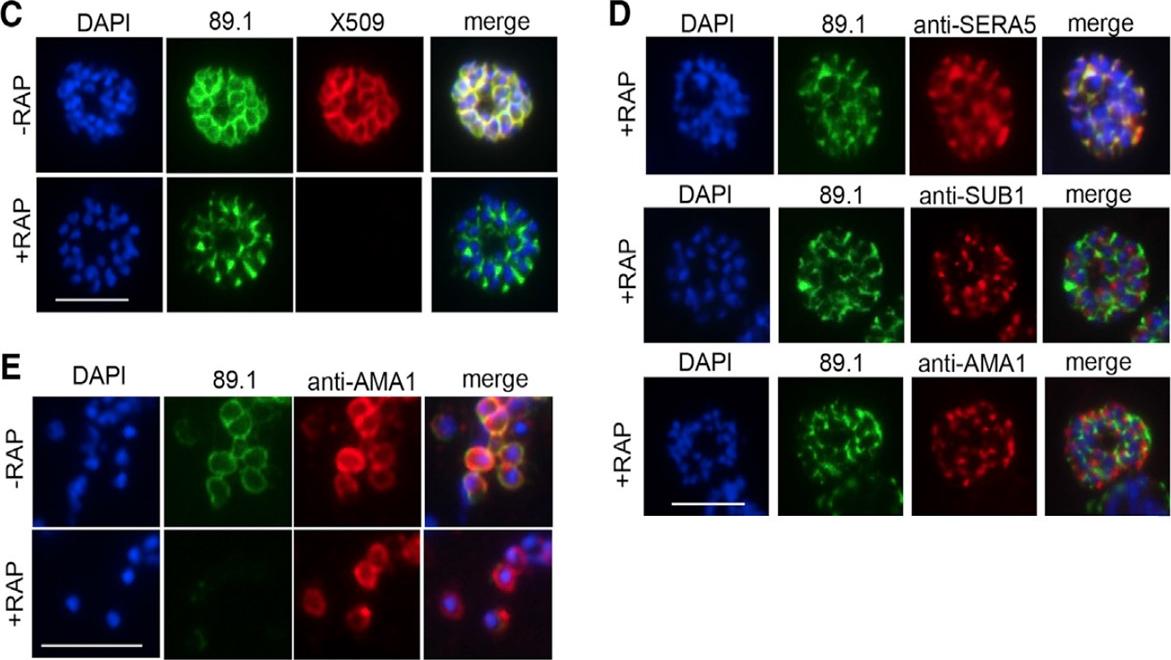
Truncation of MSP1 Produces an Egress Defect. (C) RAP treatment produces a loss of mAb X509 reactivity and a shift in the IFA pattern of MSP1 to one typical of PV proteins, consistent with the predicted truncation. Numbers of DAPI-stained nuclei did not differ between control and RAP treated schizonts (mean values: 21.2 ± 3.4 and 20.6 ± 4.0 nuclei per schizont, respectively, n = 24). (D) IFA showing co-localization of truncated MSP1 with SERA5 indicating a PV location. The punctate localization of SUB1 and the microneme protein AMA1 indicates normal organelle biogenesis. (E) IFA showing lack of surface-bound MSP1 on merozoites of RAP-treated 3D7MSP1flox42C1 clone E3. Antibodies to AMA1 (which is expressed on free merozoites) were used as a control. Analysis of RAP-treated 3D7MSP1flox42C parasites showed highly efficient excision, resulting in exclusive expression of truncated MSP1 in mature schizonts at the end of the same erythrocytic cycle (C). No effects on merozoite development were discernible. The modified MSP1 was trafficked to the PV as expected for a non-membrane bound merozoite surface protein (C–D) but was not present on the surface of free merozoites (E)Das S, Hertrich N, Perrin AJ, Withers-Martinez C, Collins CR, Jones ML, Watermeyer JM, Fobes ET, Martin SR, Saibil HR, Wright GJ, Treeck M, Epp C, Blackman MJ. Processing of Plasmodium falciparum Merozoite Surface Protein MSP1 Activates a Spectrin-Binding Function Enabling Parasite Egress from RBCs. Cell Host Microbe. 2015 18(4):433-44. PMID: 26468747
See original on MMP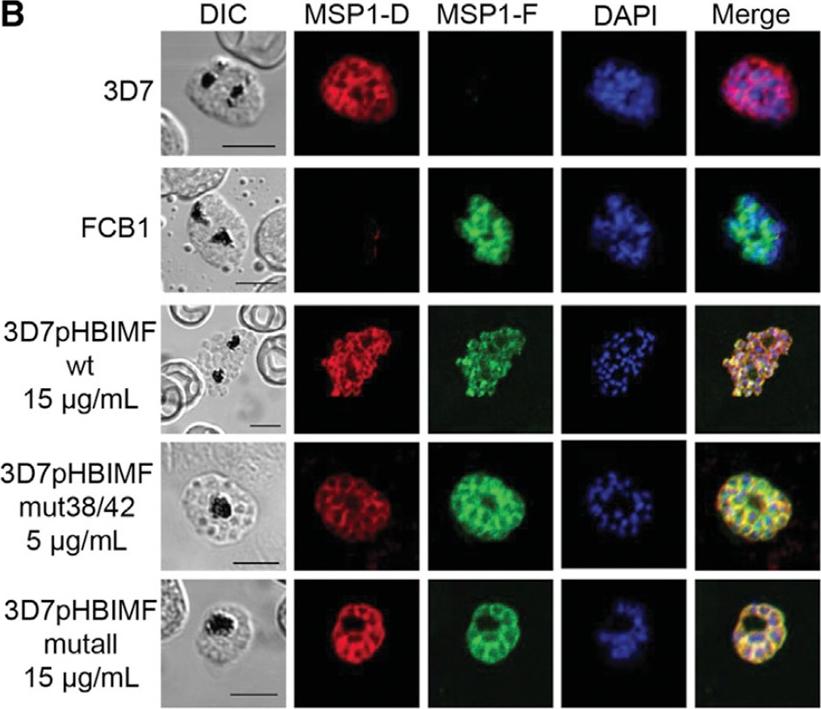
Episomal Expression of Cleavage-Resistant MSP1 Inhibits P. falciparum Growth. Immunofluorescence analysis (IFA) of parental 3D7 and FCB1 schizonts, as well as 3D7 schizonts harboring the constructs in the indicated concentrations of blasticidin. Parasites were probed with MSP1 isoform-specific antibodies. Merged signals include that of the DNA dye 4,6-diamidino-2-phenylindole (DAPI, blue). Scale bar, 5 mm. Parasites harboring a wild-type msp1-f transgene (3D7pHBIMFwt), or the same gene with mutations at all putative 38/42 sites (3D7pHBIMFmut38/42), or at all primary processing sites (3D7pHBIMFmutall), correctly expressed the transgene product on developing merozoites at all blasticidin concentrations tested.Das S, Hertrich N, Perrin AJ, Withers-Martinez C, Collins CR, Jones ML, Watermeyer JM, Fobes ET, Martin SR, Saibil HR, Wright GJ, Treeck M, Epp C, Blackman MJ. Processing of Plasmodium falciparum Merozoite Surface Protein MSP1 Activates a Spectrin-Binding Function Enabling Parasite Egress from RBCs. Cell Host Microbe. 2015 Oct 18(4):433-44.
See original on MMP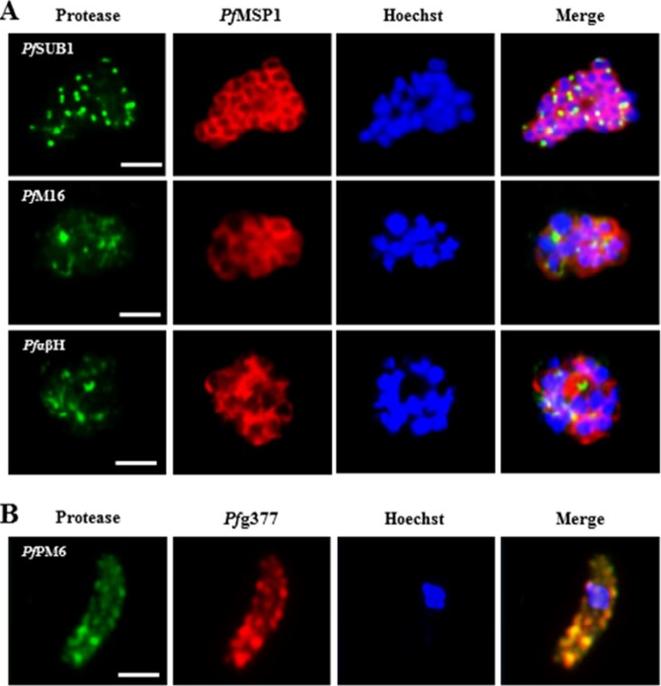
In-depth analysis of protease localization. A) IFAs using polyclonal mouse antisera directed against PfSUB1, PfαβH and PfM16 were used to investigate the granular localization of these proteases in merozoite-containing mature schizonts (in green). The merozoites were visualized via immunolabelling with polyclonal rabbit antisera directed against PfMSP1 (in red). PfM16 localized to granular structures in schizonts, which did not coincide with the merozoites B) Immunolabeling of osmiophilic bodies using polyclonal rabbit antisera directed against Pfg377 (in red) was employed to demonstrate an accumulation of PfPM6, labeled with the respective mouse antisera (in green), in these organelles. Hoechst 33342 staining was used to highlight the parasite nuclei (in blue). Bar, 2 μm. Results are representative of two independent experiments. The localization of PfPM6 in female gametocytes was don by co-localization experiments were performed, using rabbit antibodies directed against the osmiophilic body protein Pfg377. The double-labelling assays demonstrated that PfPM6 is present in these organelles.Weißbach T, Golzmann A, Bennink S, Pradel G, Julius Ngwa C. Transcript and protein expression analysis of proteases in the blood stages of Plasmodium falciparum. Exp Parasitol. 2017 Mar 25. [Epub ahead of print]
See original on MMP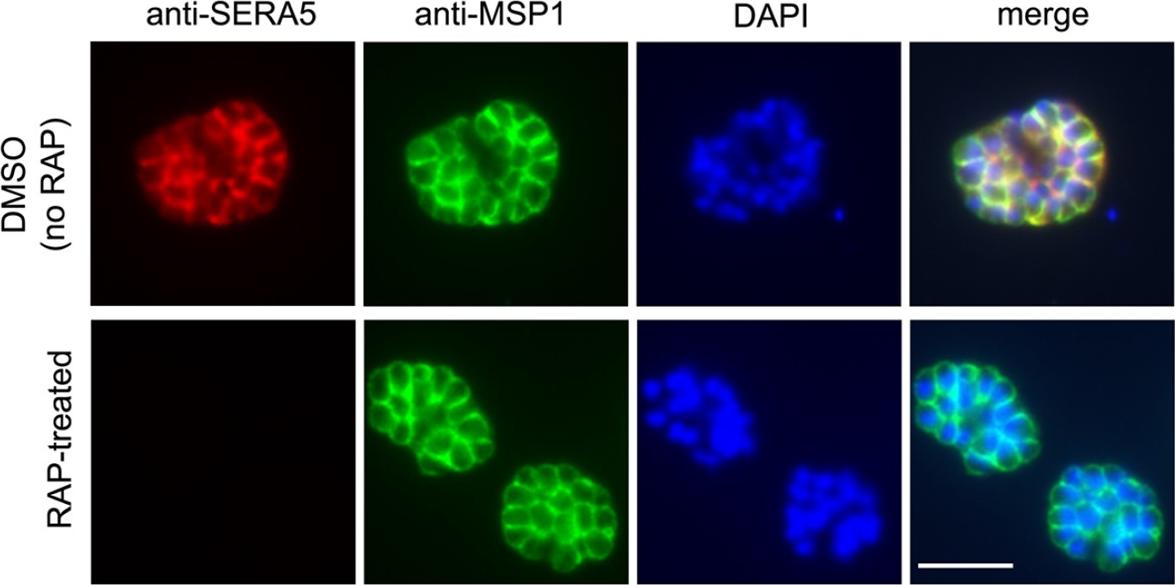
To establish the effects of SERA5 loss on parasite growth, we compared the replication rates of mock-treated and RAP-treated floxSERA5-1B6 and floxSERA5-3B6 clones, using the parental 1G5DC clone as a controlIFA of mature schizonts of control (DMSO-treated) and RAP-treated integrant clone floxSERA5-1B6 ~44 h following treatment. No SERA5-specific signal was detectable in the majority (~98%) of the rapamycin-treated population. Scale bar, 5 μmCollins CR, Hackett F, Atid J, Tan MSY, Blackman MJ. The Plasmodium falciparum pseudoprotease SERA5 regulates the kinetics and efficiency of malaria parasite egress from host erythrocytes. PLoS Pathog. 2017 13(7):e1006453.
See original on MMP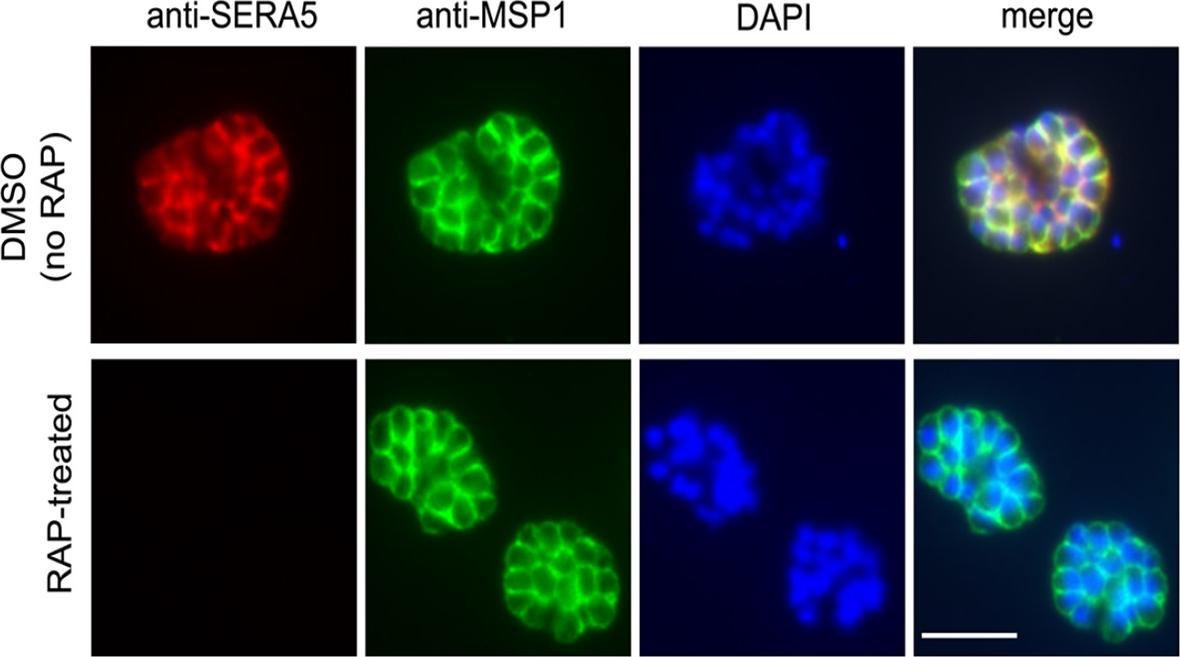
DiCre-mediated conditional disruption of P. falciparum SERA5 expression. IFA of mature schizonts of control (DMSO-treated) and RAP-treated integrant clone floxSERA5-1B6 ~44 h following treatment. No SERA5-specific signal was detectable in the majority (~98%) of the RAP-treated population. Scale bar, 5 μm. To assess the effects of SERA5 gene deletion on SERA5 protein expression, mature flox-SERA5-1B6 and floxSERA5-3B6 schizonts were examined by indirect immunofluorescence (IFA) at the end of the first erythrocytic cycle (~44 h) following RAP-treatment. No SERA5-specific signal was detectable by IFA in most of the RAP-treated floxSERA5-1B6 and flox-SERA5-3B6 schizontsCollins CR, Hackett F, Atid J, Tan MSY, Blackman MJ. The Plasmodium falciparum pseudoprotease SERA5 regulates the kinetics and efficiency of malaria parasite egress from host erythrocytes. PLoS Pathog. 2017 Jul 6;13(7):e1006453.
See original on MMP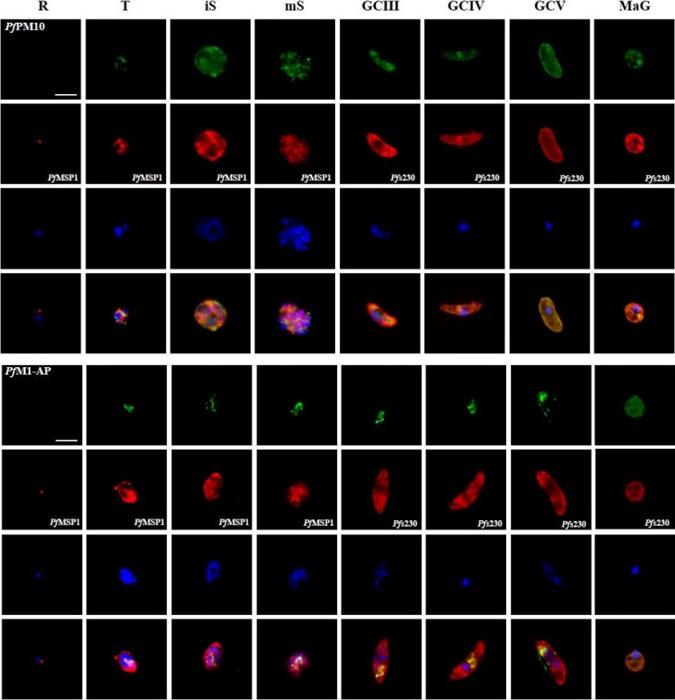
Protein expression profile of selected P. falciparum proteases. IFAs using polyclonal mouse antisera directed against 12 of the proteases was used to demonstrate protein expression in the asexual blood stages (R, ring; T, trophozoite; iS, immature schizont; mS, mature schizont) and gametocytes (GC stages III, IV and V) as well as in macrogametes (MaG) at 20 min post-activation (in green). The asexual and the sexual blood sstages were visualized via immunolabelling with polyclonal rabbit antisera against PfMSP1 and Pfs230, respectively (in red). Hoechst 33342 staining was used to highlight the parasite nuclei (in blue). Bar, 5 μm. Results are representative of three to four independent experiments.Weißbach T, Golzmann A, Bennink S, Pradel G, Julius Ngwa C. Transcript and protein expression analysis of proteases in the blood stages of Plasmodium falciparum. Exp Parasitol. 2017 Mar 25. [Epub ahead of print]
See original on MMP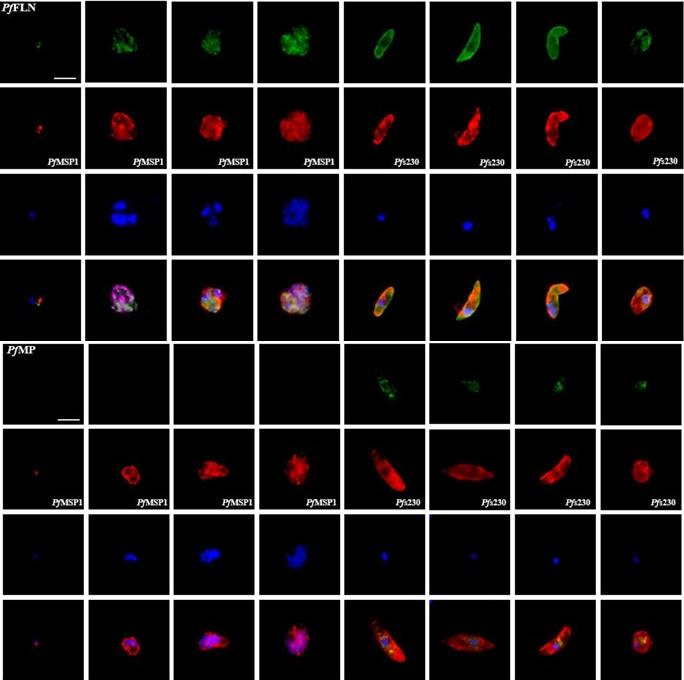
Protein expression profile of selected P. falciparum proteases. IFAs using polyclonal mouse antisera directed against 12 of the proteases was used to demonstrate protein expression in the asexual blood stages (R, ring; T, trophozoite; iS, immature schizont; mS, mature schizont) and gametocytes (GC stages III, IV and V) as well as in macrogametes (MaG) at 20 min post-activation (in green). The asexual and the sexual blood sstages were visualized via immunolabelling with polyclonal rabbit antisera against PfMSP1 and Pfs230, respectively (in red). Hoechst 33342 staining was used to highlight the parasite nuclei (in blue). Bar, 5 μm. Results are representative of three to four independent experiments.Weißbach T, Golzmann A, Bennink S, Pradel G, Julius Ngwa C. Transcript and protein expression analysis of proteases in the blood stages of Plasmodium falciparum. Exp Parasitol. 2017 Mar 25. [Epub ahead of print]
See original on MMP
Protein expression profile of selected P. falciparum proteases. IFAs using polyclonal mouse antisera directed against 12 of the proteases was used to demonstrate protein expression in the asexual blood stages (R, ring; T, trophozoite; iS, immature schizont; mS, mature schizont) and gametocytes (GC stages III, IV and V) as well as in macrogametes (MaG) at 20 min post-activation (in green). The asexual and the sexual blood sstages were visualized via immunolabelling with polyclonal rabbit antisera against PfMSP1 and Pfs230, respectively (in red). Hoechst 33342 staining was used to highlight the parasite nuclei (in blue). Bar, 5 μm. Results are representative of three to four independent experiments.Weißbach T, Golzmann A, Bennink S, Pradel G, Julius Ngwa C. Transcript and protein expression analysis of proteases in the blood stages of Plasmodium falciparum. Exp Parasitol. 2017 Mar 25. [Epub ahead of print]
See original on MMP
Protein expression profile of selected P. falciparum proteases. IFAs using polyclonal mouse antisera directed against 12 of the proteases was used to demonstrate protein expression in the asexual blood stages (R, ring; T, trophozoite; iS, immature schizont; mS, mature schizont) and gametocytes (GC stages III, IV and V) as well as in macrogametes (MaG) at 20 min post-activation (in green). The asexual and the sexual blood sstages were visualized via immunolabelling with polyclonal rabbit antisera against PfMSP1 and Pfs230, respectively (in red). Hoechst 33342 staining was used to highlight the parasite nuclei (in blue). Bar, 5 μm. Results are representative of three to four independent experiments.Weißbach T, Golzmann A, Bennink S, Pradel G, Julius Ngwa C. Transcript and protein expression analysis of proteases in the blood stages of Plasmodium falciparum. Exp Parasitol. 2017 Mar 25. [Epub ahead of print]
See original on MMP
Protein expression profile of selected P. falciparum proteases. IFAs using polyclonal mouse antisera directed against 12 of the proteases was used to demonstrate protein expression in the asexual blood stages (R, ring; T, trophozoite; iS, immature schizont; mS, mature schizont) and gametocytes (GC stages III, IV and V) as well as in macrogametes (MaG) at 20 min post-activation (in green). The asexual and the sexual blood sstages were visualized via immunolabelling with polyclonal rabbit antisera against PfMSP1 and Pfs230, respectively (in red). Hoechst 33342 staining was used to highlight the parasite nuclei (in blue). Bar, 5 μm. Results are representative of three to four independent experiments.Weißbach T, Golzmann A, Bennink S, Pradel G, Julius Ngwa C. Transcript and protein expression analysis of proteases in the blood stages of Plasmodium falciparum. Exp Parasitol. 2017 Mar 25. [Epub ahead of print]
See original on MMP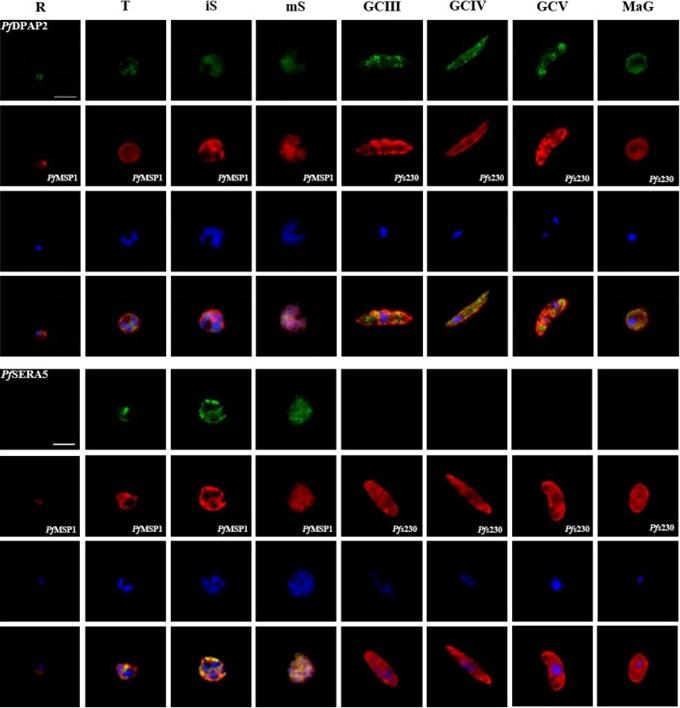
Protein expression profile of selected P. falciparum proteases. IFAs using polyclonal mouse antisera directed against 12 of the proteases was used to demonstrate protein expression in the asexual blood stages (R, ring; T, trophozoite; iS, immature schizont; mS, mature schizont) and gametocytes (GC stages III, IV and V) as well as in macrogametes (MaG) at 20 min post-activation (in green). The asexual and the sexual blood sstages were visualized via immunolabelling with polyclonal rabbit antisera against PfMSP1 and Pfs230, respectively (in red). Hoechst 33342 staining was used to highlight the parasite nuclei (in blue). Bar, 5 μm. Results are representative of three to four independent experiments.Weißbach T, Golzmann A, Bennink S, Pradel G, Julius Ngwa C. Transcript and protein expression analysis of proteases in the blood stages of Plasmodium falciparum. Exp Parasitol. 2017 Mar 25. [Epub ahead of print]
See original on MMP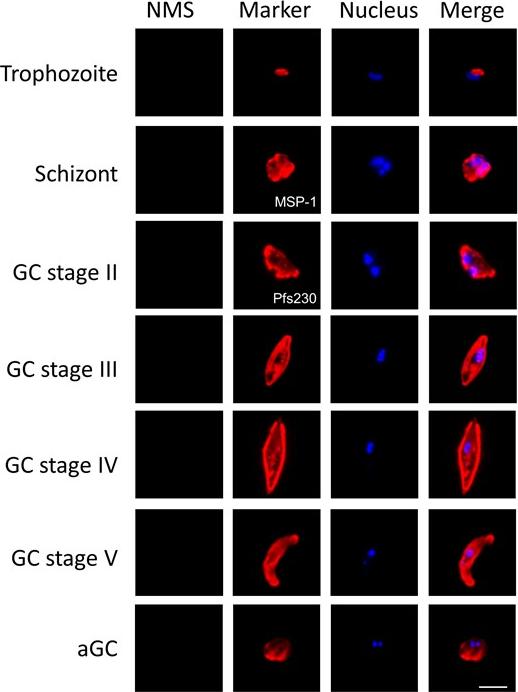
Immunolabeling control of blood stage parasite samples. Non-immunized mouse sera (NMS) were used to immunolabel fixed samples of trophozoites, schizonts and mature gametocytes (GC) as well as of activated gametocytes (aGC) at 30 min post-activation (green). Schizonts were visualized by labelling with rabbit anti-MSP1 antisera and gametocytes were visualized by rabbit anti-Pfs230 antisera (red); nuclei were highlighted by Hoechst stain (blue). Bar, 5 µm. Results shown are representative for three independent experiments.Weißbach T, Golzmann A, Bennink S, Pradel G, Julius Ngwa C. Transcript and protein expression analysis of proteases in the blood stages of Plasmodium falciparum. Exp Parasitol. 2017 Mar 25. [Epub ahead of print]
See original on MMP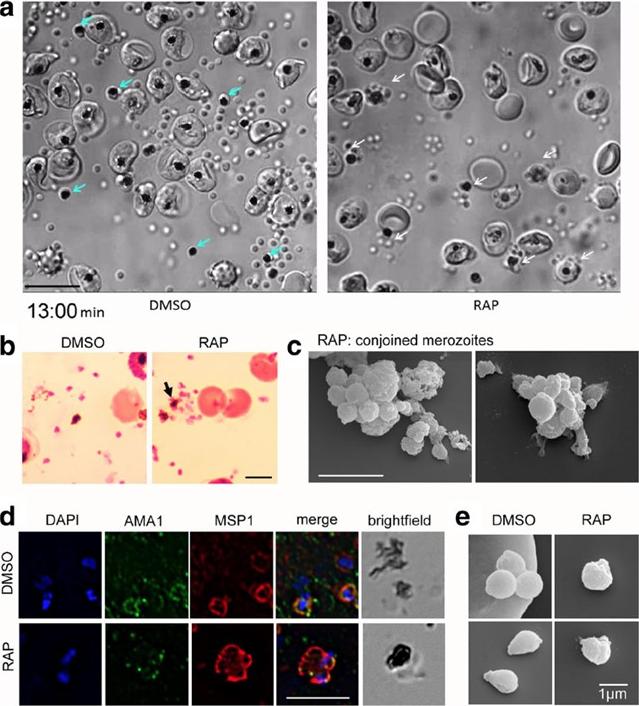
PfACT1 KO merozoites remain conjoined post-egress and possess a dysmorphic ruffled surface. a Still images from Additional file 6: Video S1show normal explosive egress in PfACT1 KOs; however, the RAP-treated population displays conjoined merozoites attached to the FV (white arrows),compared to completely segregated merozoites not attached to the FV (blue arrows) in DMSO controls. b Post-egress, Giemsa-stained RAP-treatedpopulations have parasite structures attached to the FV (black arrow). In DMSO controls, the newly released daughter merozoites are free and notconnected to the FV. Scale bar 5 μm. c Conjoined merozoites with a dysmorphic ruffled surface are apparent by SEM in the RAP-treated population. Scale bar 5 μm. d IFA on post-egress preparations of RAP-treated parasites reveals nuclei (DAPI) and micronemes (AMA1) joined to the FV, with the entire structure bounded by a contiguous plasma membrane (MSP1); defect observed in 76% of all FVs. The FV and merozoites are distinct in DMSO controls (94% of all FVs). N= 21 for DMSO and N = 33 for RAP. Scale bar 5 μm. e Free merozoites are released in the PfACT1 KO population, though they often possess a ruffled surface as observed by SEM. Scale bar 1 μm.Das S, Lemgruber L, Tay CL, Baum J, Meissner M. Multiple essential functions of Plasmodium falciparum actin-1 during malaria blood-stage development. BMC Biol. 2017 Aug 15;15(1):70.
See original on MMP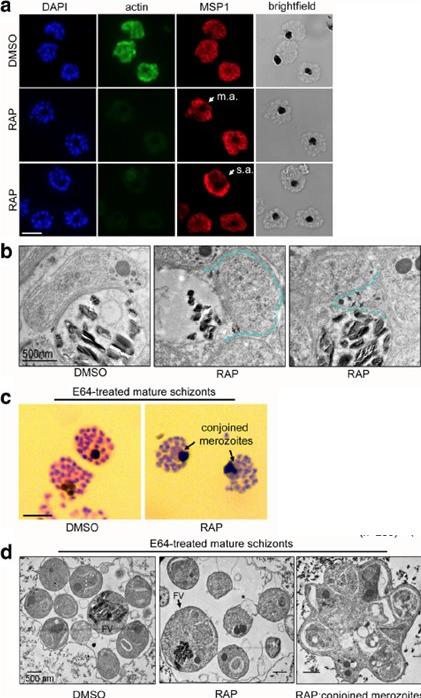
PfACT1 is required for normal cytokinesis. a IFA of PfACT1 KO and control schizonts. Aberrant staining of the plasma membrane marker MSP1 (red) depicts dysmorphic merozoites in the schizonts (white arrow) in the absence of PfACT1 (actin). Scale bar 5 μm. Normal, moderately aberrant (m.a.), and severely aberrant (s.a.) MSP1 staining has been exemplified (white arrows). b TEM on C1-treated mature schizonts stalled just prior to egress. Whilst medially resident daughter merozoites have distinct, separated membranes apposed to the FV membrane in DMSO controls (black arrows), aberrant membranous pockets including merozoite material are observed in RAP-treated parasites (double black arrows and outlined by blue dotted line). c Giemsa-stained, E64-treated mature schizonts show conjoined merozoites (black arrows) with ~50% frequency in the RAP-treated sample as compared to <10% in DMSO controls.. d TEM of E64-trapped merozoites. Merozoites in DMSO controls are distinct and well formed, with organelles not included within the FV membrane (left panel). The RAP-treated population has FVs (black arrow) which include organelles normally resident in daughter merozoites. Some merozoites show aberrant surface architecture (asterisked). Merozoites conjoined to each other are frequently seen in the PfACT1 KO population (right panel). TEM scale bar 500 nm. Other scale bars 5 μm.Das S, Lemgruber L, Tay CL, Baum J, Meissner M. Multiple essential functions of Plasmodium falciparum actin-1 during malaria blood-stage development. BMC Biol. 2017 Aug 15;15(1):70. PMID: 28810863
See original on MMP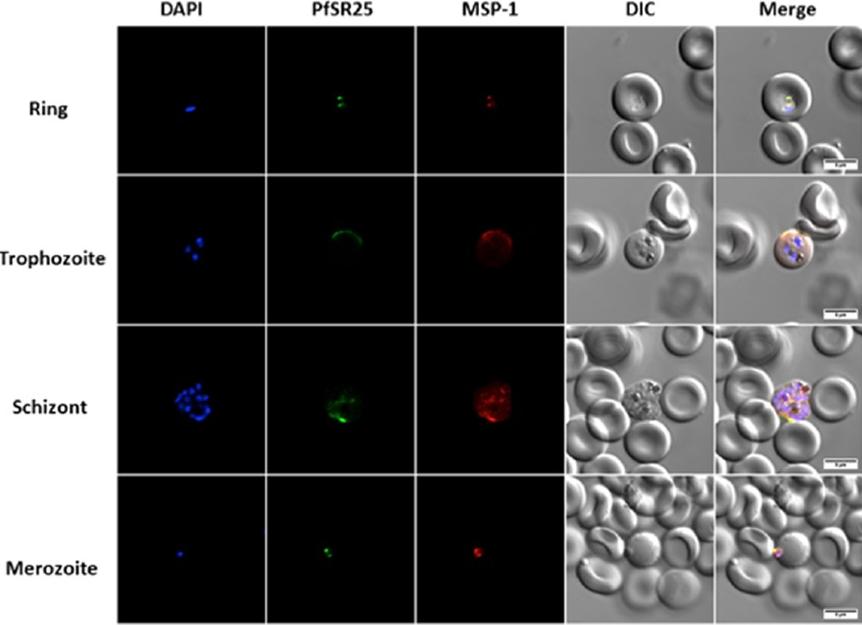
Intraerythrocytic expression of PfSR25 and gene disruption. IFA of PfSR25 during erythrocyte stages was done at ring; trophozoite; schizont and merozoite stage. PfMSP1 was used to confirm the co-localization of SR25. PfSR25 was clearly detected in RBC infective parasite stage, i.e. the merozoite. Co-localization with Plasmodium surface protein MSP-1 reveals that SR25 expression at parasite membrane.Moraes MS, Budu A, Singh MK, Borges-Pereira L, Levano-Garcia J, Currà C, Picci L, Pace T, Ponzi M, Pozzan T, Garcia CRS. Plasmodium falciparum GPCR-like receptor SR25 mediates extracellular K(+) sensing coupled to Ca(2+) signaling and stress survival. Sci Rep. 2017 7(1):9545.
See original on MMPMore information
| PlasmoDB | PCHAS_0831300 |
| GeneDB | PCHAS_0831300 |
| Malaria Metabolic Pathways | Localisation images Pathways mapped to |
| Previous ID(s) | PC000255.03.0, PC000430.04.0, PC000625.03.0, PC302437.00.0, PCAS_083080, PCHAS_083130 |
| Orthologs | PBANKA_0831000 , PF3D7_0930300 , PKNH_0728900 , PVP01_0728900 , PVX_099980 , PY17X_0834400 |
| Google Scholar | Search for all mentions of this gene |